
Nature’s Comebacks—And What’s Still Possible
In its first 50 years, the U.S. Endangered Species Act has played a major role in conserving rare plants and animals in every state. Take a moment to celebrate its success where you live.
April 12, 2023 | Last updated May 07, 2025
Endangered, threatened and recovering U.S. species
It took millions of years for the spectacular variety of life to evolve on the North American landscape, influenced by everything from geography to soils to climate and the stewardship of Indigenous Peoples. The complex and interconnected web of life on Earth is dwindling fast, but there is still hope.
The U.S. Endangered Species Act has shown the power of conservation through policy. Now in its fifth decade, the act is one tremendous example of ways that sound and reasonable policies can provide a safety net for nature. And when nature is healthy, we’re healthy.
Speak Up For Nature Today.
Our natural world has reached a breaking point, and there's no time to lose to create a more livable future. Urge elected leaders to put saving nature on the agenda.

Facts About the Endangered Species Act
- The U.S. Endangered Species Act was signed into law by President Richard Nixon on December 28, 1973, with overwhelming bipartisan support.
- The act currently protects 1,662 U.S. species and 638 foreign species.
- The act has helped recovery efforts of the American bald eagle, American alligator, whooping crane and many other iconic species.
- 84% of Americans support the Endangered Species Act.
In the early 1970s, a growing number of people from all walks of life saw the threats to nature—but they also saw hope, and they spoke up. Along with their awareness and activism came a wave of policy actions aimed at safeguarding air, water and biodiversity. Among those actions was the Endangered Species Act, which was signed into law on December 28, 1973.
The Endangered Species Act has proven to be one important tool to help rare species in the United States recover. The act has played a role in the comebacks of many species you see below.
The act isn't perfect, and threats to biodiversity remain. Many actions are needed to deliver the right policies, funding, and science to address the twin crises of climate change and biodiversity loss in the U.S. and abroad. The Recovering America’s Wildlife Act is one measure Congress can pass to help keep common species common and prevent others from becoming rare. The U.S. could work toward greater biodiversity protection both domestically and internationally. It could also continue with its America the Beautiful initiative to conserve and restore 30% of the country's lands and waters by 2030.
We know what success can look like. We know—from the Endangered Species Act and many other initiatives to restore habitat and wildlife—that species can make a comeback. Here are just a few.
Endangered & Recovering Species in Eastern States
Select the photos to discover more about plants and animals in your state and across the country!

Connecticut
Peregrine falcon, Falco peregrinus
The peregrine falcon is a crow-sized bird that can be found on every continent except Antarctica, making it one of the most widely distributed raptors in the world. It catches its prey—mainly small birds—in midair after diving from great heights. During these dives, a peregrine falcon may reach speeds of more than 200 mph, making it the fastest animal on the planet.
Range:
Peregrine falcons can be found along shorelines, cliffsides, mountains, river valleys, and cities across the globe.
Where to see:
In Connecticut, peregrine falcons can be found along the coast and in cities like Hartford, New London, and Bridgeport, where they nest on tall structures.
Conservation approach:
Like many raptors, peregrine falcon populations suffered steep declines due to the use of the pesticide DDT, which caused thinning of their eggshells. The population collapse was successfully reversed through captive breeding programs across the country. Peregrines had disappeared from Connecticut until 1997, when birds bred as part of a reintroduction project in New York relocated across state lines.
Significance for habitat/biodiversity:
Peregrine falcons prey on small to medium birds and insects. They are noteworthy for having adapted especially well to living in cities, where they prey on pigeon populations.
Learn more:
Connecticut DEP peregrine falcons
Connecticut Audubon peregrine falcons
Reviewed by Shelley Green, Director of Conservation Programs, The Nature Conservancy in Connecticut and Holly Drinkuth, Director of River and Estuary Conservation, The Nature Conservancy in Connecticut.
Photo Credit: Janet Haas

Delaware
Hessel's Hairstreak Butterfly
The Hessel’s hairstreak butterfly, known for its iridescent green-speckled wings, is considered endangered in Delaware. In 2022, Dr. Kitt Heckscher of Delaware State University observed one of these rare beauties at a TNC preserve in southern Delaware, marking the first recorded sighting in over 27 years.
Range:
Atlantic Coast, southern Maine to Florida
Where to see:
Southern Delaware
Conservation approach:
The Hessel’s hairstreak primarily relies on Atlantic white cedar swamps, and these wetlands are increasingly threatened due to centuries of development, land conversion and sea level rise accelerated by climate change. In 2023, the state’s largest Atlantic white cedar tree was discovered at Ponders Tract within TNC’s Pemberton Forest preserve. TNC manages and protects Delaware’s lands and waters, using science as the foundation for ensuring the long-term health of the state’s unique and irreplaceable biodiversity.
Significance for habitat/biodiversity:
“In addition to Hessel’s hairstreak, many more rare and threatened plants and animal species can be found in Atlantic white cedar swamps. It’s essential that we continue to protect and restore these critical ecosystems,” said Natasha Whetzel, Delaware Stewardship Manager at TNC.
Reviewed by Natasha Whetzel, Delaware Stewardship Manager.
Photo Credit: Garry Kessler
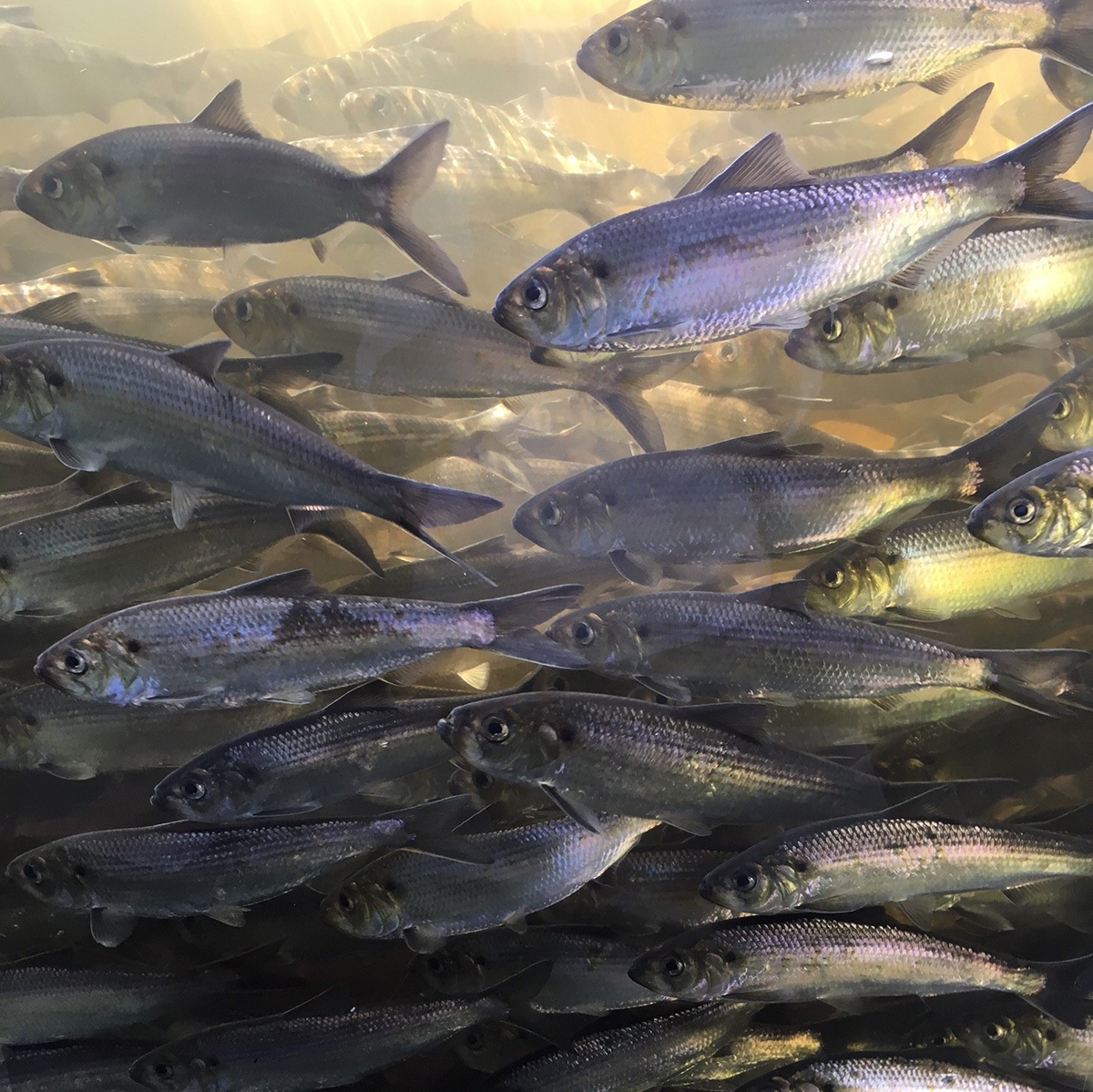
Maine
Alewife, Alosa pseudoharengus
Like all herring species, the alewife is an anadromous fish—it spawns in freshwater, migrates to the ocean for its adult life, and swims back upstream to reproduce in fresh water. Each spring, alewives migrate in huge numbers up rivers and streams to spawn, a life cycle that nourishes many other species and has provided Indigenous Peoples with food for thousands of years.
Range:
Atlantic coastal rivers from Labrador to South Carolina. Alewives have has been introduced into a number of Great Lakes waters as non-native species.
Where to see:
There are now a multitude of places to see migrating alewives along the coast of Maine, for example the Damariscotta Mills Fish Ladder Restoration in Nobleboro and Newcastle, usually from mid-May through early June. Also, check out the Maine Alewife Trail Map.
Conservation approach:
TNC, along with many partner organizations and state and federal agencies, have worked in recent decades to remove barriers to the migration of alewives and other native sea-run fish so that their populations can once again become self-sustaining. Alewives co-evolved with Atlantic salmon and have benefited from, and play an important role in efforts to restore federally endangered salmon in Maine. Removing dams and replacing under-sized culverts have allowed alewives to stage a spectacular comeback to rivers and streams throughout New England, especially in Maine. There are now rivers in Maine that support runs well over 5.5 million fish annually!
Significance for habitat/biodiversity:
Restoring river connectivity has not only helped alewives return to their native waters, it has helped other sea-run fish, such as blueback herring, Atlantic salmon, American shad and American eel. Their collective comebacks also benefit predators, such as river otters, bald eagles, osprey, and striped bass, among others. Healthy alewife numbers in Maine rivers have allowed a revitalization of a long tradition of spring harvests for food and lobster bait.
Reviewed by Molly Payne Wynne, Maine Freshwater Program Director.
Photo Credit: Bridget Edmonds/TNC
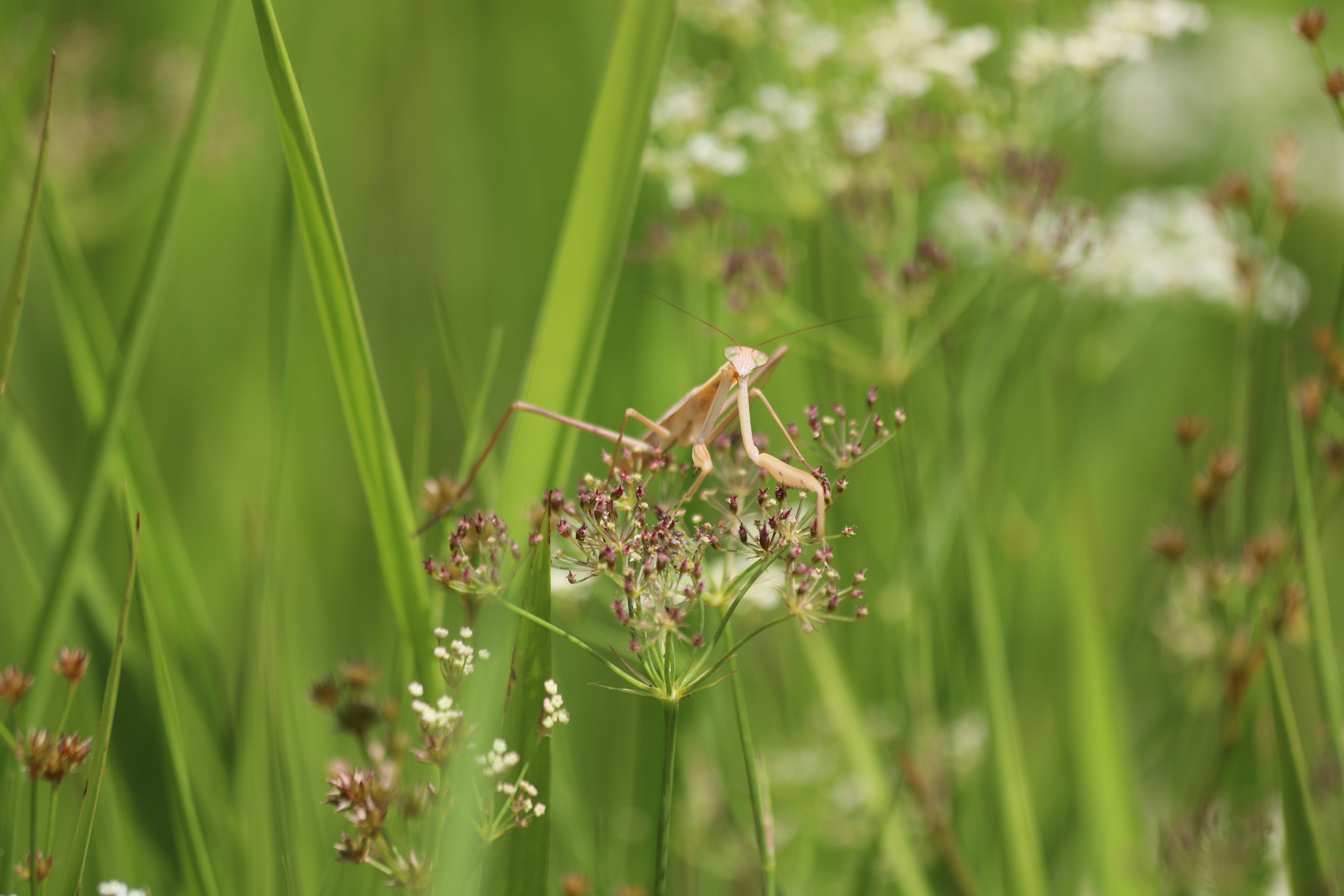
Maryland
Canby’s dropwort, Oxypolis canbyi
Canby’s dropwort is a perennial forb belonging to the mint family. The "quill-like" hollow leaves and the thick, corky wings that extend out from the margins of the fruit are the most distinctive features of the plant. It was listed as federally endangered in 1986 and has continued to decline as seasonal wetlands in its native range have been drained for commercial and agricultural development.
Range:
The historical range included Delaware, Maryland, North Carolina, South Carolina and Georgia. Today, only 25 populations are known to exist within this historical range.
Where to see:
This plant grows in Coastal Plain habitats, including pond cypress savannas, wet meadows, and depressional wetlands. The only known population of Canby’s dropwort in the state of Maryland is located on TNC’s Crescent Preserve, located in Dorchester County, Maryland. Due to the fragility of this ecosystem, the exact location of the preserve is not advertised, and the preserve is closed to the public.
Conservation approach:
TNC has documented the effects of reintroducing fire to the only population of Canby's dropwort in Maryland, found on TNC's Crescent Preserve, and monitored the resulting population increase. After cutting woody vegetation, 3.74 times more stems of dropwort per year were produced over the baseline of no intervention. Subsequently, after fire was reintroduced, 10.80 times more dropwort stems per year were produced in comparison to the time period after cutting woody vegetation. The prediction showed that in the absence of intervention with fire, dropwort stem production would likely have declined.
Significance for habitat/biodiversity:
Canby’s dropwort is an indicator species for the diminishing presence of seasonal wetlands and the many species that call those ecosystems home. Tracking their population health can help scientists better understand the conservation strategies that are best suited to their unique habitat types.
Reviewed by Deborah Landau, PhD, Director of Ecological Management, Maryland/DC chapter.
Photo Credit: Gabriel Cahalan
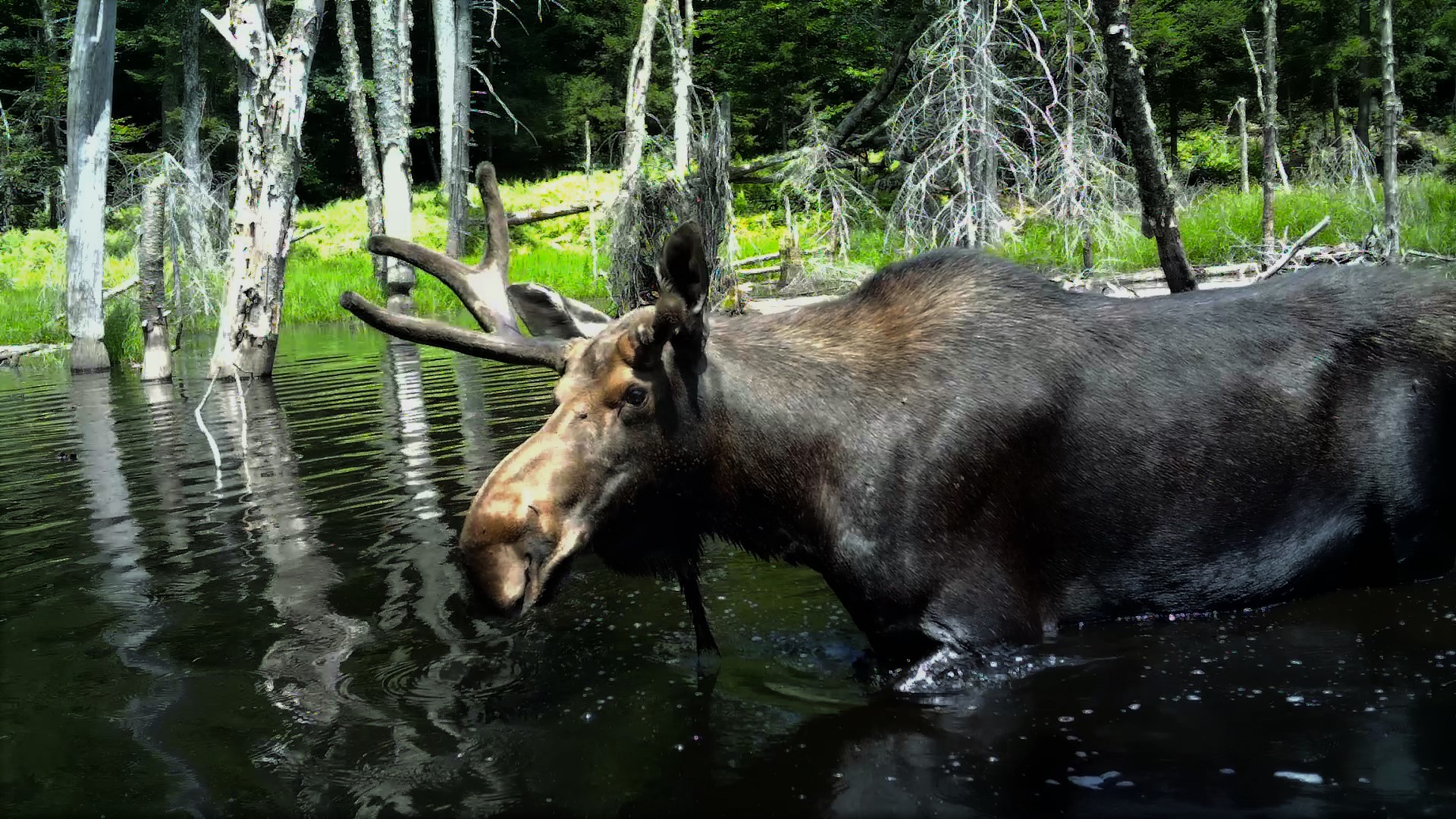
Massachusetts
Moose, Alces alces
Historically, moose roamed the forests of Massachusetts, but by the mid-1800s, forest clearing and unregulated hunting led to their disappearance. Moose began to return to Massachusetts around the 1980s, expanding south from neighboring states. Thanks to the conservation of forested landscapes, there are now nearly 1,000 moose in western and central Massachusetts.
Range:
Moose are found across North America from the maritime provinces in eastern Canada to the western edge of Alaska, and south into the northern United States. They reach the southern edge of their range in Massachusetts.
Where to see:
TNC’s Coles Brook Preserve is an ideal location for moose, with a mosaic of forest and wetland habitat. Nearby October Mountain State Forest and the 100,000 acres of forest surrounding the Quabbin Reservoir, metro Boston’s water supply, have abundant moose.
Conservation approach:
Conserving large and intact landscapes across Western and Central Massachusetts is critical to ensuring resilient moose populations in Massachusetts. These diverse landscapes allow moose to find suitable habitat as the climate changes. Addressing climate change is critical, as moose at the southern edge of their range suffer from warmer temperatures in both summer and winter. Supporting the ability of moose to safely cross roads will enhance their viability and public safety as well.
Significance for habitat/biodiversity:
Because moose in Massachusetts are at the southern edge of their range, moose adapted to this climate may be best suited to cope with the impacts of climate change. Moose browsing of trees and shrubs keeps wetland and upland habitats open for grasses, wildflowers and species that depend on these habitats.
Learn more:
Moose in Massachusetts
Reviewed by Andy Finton, TNC’s senior conservation ecologist in Massachusetts.
Photo Credit: Sally Naser
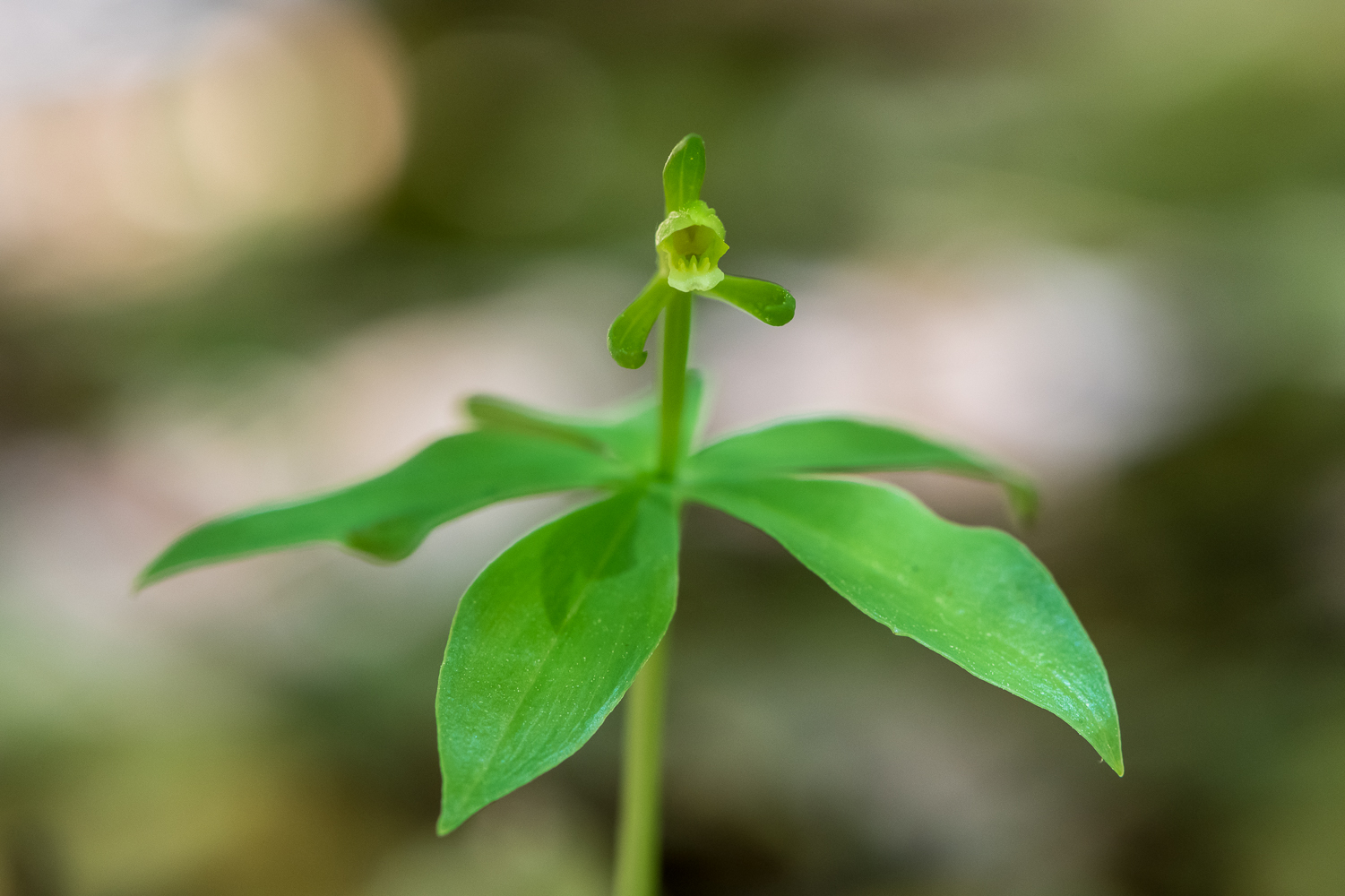
New Hampshire
Small whorled pogonia, Isotria medeoloid
This rare and delicate orchid is native to the Appalachian Mountains and the Great Lakes region. It has very specific habitat needs, living in very small populations (sometimes only a few dozen stems) in hardwood and conifer-hardwood forests.
Range:
Southern Maine south to Georgia, west to southern Ontario, Michigan and Tennessee.
Where to see:
Several TNC preserves in New Hampshire protect populations of small whorled pogonia and its habitat. As this species is an orchid and vulnerable to plant collectors, we do not cite its locations.
Conservation approach:
Because some populations in New Hampshire are quite large, the state is key to conservation efforts. TNC has played an important role by supporting the US Fish and Wildlife Service and other conservation partners in identifying populations and protecting the plant’s habitats. Scientists have also studied forest dynamics that can benefit or harm small whorled pogonia populations. In 1994, its designation under the Endangered Species Act changed from endangered to threatened.
Significance for habitat/biodiversity:
Among the main threats to this rare orchid are conversion of its forest habitat to development, forest canopy closure, and collectors who dig them up. Researchers are studying the relationships of small whorled pogonia with fungi and pollinators, an example of the many nuanced interconnectedness of species and ecosystems.
Reviewed by Jeff Lougee, TNC’s director of land management in New Hampshire.
Photo Credit: Jeff Lougee/TNC
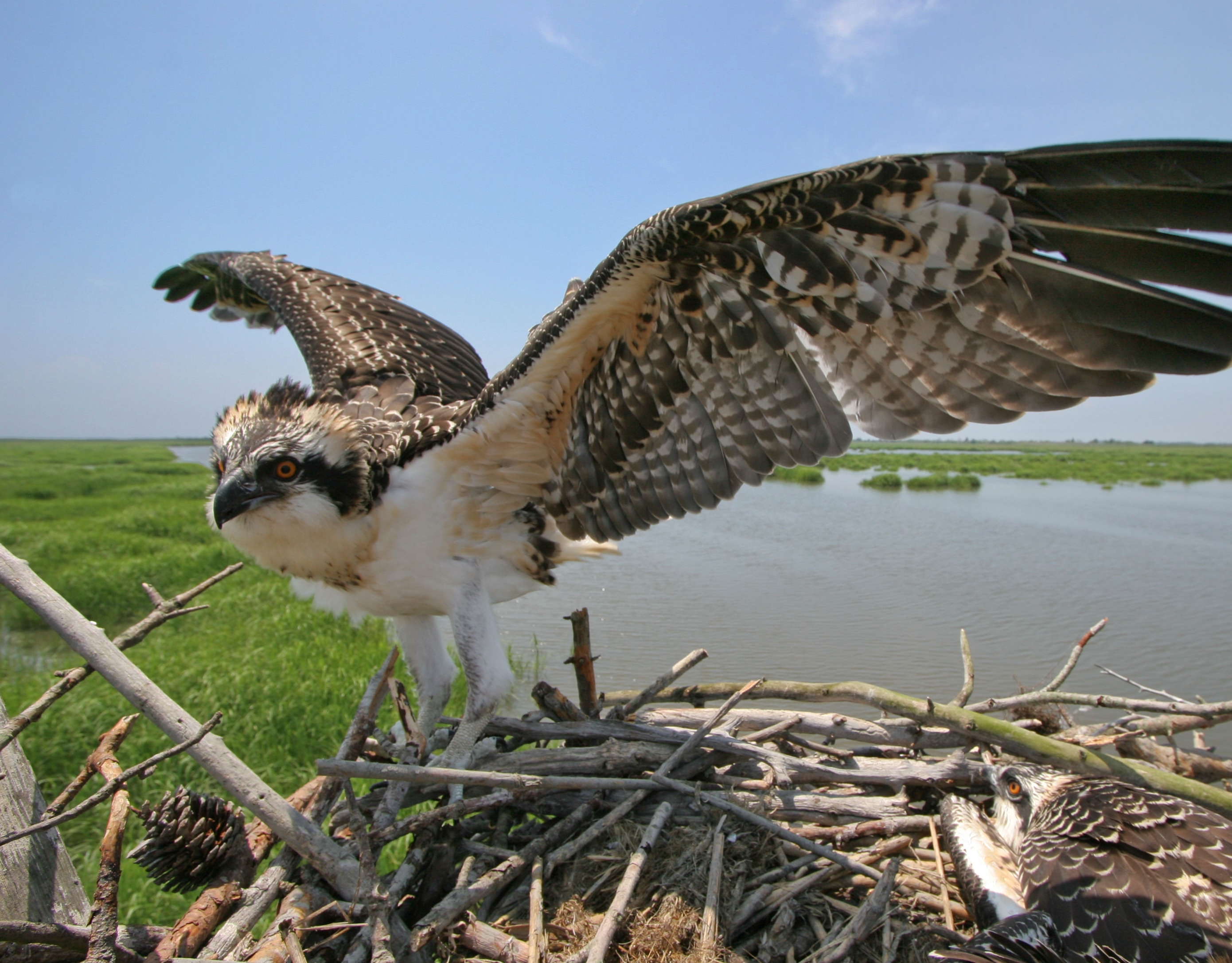
New Jersey
Osprey, Pandion haliaetus
Ospreys, or “fish hawks,” are large raptors that migrate to New Jersey’s coastal salt marshes to breed and raise young every summer. Dark brown on their backs and wings, and light beige on the rest of their bodies, these birds have reversible toes with sharp talons to catch their favorite meal—fish.
Range:
Found on all continents except Antarctica. In North America, osprey range extends from Alaska to Baja California, and along the Atlantic coast from Labrador to Florida.
Where to see:
TNC’s South Cape May Meadows Preserve in New Jersey is home to a nesting osprey pair with their own seasonal streaming camera.
Conservation approach:
Banning DDT, adding the species to the New Jersey state endangered list and building nesting platforms to replace lost habitat allowed ospreys to rebound from a nadir of just 53 nesting pairs in the early 1970s to population numbers beyond historic levels—706 nesting pairs in the most recent (2021) census. TNC’s NJ team supports ospreys today through banding, monitoring, data collection, nesting platform maintenance and raising awareness through communications.
Significance for habitat/biodiversity:
Ospreys maintain healthy fish populations and, because they are sensitive to contaminants, are environmental indicators for the condition of rivers, bays and estuaries relied upon by other wildlife and people.
Reviewed by Eric Olsen, TNC’s director of conservation in New Jersey.
Photo Credit: TNC
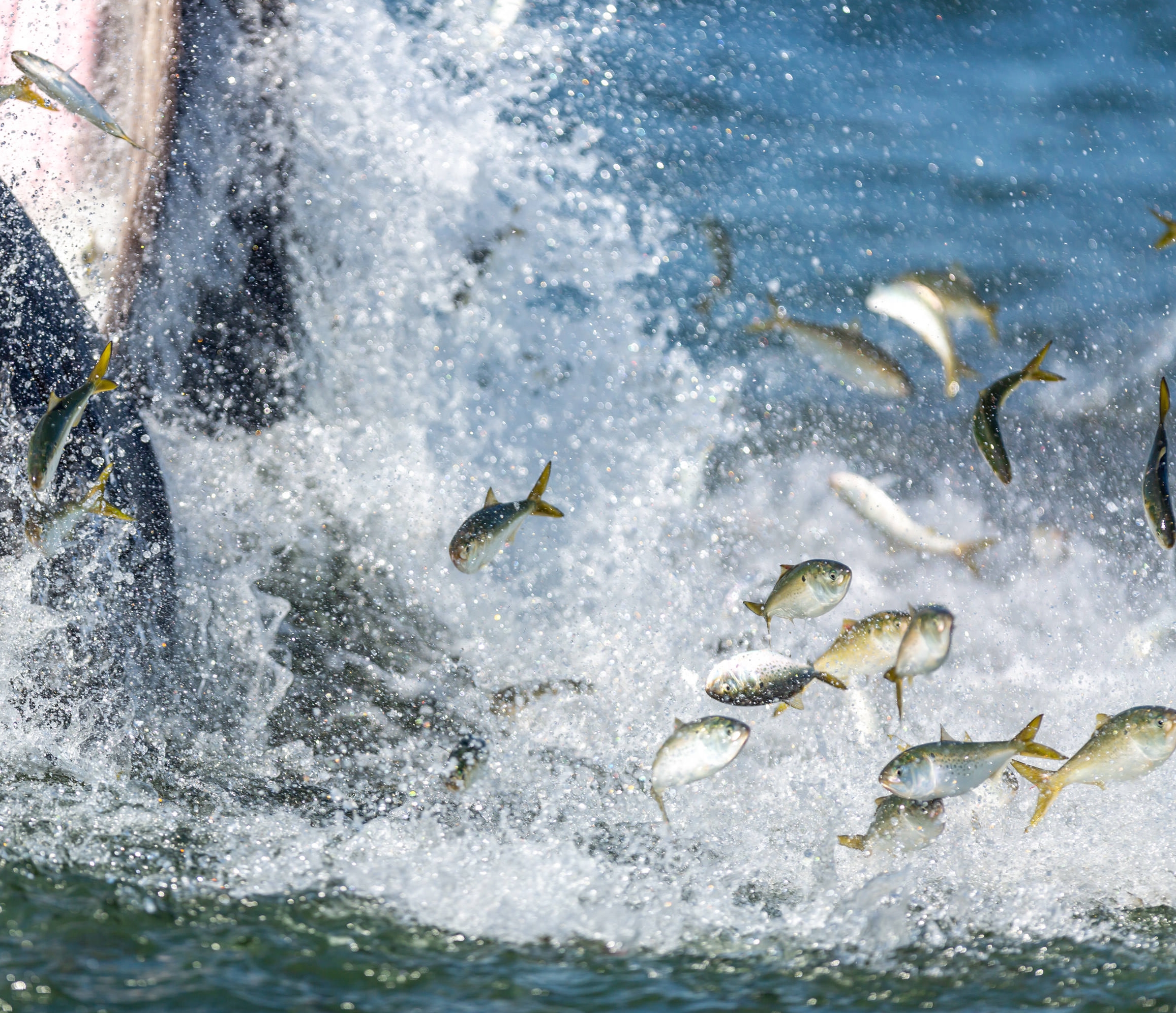
New York
Atlantic menhaden, Brevoortia tyrannus
Also known as pogy, mossbunker or bunker, the Atlantic menhaden is a tiny fish essential to the diets of much larger fishes including striped bass, bluefish and tuna, as well as marine mammals like whales and dolphins. Often called “the most important fish in the sea,” this keystone species is essential for people and wildlife—a healthy ocean and a strong coastal economy both depend on plentiful menhaden.
Range:
Coastal waters from Canada to northern Florida.
Where to see:
Years of hard work and collaboration by a diverse coalition of fishers, scientists and environmental advocates, including The Nature Conservancy, helped to set harvest limits on menhaden. Since then, the menhaden population has rebounded along the East Coast.
Conservation approach:
The Atlantic menhaden fishery was basically unregulated until 2012, when harvest limits were first set in response to declines in the menhaden population. Since that regulation went into effect, the menhaden population has been rebounding and expanding back into their historic range. This was a huge step forward that came about after many years of collaboration and advocacy by many groups, including TNC staff in New York, Virginia, and other regions along the East Coast.
In New York, our team then worked to pass a state law in 2019, protecting menhaden and the animals, fisheries, and whale watching businesses that rely on menhaden being abundant, from purse seine fishing while they are in New York waters (all estuaries and out to 3 miles in the Atlantic).
Thanks to the combined efforts of marine biologists, recreational anglers, bird watchers, whale enthusiasts and commercial fishermen, the Atlantic States Marine Fisheries Commission’s Atlantic Menhaden Management Board unanimously voted to change how it manages the fishery in 2020. By adopting a holistic approach that takes the health of the surrounding ecosystem into account, these regulations have helped to grow a resurgence of menhaden over the last several years.
Significance for habitat/biodiversity:
Menhaden eat by filtering tiny plants and particles from the water, a process Carl LoBue, TNC’s New York oceans and fisheries director, describes as “turning sunlight into whales.” Thanks to menhaden, whales have returned to New York Harbor, offering New Yorkers and tourists from around the world breathtaking sights and an inspiring connection to nature.
New York now has thriving whale watching businesses, and dolphins chasing menhaden along New York and New Jersey beaches has almost become expected. In Maine, where menhaden used to arrive in refrigerated trucks from the Mid-Atlantic to be used as bait for the highly valued lobster fishery, they now arrive swimmingly by their own accord.
With whales returning to the busy waters off New York, the need has shifted to how to address important questions concerning vessel traffic and their safety, a dialogue that TNC is currently engaged in.
Learn more:
Video: Foraging the High Seas
NOAA Species Directory: Atlantic Menhaden
Reviewed by Carl LoBue, Oceans and Fisheries Director, The Nature Conservancy in New York.
Photo Credit: Artie Raslich
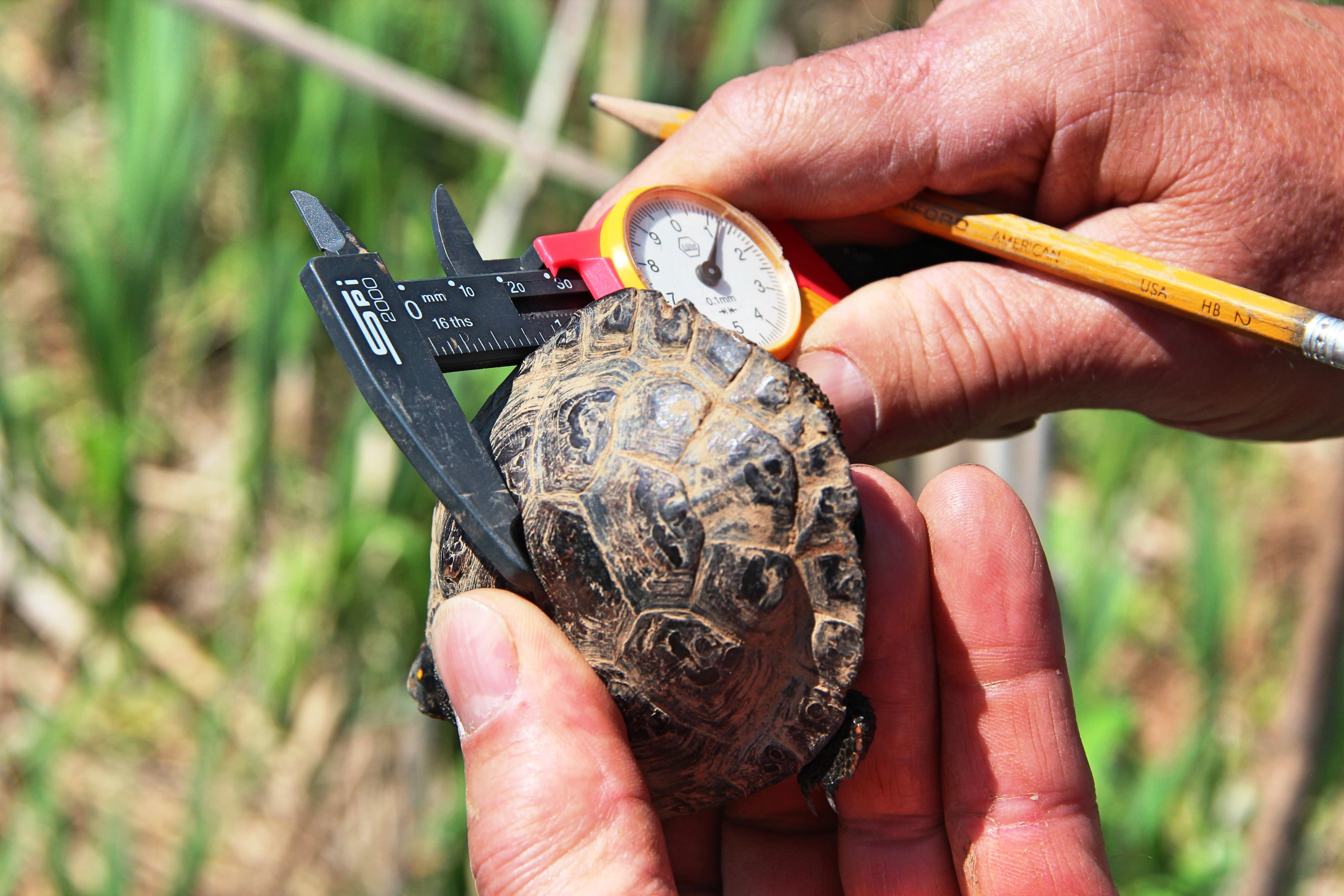
Pennsylvania
Bog turtle, Glyptemys muhlenbergii
The bog turtle is one of North America’s smallest turtles, measuring about 3 to 5 inches long with distinctive yellow-orange spots on each side of its head. Bog turtles thrive in isolated wetlands with acidic, wet soil, thick moss and deep layers of mud. Once ubiquitous in the eastern United States, the bog turtle is now federally threatened nationally and endangered in Pennsylvania due to widespread habitat degradation.
At TNC’s Acopian Preserve in southeastern Pennsylvania, spring-fed mountain streams form soft, muddy wet meadows that contain clumps of grassy tussock sedges and other low-lying vegetation. It’s combination of natural elements creates ideal habitat for bog turtles.
Range:
Two distinct populations: the first in New York, Connecticut, western Massachusetts, Pennsylvania, Delaware, and Maryland; the second in parts of Virginia, North Carolina, and Georgia.
Where to see:
TNC’s Acopian Preserve in Pennsylvania. Note: the location of this preserve is not disclosed to the public due to fragile habitat and elevated risk of poaching turtles for the illegal pet trade.
Conservation approach:
Over the years, TNC has implemented prescribed burns, cleared trees, returned grazing to the landscape with cattle and goats, and conducted annual surveys and a radio telemetry study that documented bog turtle locations, hibernation, travel patterns and habitat use within the preserve. A small group of turtles residing in the preserve have been tagged with small, computerized chips to help with tracking, monitoring and managing populations throughout their life cycle.
Significance for habitat/biodiversity:
The bog turtle has biological and cultural significance as one of the smallest turtles in the United States. The overall population also serves as a litmus test for the health of wetland areas generally, since the turtles are directly impacted by tall invasive plant species that block out adequate sunlight for basking. The turtles at the Acopian Preserve have been the subject of study since 1969. In the 2020 field season, two bog turtles were captured that were determined to be at least 62 years old. In the 2022 field season a 57-year-old bog turtle was captured. These are the oldest documented bog turtles anywhere in their range.
Learn more:
Endangered Bog Turtle Monitoring with The Nature Conservancy
Reviewed by Keith Fisher, Director of Conservation, TNC Pennsylvania and Delaware.
Photo Credit: Gates Rhodes
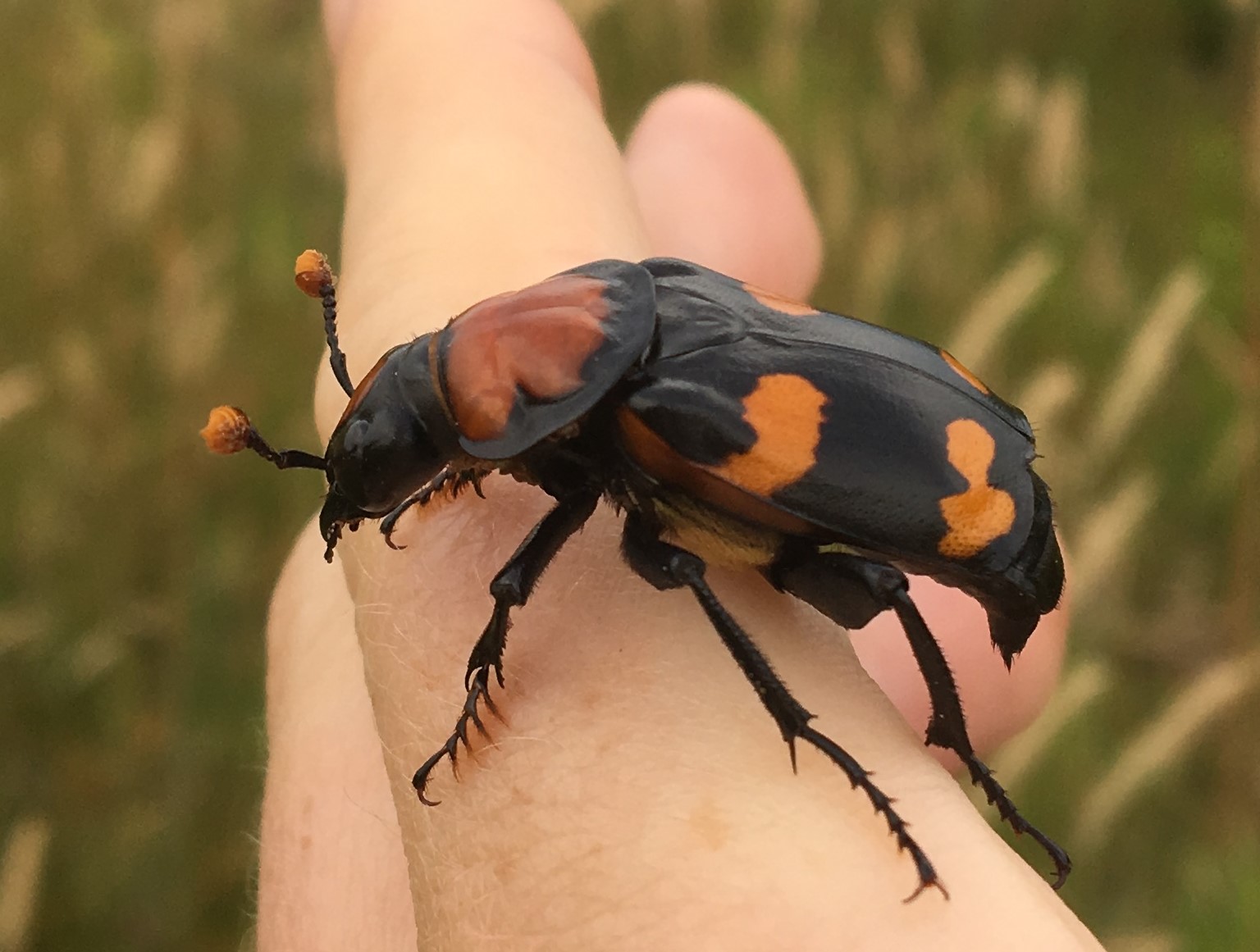
Rhode Island
American burying beetle
Nicrophorus americanus
Known as “nature’s undertaker,” the American burying beetle is the largest carrion beetle in North America, easily identified by its size and striking orange and black markings. Typically found in open fields and grasslands, they show a high degree of parental oversight while raising their young, much like honeybees.
Range:
They were once common from Maine to Texas, but now the only naturally occurring population east of the Mississippi River is found on Block Island, Rhode Island. Scattered populations are found in South Dakota, Nebraska, Kansas, Oklahoma, and Arkansas.
Where to see:
Several TNC preserves on Block Island protect the American burying beetle and its habitat. As this species is a large, charismatic beetle and vulnerable to collectors, we do not cite specific locations.
Conservation approach:
The beetles were thought extinct by the 1980s, but rediscovered on Block Island and put on the endangered species list in 1989. TNC has worked with state and federal partners since 1991 to conserve critical habitat on the island. The population is stable, but dependent on habitat management and direct human intervention (providing quail carcasses). The Block Island beetles provide a source population to recolonize other locations in the eastern U.S. In 2020, they were “downlisted” to threatened.
Significance for habitat/biodiversity:
A nocturnal insect, the American burying beetle is threatened by light pollution, pesticide use, habitat loss, and competition for carrion. Its sharp decline followed the disappearance of the passenger pigeon, whose chicks served as carrion. Scientists have found that 30% of all American burying beetle broods now rely on ring-necked pheasants, gamebirds that were introduced as the passenger pigeon was going extinct.
Learn more:
American Burying Beetle Recovery Program—Roger Williams Park Zoo
R.I. state insect moved off endangered species list, but not everyone sees it as a victory, Providence Journal, 9/3/20
Reviewed by Scott Comings, TNC’s associate state director in Rhode Island.
Photo Credit: Clair Comings

Vermont
Little brown bat, Myotis lucifugus
This aptly named bat weighs as much as six or seven standard-size paper clips. It generally spends winters hibernating in colonies in caves or mines, and disperses in spring and summer, roosting in barns, under shutters and other human structures or under peeling bark. At night, this bat is a voracious insect-eater.
Range:
Throughout northern U.S. and into Canada. Not found in southern Great Plains.
Where to see:
While little brown bats usually hibernate in caves, they are sensitive to human disturbance. Many state agencies and other owners of cave entrances have closed access to caves, in part to help thwart the spread of white-nose syndrome, the disease that has decimated bat populations.
Conservation approach:
Like so many other North American bat species, populations of the little brown bat declined dramatically since the 2006 onset of white-nose syndrome. The fungal disease has wiped out as much as 90% of little brown bat populations in their caves, old mines and other places where they hibernate over winter (called hibernacula). In Vermont TNC has been working with Vermont Fish and Wildlife to help monitor bat populations. Though the bat's populations are still significantly down from pre-white-nose syndrome, there are signs that their numbers are stabilizing or increasing, possibly by gradually gaining genetic resistance to the disease.
Significance for habitat/biodiversity:
The bat's voracious night-time appetite provides a control for populations of beetles, flies, moths, ants and other insects.
Reviewed by Alyssa Schuett, Vermont Fish and Wildlife.
Photo Credit: TNC
Endangered & Recovering Species in Western States
Select the photos to discover more about plants and animals in your state and across the country!
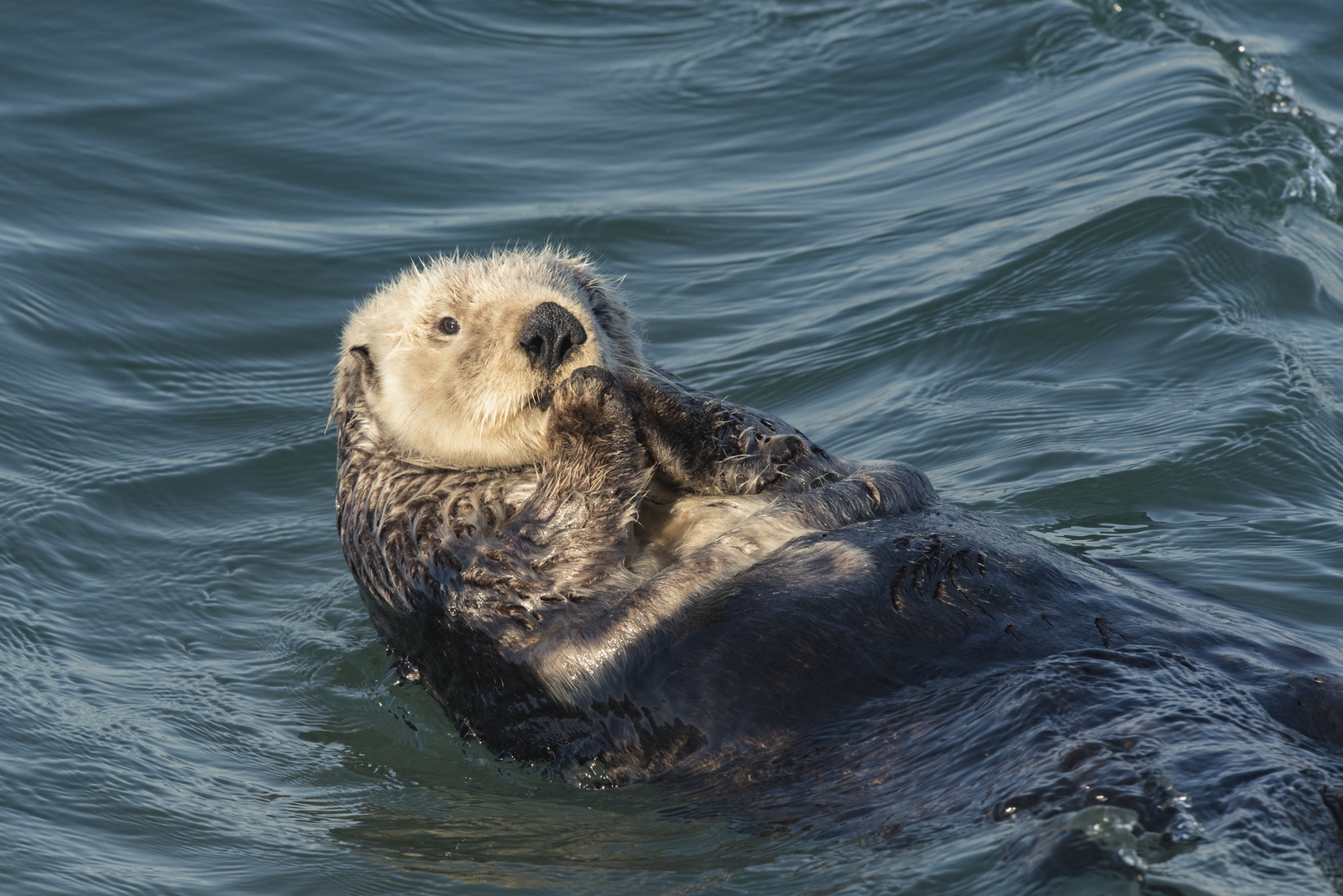
Alaska
Sea otter, Enhydra lutris
The sea otter is a marine mammal that spends almost the entirety of its life at sea. Growing to 80 pounds or more, the sea otter is often seen floating on its back while crunching away on shellfish prey found in frequent dives to the seafloor. Sea otters have no blubber layer as other marine mammals do but no other mammal has such dense and insulating fur.
Range:
Its original range runs along a Pacific coast arc reaching from present-day California, through regions of Alaska’s Alexander Archipelago and the Aleutian Islands, and eastward through the Kamchatka coast and south to Japan’s northernmost island of Hokkaido.
Where to see:
Sea otters are common in many accessible coastal areas in Southeast Alaska, including Glacier Bay National Park, and in Southcentral Alaska, such as Kenai Fjords National Park.
Conservation approach:
Sea otter populations were once decimated throughout their Bering Sea range due to a commercial fur trade that began in the 18th century. In Alaska, sea otters have rebounded and are now abundant in many coastal areas. Some efforts at transplanting sea otters in past decades appear to have helped reestablish local populations. These abundant sea otter populations are sometimes in competition with local Indigenous subsistence traditions which have long relied on shellfish such as clams, crabs and mussels.
Significance for habitat/biodiversity:
Sea otters are a keystone species in their coastal ecosystems. By controlling the populations of green sea urchins, which graze on undersea kelp forests, sea otters help ensure healthy nursery habitats for fish and other species.
Learn more:
Alaska Department of Fish and Game page on sea otters
Reviewed by Colin Shanley, Spatial Ecologist, TNC in Alaska.
Photo Credit: Kiliii Yuyan
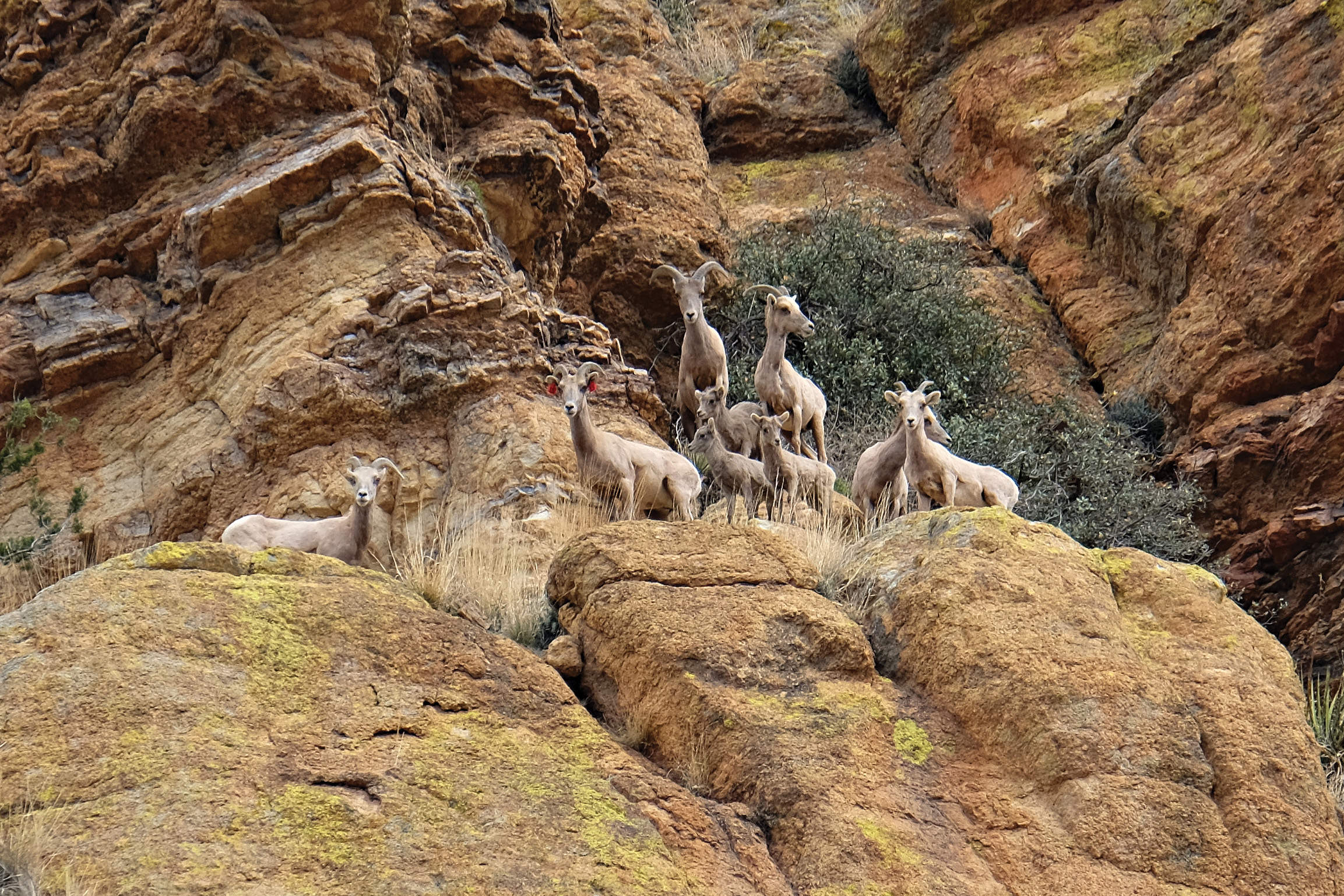
Arizona
Bighorn sheep, Ovis canadensis
There are three subspecies of bighorn sheep: Desert bighorn sheep in Arizona’s Aravaipa Canyon, Rocky Mountain bighorn sheep in Colorado and Sierra Nevada bighorn sheep in California. Bighorn sheep have muscular, compact bodies covered in chocolate brown fur with a dash of white on the muzzle, rump and belly. While most weigh 160 to 250 pounds, males can weigh more than 350 pounds and stand around 40 inches at the shoulder. Arizona’s desert bighorn sheep are generally lighter in color, smaller bodied and can have longer horns. They have wide-set eyes that are situated well forward on the head, providing a wide arc of exceptional vision. Their concave hooves allow them to climb steep, rocky desert mountains quickly and easily. These agile animals are well adapted to the arid environment in the west, going several weeks without water while living mostly off grasses and, sometimes, cacti.
Range:
Primarily Mojave and Sonoran deserts in Arizona and California. Approximately 1.5 million to 2 million bighorn sheep lived in North America at the beginning of the 19th century; however, only 4% of their historic range remains because of disease from livestock and habitat loss.
Where to see:
TNC’s Aravaipa Canyon Preserve in southern Arizona
Rocky Mountain National Park in Colorado
Conservation approach:
TNC in Arizona collaborates with public land managers to implement controlled burns to help keep their habitat open so they can see and escape from predators such as mountain lions, coyotes and bobcats.
Significance for habitat/biodiversity:
Bighorn sheep live in steep mountainous habitat, with ledges sometimes only two inches wide provides cover from predators. Most populations undergo seasonal movements, generally using larger upland areas in the summer and concentrating in sheltered valleys during the winter.
Photo Credit: Stefen Doucette/TNC
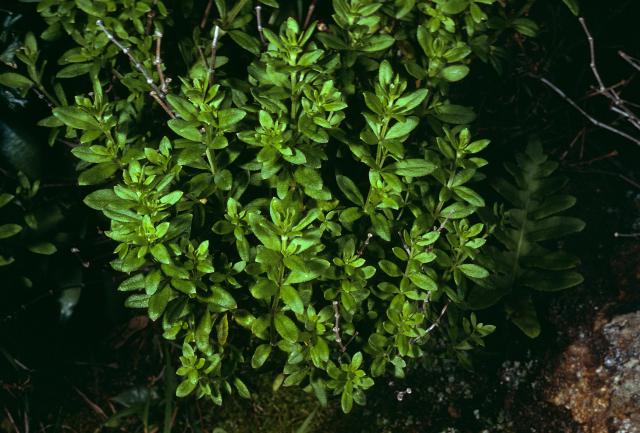
California
Island bedstraw, Galium buxifolium
Island bedstraw is a long-lived woody shrub with small flowers that lives on coastal bluffs and marine terraces, of Santa Cruz and San Miguel Islands. It is a clear example of “island woodiness,” when soft-tissued herbaceous species evolve on islands to form woody tissue.
Range:
The only place on Earth where island bedstraw exists is on two of California’s Channel Islands.
Where to see:
Visitors to TNC’s Santa Cruz Island can see island bedstraw. Please stay on established trails or observe from a boat to catch a glimpse of island bedstraw and protect its vulnerable populations.
Conservation approach:
Once found on the marine terraces of Santa Cruz and San Miguel Islands, island bedstraw survived on steep cliff faces inaccessible to introduced mainland vertebrate that ate them into oblivion. After the threats were removed island bedstraw began to recolonize areas it had not been seen since the late 1800s. Island stewards and research botanists worked in concert to monitor and assess its status by applying a novel approach developed to survey for invasive plants.
“Recovery doesn’t happen overnight. It takes sound science, collaboration with many partners and, most importantly, commitment.” —John Knapp, Senior Island Scientist with TNC.
Significance for habitat/biodiversity:
Compared to the mainland, islands have fewer species, so each species has the burden of playing multiple roles in the ecosystem. From providing food for pollinators to soil remediation and creating habitat for other species, native flora keep islands running. But the more plant species islands lose, the harder it is for their ecosystems to remain resilient and defend against threats like invasive species, increased wildfires, and climate change.
Reviewed by John Knapp, Senior Island Scientist with TNC.
Photo Credit: Steve Junak/Courtesy of the Santa Barbara Botanic Garden
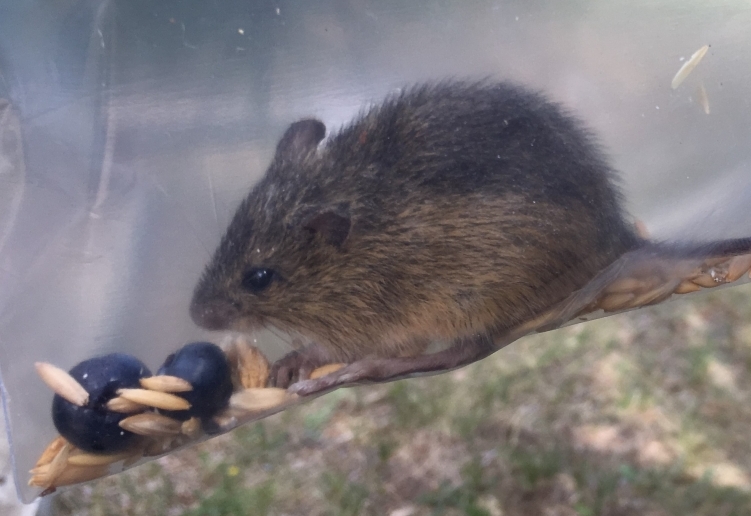
Colorado
Preble's meadow jumping mouse
Zapus hudsonius preblei
Known for its remarkable leaps, the Preble's meadow jumping mouse is endemic to riparian ecosystems of Colorado and Wyoming—found nowhere else in the world.
Range:
Front Range of Colorado and Southern Wyoming in riparian habitat.
Where to see:
You can see the Preble’s meadow jumping mouse at the Phantom Canyon Preserve in the Laramie Foothills near Fort Collins, CO.
Conservation approach:
The decline of their habitat due to human interference and development has led to rapid population decline, as they are now a federally threatened species. As part of the North Fork Cache la Poudre Watershed Site Conservation Team, TNC is working to protect habitat and promote species recovery for this critical species. This will be achieved by enhancing healthy riparian corridors that connect suitable habitat throughout the species range and promoting compatible land use.
Significance for habitat/biodiversity:
Water-rich, riparian ecosystems support hundreds of species of flora and fauna, including many species of conservation concern. Riparian habitat throughout the semi-arid West is a limited resource and is at risk from land conversion. Altered stream flow, habitat loss, and drought threaten not only Preble’s recovery, but the success of other dependent species.
Reviewed by Chelsea Beebe, TNC Colorado Conservation Ecologist.
Photo Credit: TNC
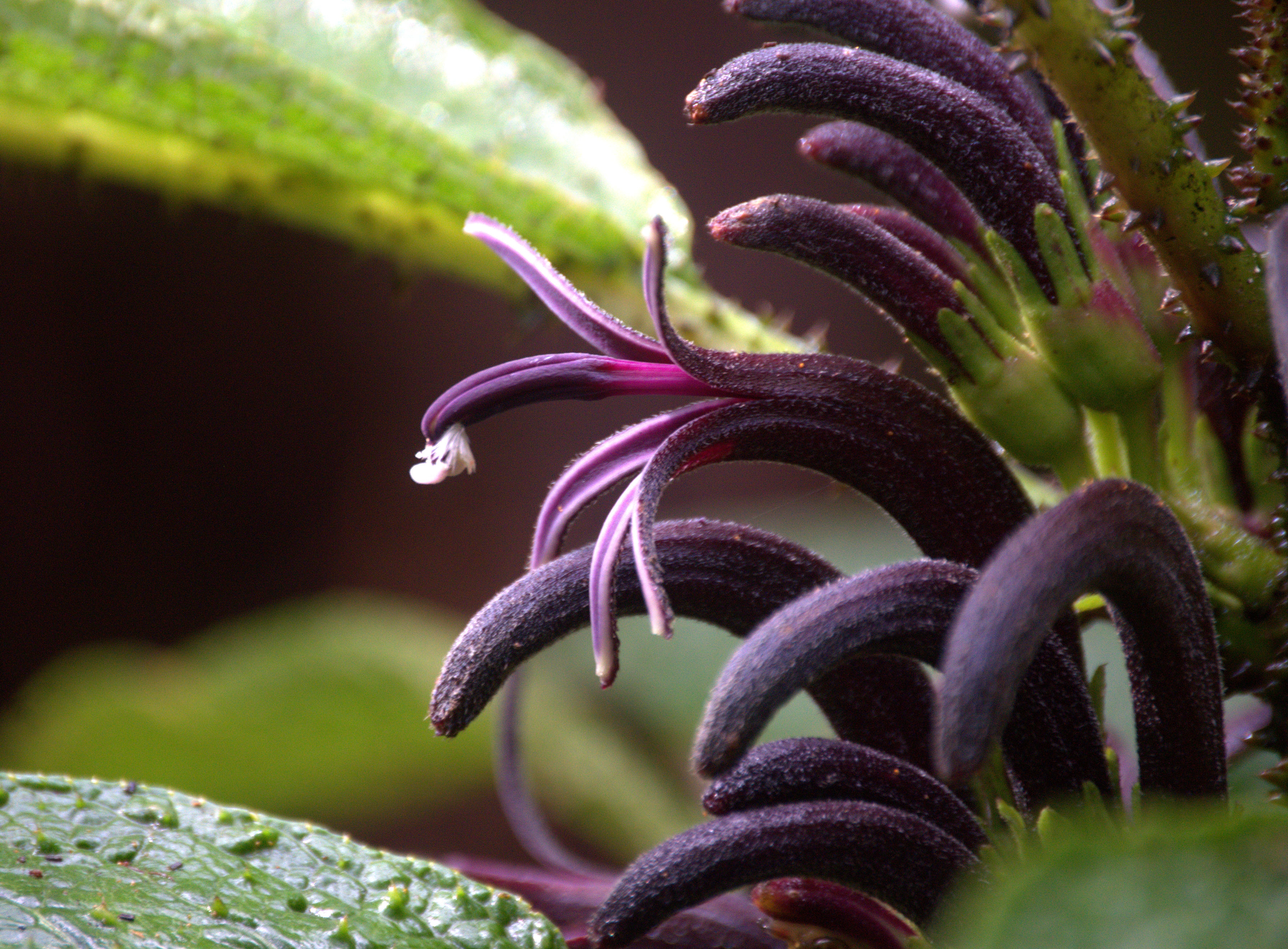
Hawai‘i
Lobeliads, Cyanea sp., Hāhā in Hawaiian
Cyanea sp. is a genus of flowering plants in the family Campanulaceae. The plant is called hāhā in the Hawaiian language. Hāhā grow in moist and wet forest habitat and are largely pollinated by native birds such as the Hawaiian honeycreepers. Unlike most endemic species in Hawai‘i which lost their defenses due to lack of predators, the hāhā evolved with large thorns on the lower part of its new growth. One theory suggests that the thorns are a defense against herbivory by the moa-nalo, a group of tall flightless ducks that went extinct on the islands within the last 1600 years.
Cyanea fruits are a food source for many endemic insects, which are themselves important food sources for endangered birds such as the Kiwikiu (Maui parrotbill, Pseudonestor xanthophrys). Cyanea, even with thorny protuberances, are home to many native invertebrates including Hawai‘i’s endemic snails.
Range:
Hawaiian lobelioids are endemic to Hawai‘i and found nowhere else on earth. There are multiple endangered Cyanea species across Hawai‘i. Many of them co-evolved with bird species whose curved beaks perfectly match the curve of the Cyanea flowers.
Where to see:
Within protected TNC preserves such as Waikamoi on Maui and Kona Hema on Hawai‘i island.
Conservation approach:
Cyanea and other endangered plants and animals find a safe haven within TNC’s forest preserves that are free from invasive animals and managed for weeds. TNC maintains and manages forest preserves across Hawai‘i with a focus on passive restoration by removing threats and allowing native systems to recover. Thanks to this work, biologists have been able to plant hundreds of Cyanea in TNC forest preserves, in partnership with the Hawai‘i Plant Extinction Prevention Program.
Significance for habitat/biodiversity:
Habitat loss is the key threat to many of Hawai‘i’s endemic species, along with invasive animals and weeds. The Hawaiian lobelioids (the six genera of: Brighamia, Clermontia, Cyanea, Delissea, Lobelia, and Trematolobelia) represent one of the best examples of adaptive radiation with Cyanea being the most species rich (currently 79 species in the genus).
Learn about the safe haven provided by TNC’s Waikamoi Preserve on Maui and Kona Hema Preserve on Hawai‘i island. See more images of Cyanea species here, here, and here.
Reviewed by Keoki Kanakaokai, Natural Resource Manager, Maui forest program.
Photo Credit: TNC

Idaho
Chinook salmon, Oncorhynchus tshawytscha
Salmon, migratory fish of the Salmonidae family, are known for their vibrant hues and remarkable life cycle—spanning ocean and freshwater.
Range:
Watersheds from California to Alaska, extending east into Idaho
Where to see:
Salmon usually return from May through October. While salmon can be difficult to see in large rivers, you can carefully watch them as they move up small streams. A spectacular place to see the salmon is at Dagger Falls, on the Middle Fork of the Salmon River as the leap up the falls.
Conservation approach:
Salmon traverse 900 miles from the ocean to Idaho’s Pahsimeroi and Lemhi rivers. When they get to the small streams of central Idaho, they spawn and then die. After hatching and growing, young salmon—called smolts—will begin their own migration to the sea. Many salmon, unfortunately, are stopped short of their final spawning area by dams, insufficient water or irrigation diversions. Habitat loss and warming stream temperatures further threaten these fish. The Nature Conservancy in Idaho works with landowners and partners to remove movement barriers and restore spawning habitat.
Significance for habitat/biodiversity:
Salmon have been called the “wild heart” of Idaho for good reason. As they migrate, salmon bring essential nutrients from the ocean to inland ecosystems. Their bodies contribute marine-derived nutrients to river systems, which are crucial for other species. Salmon are also deeply embedded in the cultural heritage of many Native American tribes in Idaho, holding economic, spiritual and social significance.
Reviewed by Taylor Ganz, Lead Scientist for Idaho
Photo Credit: Steve Dondero
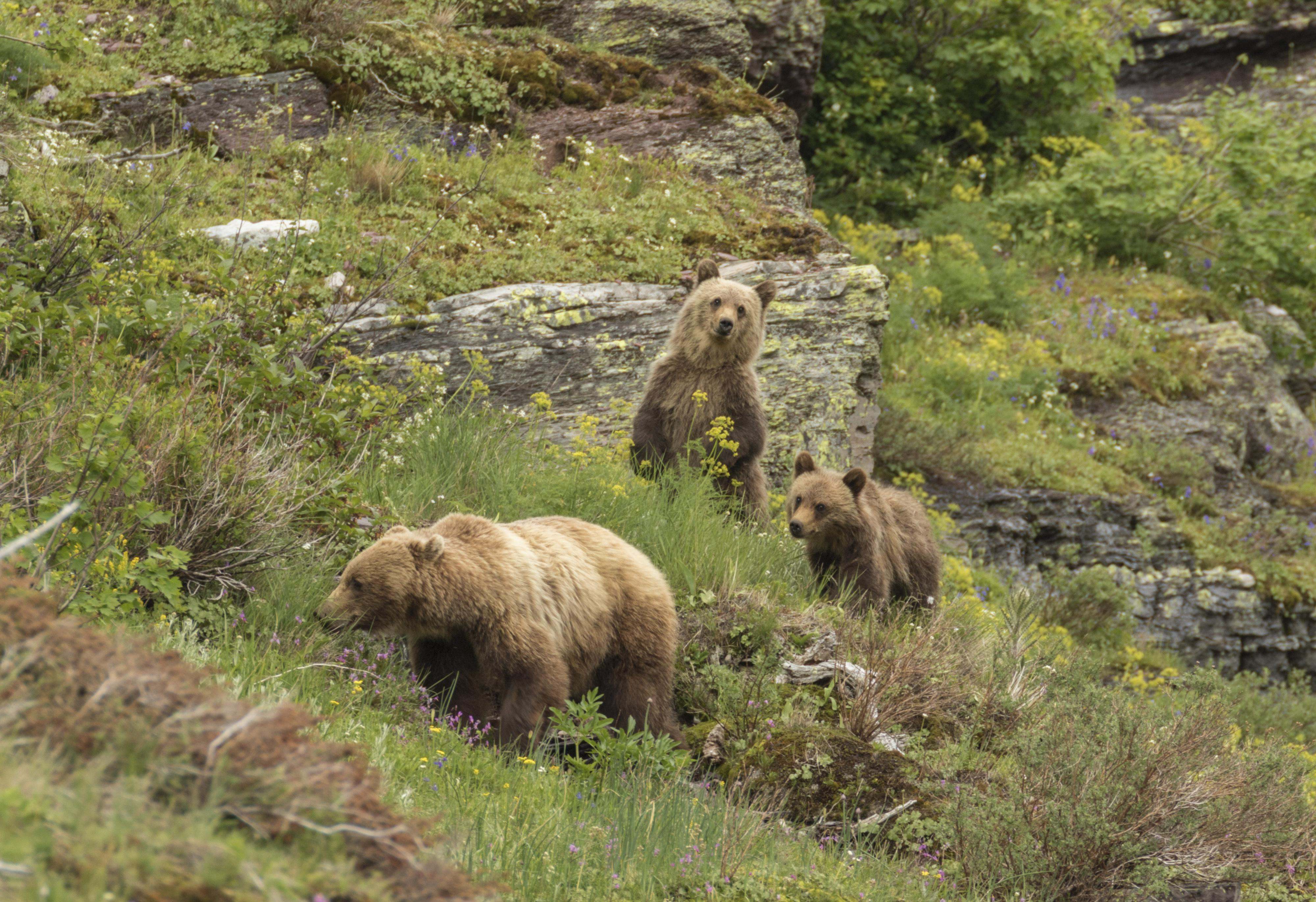
Montana
Grizzly bear, Urus arctos
Grizzly bears once ranged across most of western North America, from Mexico to northern Alaska and Canada. Grizzlies are distinguished from black bears by the prominent hump on their shoulders, scooped-out snout profile and small, rounded ears. Grizzlies are omnivores whose diets consist of a wide variety of foods from grasses, berries and roots to fish, mammals and insects.
Range:
Current range in the lower 48 states includes Greater Yellowstone Ecosystem in Montana, Wyoming and Idaho, Montana’s Crown of the Continent region, and the Selkirks and Cabinet-Yaak in northern Idaho and Montana. One of two subspecies of brown bears in North America, grizzlies have a far greater range in Western Canada and in Alaska, where they are commonly called brown bears. The other brown bear subspecies, the Kodiak bear, lives exclusively on Alaska’s Kodiak Archipelago.
Where to see:
Yellowstone and Glacier National Parks (and surrounding lands).
Conservation approach:
Given that a grizzly may have a home range of hundreds of square miles, protecting large, connected areas of intact habitat is critical. In Montana’s Crown of the Continent and parts of the Greater Yellowstone, TNC acquires and manages lands that provide vital habitat for a diversity of wildlife, including grizzlies. TNC also partners with willing landowners to develop land protection agreements that secure and connect wildlife habitat across public lands and private properties such as family ranches. We also work with wildlife managers and landowners to help avoid human-bear conflicts.
Significance for habitat/biodiversity:
Historically, grizzlies ranged across much of Montana, but as western settlements grew, they remained only in more remote mountainous areas. As their numbers have begun to recover, grizzlies now once again inhabit a wider range of habitats, including grasslands, meadows, wetlands, streamside zones, forests and alpine areas.
Learn more:
Visit Montana Natural Heritage Programs Field Guide for more information.
Reviewed by Dave Hanna, Crown of the Continent Program Director.
Photo Credit: Loren Merrill/TNC Photo Contest 2019
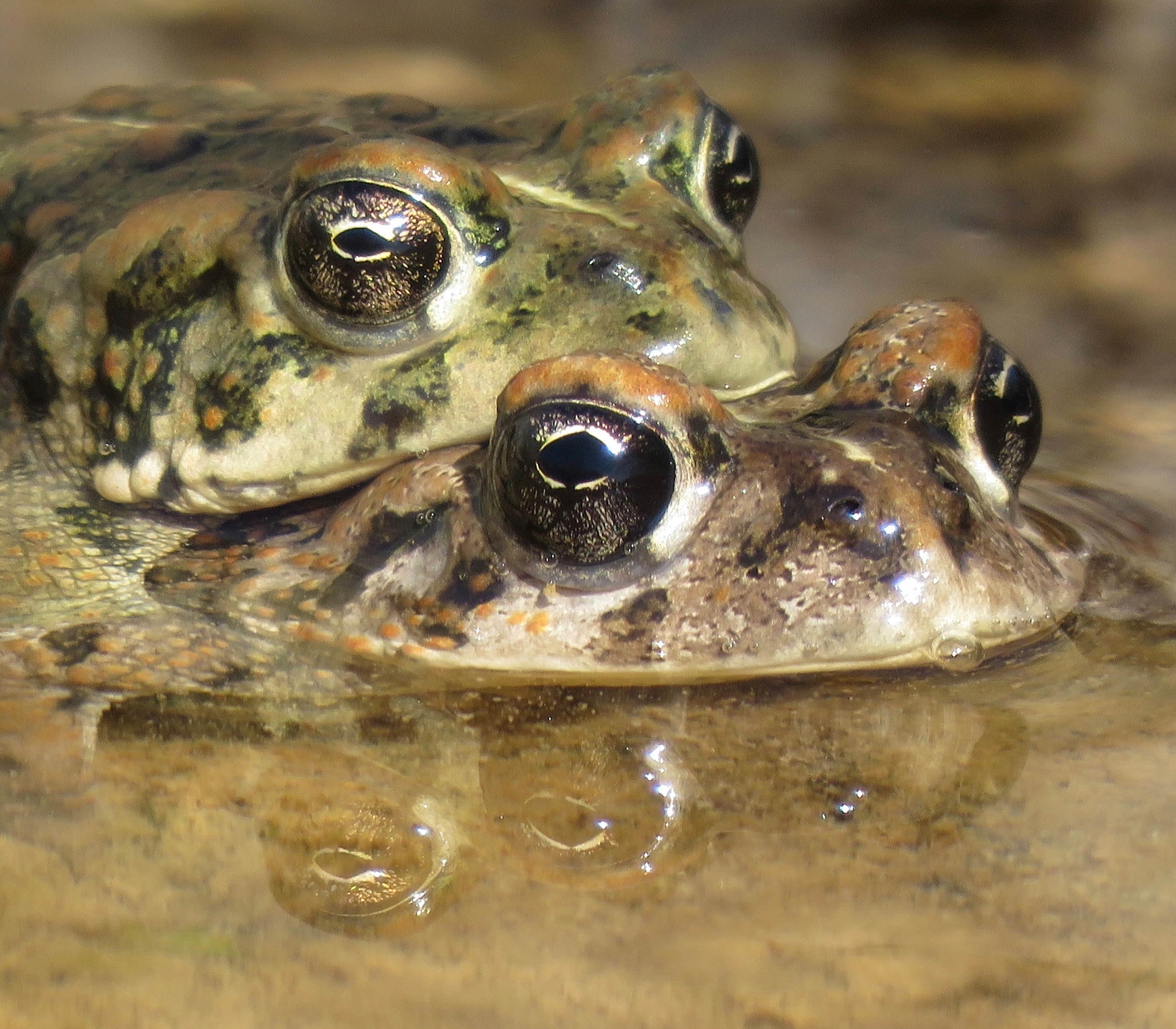
Nevada
Amargosa toad, Anaxyrus nelsoni
The Amargosa toad is an incredibly rare species that lives in the Oasis Valley of the Amargosa River, a biologically diverse area at the transition of the Mojave and Great Basin deserts. This medium-sized, short-limbed toad is dependent on water from the river and its springs.
Range:
The Amargosa toad is endemic to Nevada and found nowhere else on Earth other than its natural habitat along a 15-mile stretch of the Amargosa River from Beatty to TNC’s Gary & Lajetta Atwood Preserve.
Where to see:
Amargosa toads can be found in small ponds and standing pools of water at TNC properties in the Oasis Valley, including Torrance Ranch Preserve, Gary & Lajetta Atwood Preserve and the Beatty Narrows.
Conservation approach:
TNC has been working to protect the Amargosa River, home of the Amargosa toad, for almost 40 years, and we have protected more than 1,600 acres of its habitat through acquisition and easements. In 2010, we came together with partners and community members in Beatty to prevent the toad from being listed as an endangered species. The restoration approach we have developed at Torrance Ranch Preserve more than 20 years ago has been successful in attracting and supporting these native amphibians, as well as local and migratory birds, fish and thriving native plant communities. The work being done there has also become a model for how to create and sustain desert wetland habitats and build a coalition of partners dedicated to protecting the Amargosa toad.
Significance for habitat/biodiversity:
The species is incredibly rare and threatened by several factors, including habitat loss and degradation, water diversion and invasive species.
Learn more:
Cool Green Science: Protecting the Amargosa: From Suspicion to Support for a Desert River
Reviewed by Michael Clifford, Conservation Scientist for TNC in Nevada.
Photo Credit: Len Warren/The Nature Conservancy
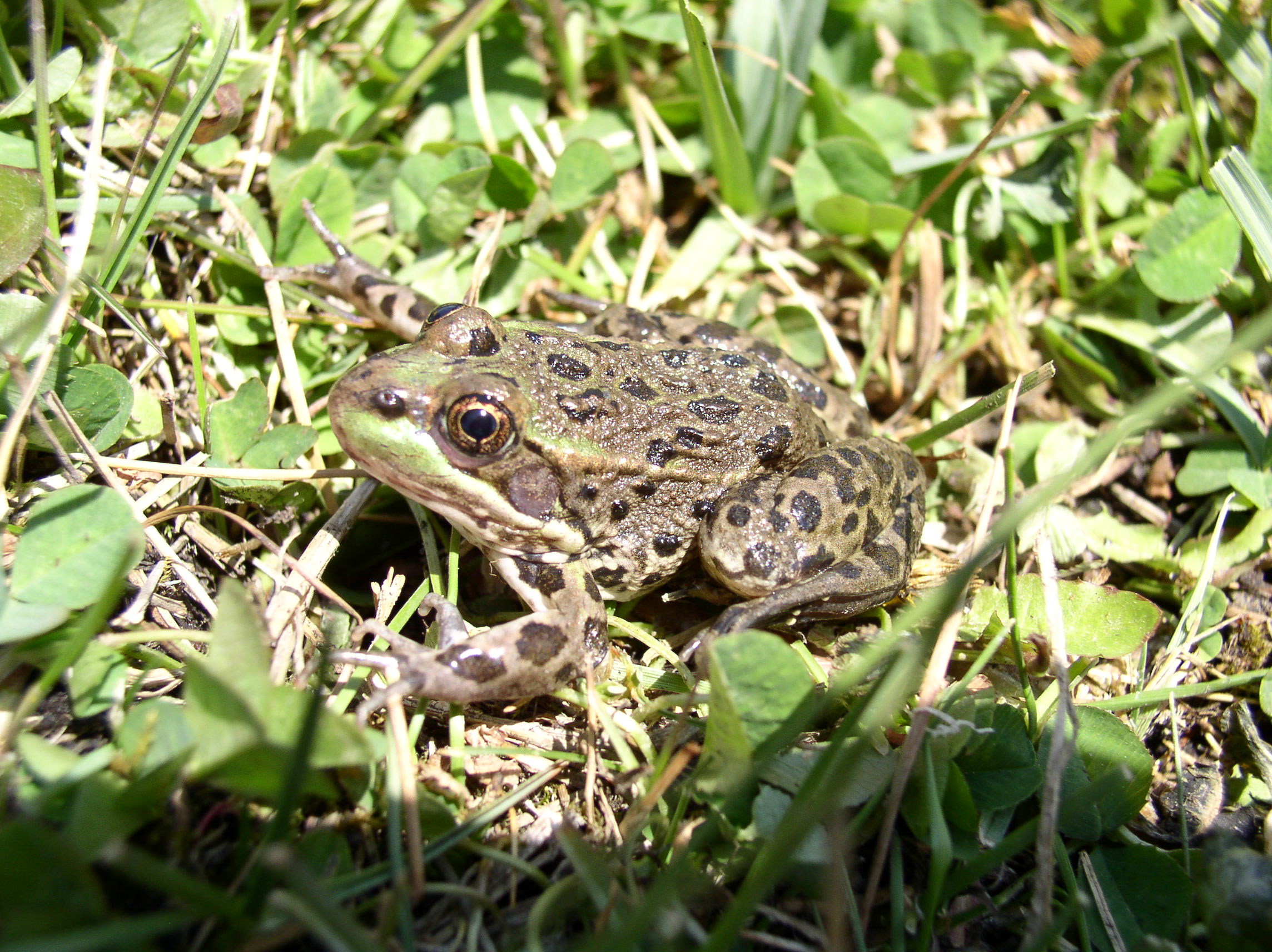
New Mexico
Chiricahua leopard frog
Lithobates chiricahuensis
The Chiricahua leopard frog has a unique color pattern of small, raised cream-colored spots across the body including its thighs. What makes this species different from other leopard frogs is the call it makes to others, which sounds like a snore.
Range:
Southwestern New Mexico and southeastern Arizona
Where to see:
You can see the Chiricahua leopard frog at the TNC’s Mimbres River Preserve, near Silver City, NM.
Conservation approach:
To protect some of the Chiricahua’s remaining habitat, TNC purchased the Mimbres River Preserve in New Mexico, which includes 600 acres and irreplaceable streamside habitat along five miles of river. Additionally, TNC, the New Mexico Department of Game and Fish and the U.S. Fish and Wildlife Service have completed habitat restoration projects along the river and in adjacent wetlands. We see the Chiricahua leopard frogs and other critters swimming in open pools.
Significance for habitat/biodiversity:
Water withdrawals, river channelization, parasites and pathogens, and the introduction of non-native fish species have degraded the amphibian’s habitat. The Mimbres River Preserve provides a safe home for the critters with year-round water flows and an off-channel wetland spring habitat.
Reviewed by Martha Cooper, TNC's Freshwater Director in New Mexico
Photo Credit: Sue Sitko/The Nature Conservancy
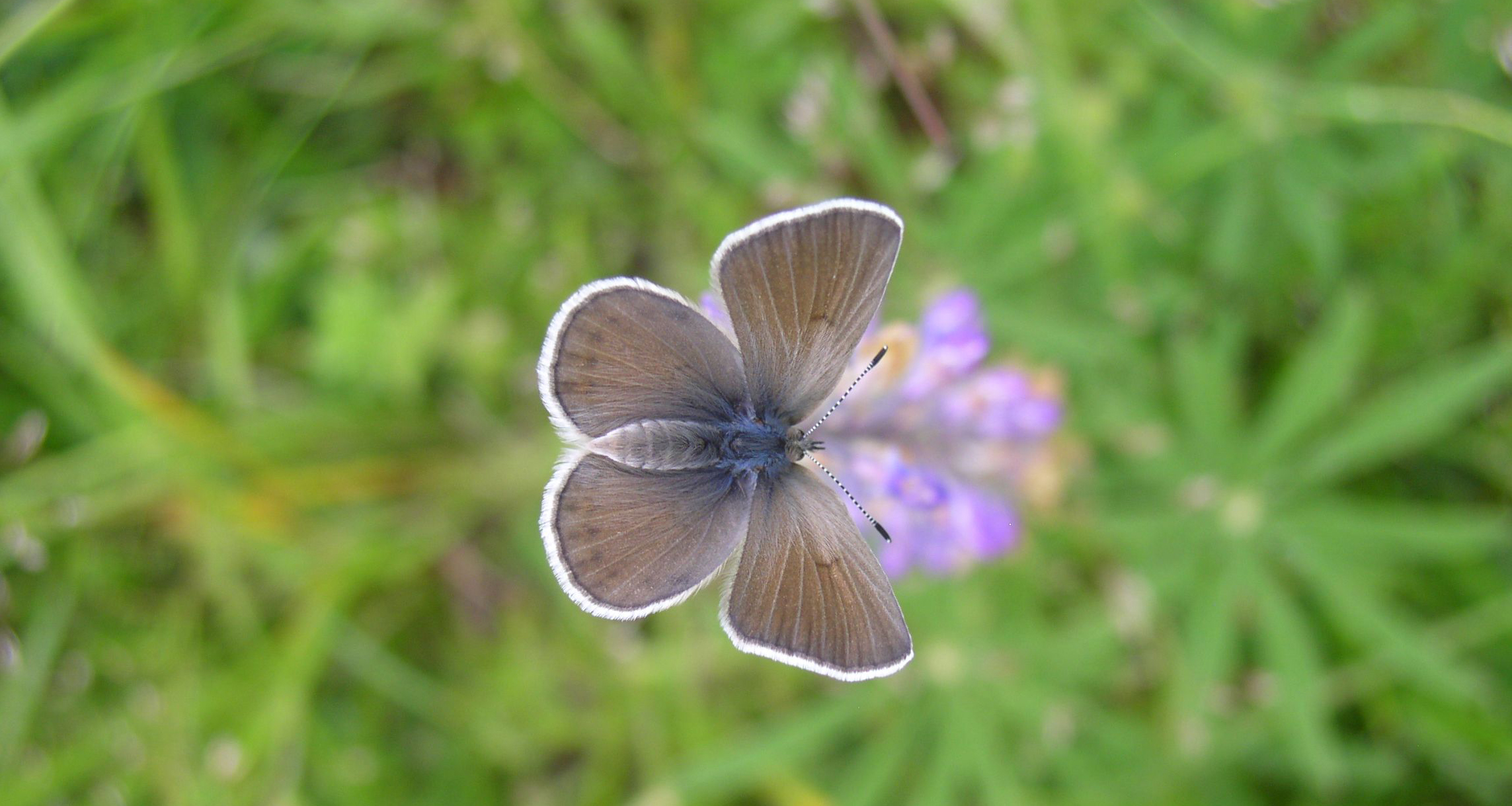
Oregon
Fender’s blue butterfly
Icaricia icarioides fenderi
Found only in the Willamette Valley, Fender’s blue butterfly depends on a threatened wildflower called Kincaid’s lupine.
Range:
Willamette Valley.
Where to see:
Willamette Valley at TNC’s Willow Creek Preserve in Eugene, OR.
Conservation approach:
As of January 2023, the U.S. Fish and Wildlife Service announced the reclassification of Fender's blue butterfly from endangered to threatened under the Endangered Species Act. Fender’s blue butterfly was believed to be extinct in 1937 but was rediscovered in 1989.
For decades, TNC has worked to enhance and restore native prairie on Willow Creek Preserve in Eugene for these and other native prairie species. Working in partnership with other conservation agencies and organizations, TNC led conservation and restoration efforts of native prairie and oak savanna in the Willamette Valley for over three decades. TNC has been instrumental in securing permanent protections for numerous strategic conservation properties through direct acquisition or by securing conservation easements.
Significance for habitat/biodiversity:
Native prairie and savanna habitats have become a conservation focus in North America due to recognition of their importance to native plants and wildlife and because of the dramatic loss of these habitats from conversion to agriculture and urban development (Apostol and Sinclair 2006). Further, remnant prairies and savannas are often small, fragmented, and ecologically degraded leading to further declines and loss of native plants and animals. This is particularly evident in the Willamette Valley in Oregon, where over 98% of native prairie and oak savanna habitat has been lost (Noss et al. 1995, Floberg et al. 2004). Without continued active management and restoration, invasive woody and non-native plants would quickly reduce the ecological value of prairie habitat at these sites and reverse conservation gains.
Fender’s blue butterfly only lives in the Willamette Valley and reproduces on only one kind of flower—the Kincaid’s blue lupine. This plant has disappeared in the valley due to a variety of causes from urbanization, agriculture, and non-native plant invasions to the suppression of wildfire.
Reviewed by Jeff Rosier, TNC Oregon Willamette Basin Steward.
Photo Credit: Matthew Benotsch
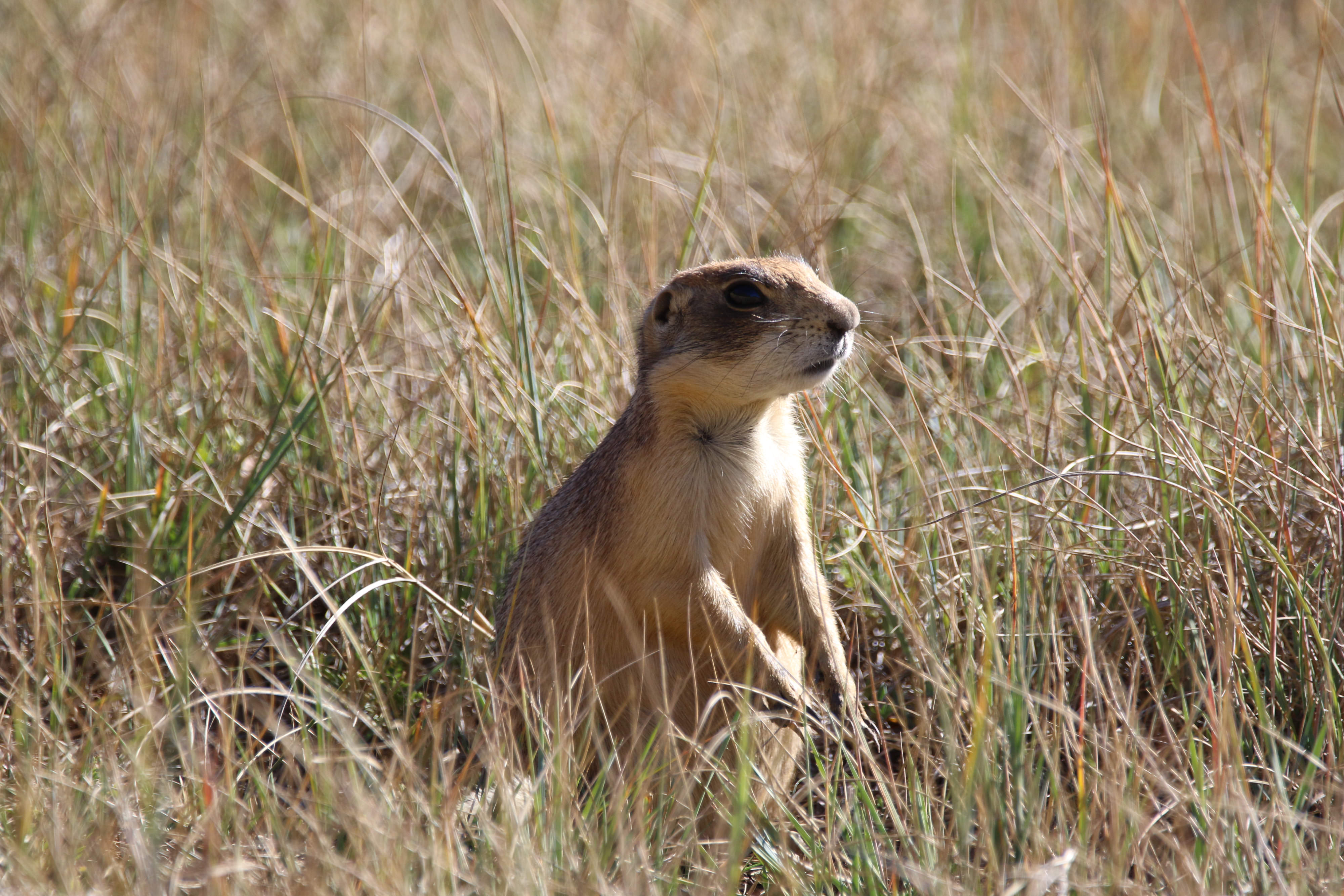
Utah
Utah prairie dog, Cynomys parvidens
The body of a Utah prairie dog is like a squirrel with short limbs and mid-length tails (1-2.5 inches). Standing approximately 10-15 inches tall and weighing 1-2 pounds, they have light to dark brown fur. Like other species of prairie dogs, the Utah prairie dog is mainly an herbivore, but sometimes eats cicadas and other insects. They live in extended family colonies in networks of underground holes.
Range:
They are found only in southwestern Utah, roughly between Bryce Canyon National Park and Cedar City.
Where to see:
Bryce Canyon National Park is a great place to see Utah prairie dogs. When you’re there, ask a ranger at the visitor center for the best locations to see prairie dogs in their natural habitat.
Conservation approach:
Due to development and disease, the Utah prairie dog was nearly wiped out and listed as endangered in 1973. Now, it’s part of a U.S. Fish and Wildlife Service (USFWS) recovery program designed to ensure healthy populations. TNC in Utah—working alongside the USFWS, Utah Division of Wildlife Resources and others—has helped protect 800 acres of prime prairie dog habitat near Bryce Canyon National Park and another 291 acres north of Cedar City. With TNC managing land and holding an easement on one of these parcels, Utah prairie dogs spotted in these areas can be part of the annual spring count which supports the recovery effort.
Significance for habitat/biodiversity:
Utah prairie dogs provide many benefits to people and nature. Their engineered burrows help maintain meadows which support a variety of plants and animals and allow soil to better absorb water and nutrients. They serve as prey for animals including eagles and hawks. Additionally, their burrows are used by other critters.
Learn more:
Can Prairie Dogs Talk (NY Times)
Catch the Wave: Decoding the Prairie Dog (Scientific American)
Reviewed by Elaine York, TNC's West Desert Regional Director.
Photo Credit: Donald Hobern/Flickr CC BY 2.0
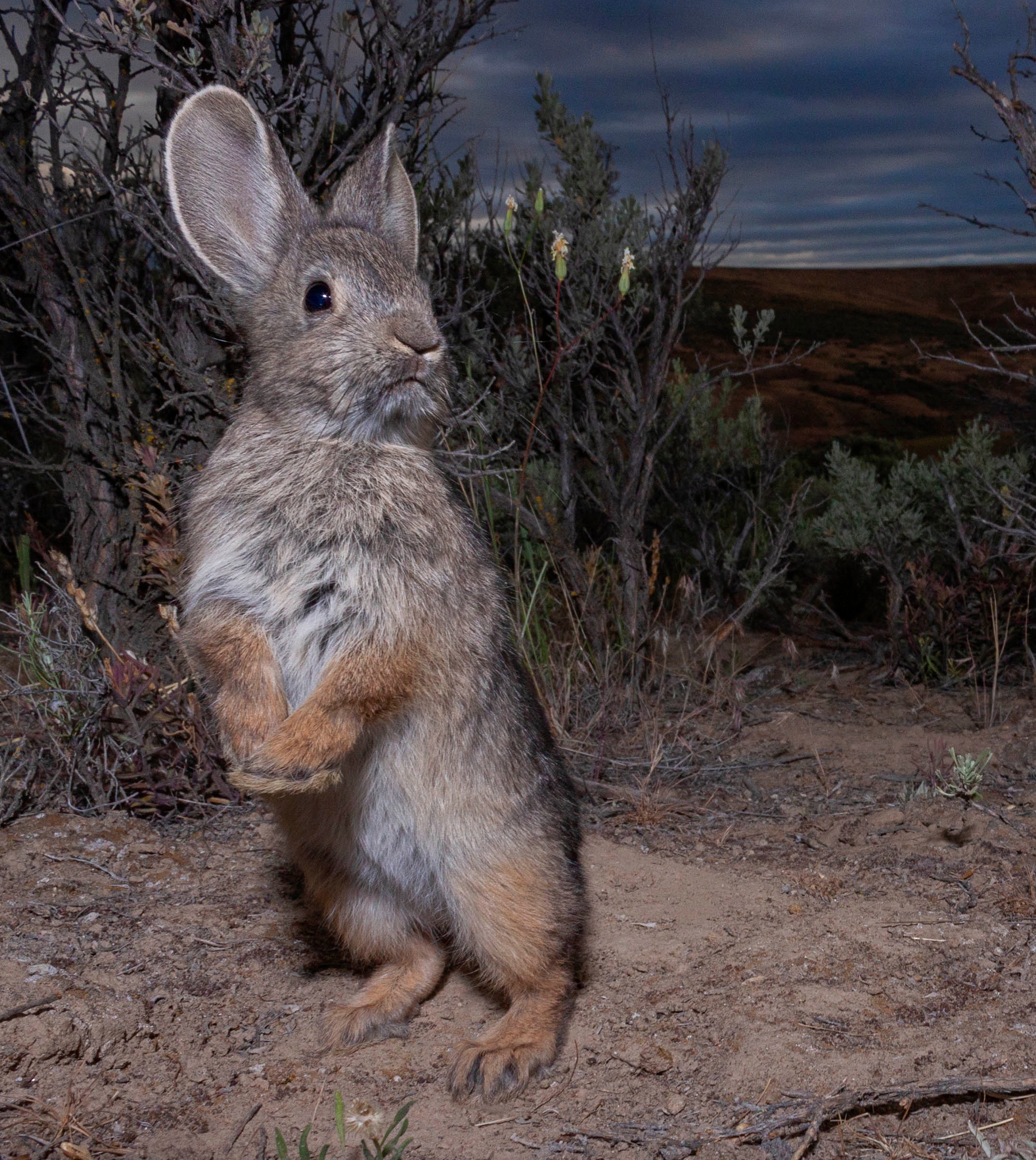
Washington
Columbia Basin pygmy rabbit
Brachylagus idahoensis
In the last two decades, hopeful state and federal wildlife biologists, pygmy rabbit fans, farmers and ranchers, conservation research zoos, and nonprofits have all come together to give the rabbits a fighting chance against seemingly insurmountable odds.
Range:
Columbia Basin/Eastern Washington.
Where to see:
Eastern Washington at TNC’s Moses-Coulee Preserve Complex (rabbits are only at Beezley Hills & McCartney Creek right now due to wildfire).
Conservation approach:
Starting in 2011, with volunteer help, the Washington Department of Fish and Wildlife fenced in four multi-acre coyote-proof enclosures on shrub-steppe habitat.
Significance for habitat/biodiversity:
Since the 1700s, 80% of the sagebrush ecosystem in Washington has been lost to development and farming. And nearly 1 million more acres across the West are lost each year. In its place, cheatgrass—a fast-growing invasive weed—has quickly spread across portions of the region. An aggressive invader, it dries out early each year, making it highly flammable.
Reviewed by Daniel Misch, Arid Lands Manager/Moses Coulee Preserve Assistant Manager.
Photo Credit: Morgan Heim
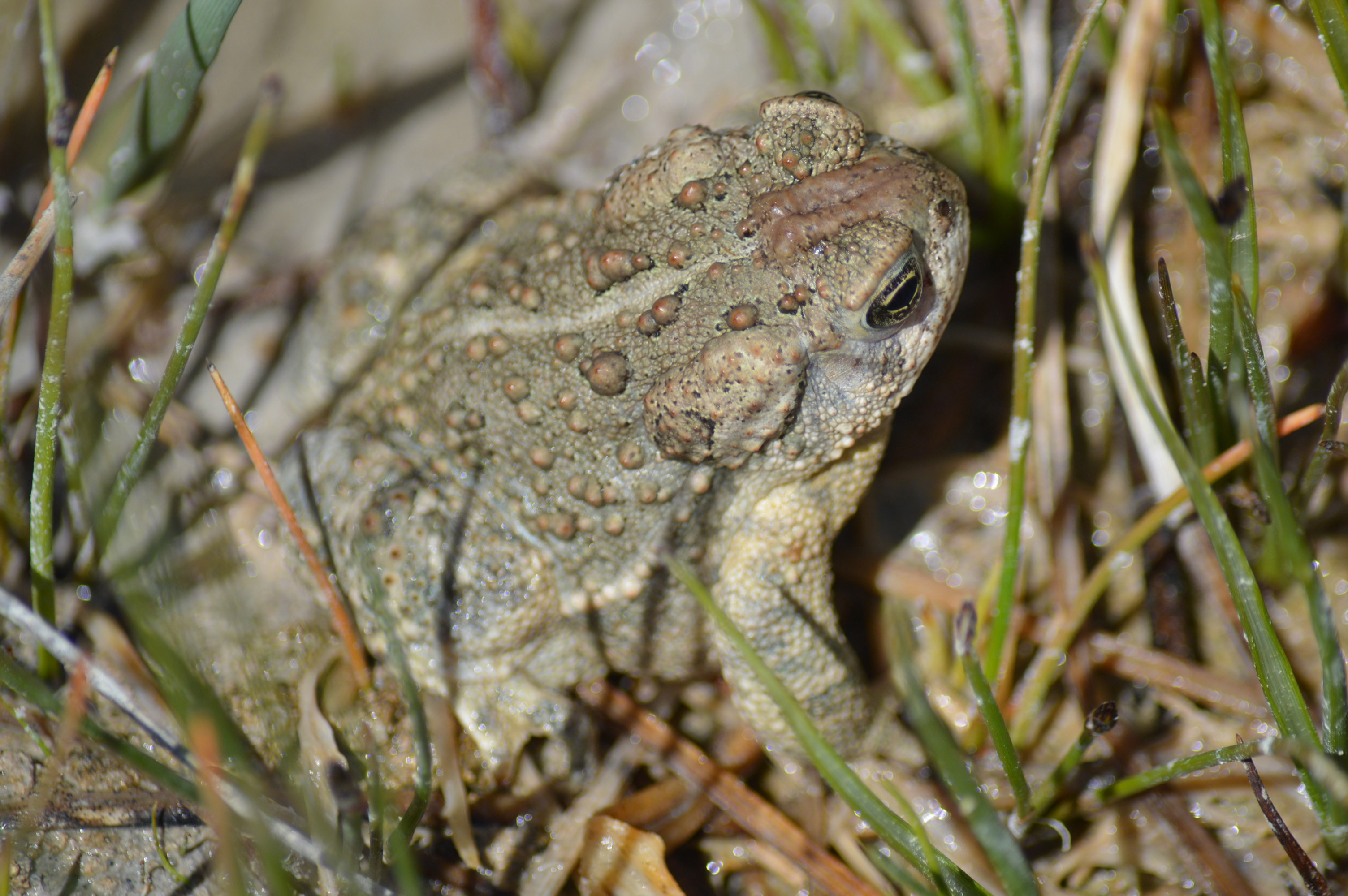
Wyoming
Wyoming toad, Bufo hemiophrys baxteri
Wyoming toads are somewhat smaller than other toads, ranging between 1.75 to 2.75 inches in length. They have bony ridges on the top of their heads that can distinguish them from other toad species. These are carnivorous critters, dining on an array of invertebrates such as beetles, ants, and spiders, and their diet can make them adorably chubby.
Range:
Once thriving in wetlands and rivers across the Laramie Basin of southeastern Wyoming, the toad is now found only within the Mortensen Lake National Wildlife Refuge and the Wyoming Toad Conservation Area adjacent to Hutton Lake National Wildlife Refuge.
Where to see:
Currently, Mortensen Lake National Wildlife Refuge and public land within the Wyoming Toad Conservation Areas is not open to the public, so it is still difficult to view the toad.
Conservation approach:
Thought to be extinct in the mid-1980s due to Chytrid fungus, habitat loss, and possibly pesticides, a small population was found in a privately-owned lake. Those toads were gathered and bred in captivity to build back the population. TNC purchased the land and held onto it until it could be transferred to the public at which time the Mortensen Lake National Wildlife Refuge was established. The refuge is one of four sites where the toads have been reintroduced. In 2023, the Wyoming Toad Conservation Area was established as the US Fish and Wildlife Service acquired 1,078 acres of toad habitat on the Laramie Plains. The agency is working with willing landowners to develop land protection agreements that will protect additional habitat on private property within that conservation area.
Significance for habitat/biodiversity:
In the arid climate of southeastern Wyoming, the refuge provides a protected home for the reintroduced toads, which are breeding with success. TNC played an important role in protecting this lake until the refuge could be established.
Reviewed by Brett Lathrop, Wyoming Conservation Easements Monitor.
Photo Credit: US Fish and Wildlife Service/Creative Commons
Learn More: https://www.doi.gov/blog/meet-wyoming-toad
Endangered & Recovering Species in the Midwest
Select the photos to discover more about plants and animals in your state and across the country!
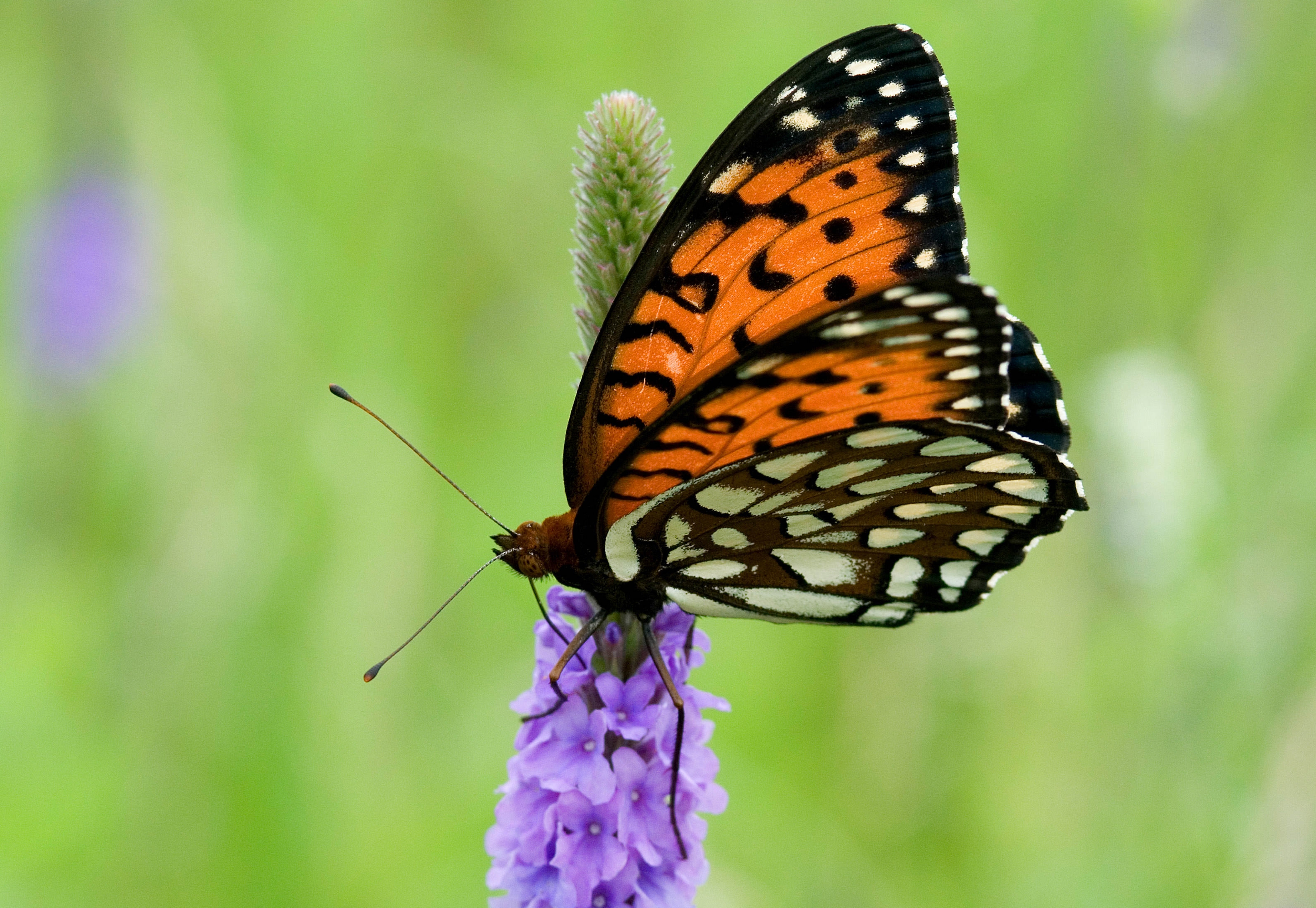
Illinois
Regal fritillary, Speyeria idalia
This striking butterfly, often mistaken for a monarch due to its similar vibrant orange coloring and black markings, is native to tallgrass prairies. As a caterpillar, it has a very specific diet exclusively made up of tender young violet leaves.
Range:
Tallgrass and mixed-grass prairies across the central and western U.S.
Where to see:
The regal fritillary thrives in tallgrass prairies like our Indian Boundary Prairies and Nachusa Grasslands preserves.
Conservation approach:
TNC, partners and supporters are working to bolster habitat and violet food sources across the Midwest, including at our Indian Boundary Prairies and Nachusa Grasslands preserves. At Nachusa, regal fritillaries are using prairie habitat restored as recently as five years ago. While the species remains in decline throughout its historic range, efforts like these prairie plantings that include five violet species and expand large, connected prairie landscapes are setting the stage for a comeback.
Significance for habitat/biodiversity:
Like other pollinators, this butterfly’s population has been declining rapidly in the last few decades due to the significant loss of native prairie habitat and its limited larval diet made up only of violets. The regal fritillary has the essential role of a pollinator, bolstering healthy wildflowers that support many other species in the prairie ecosystem.
Learn more:
Planting for Pollinators
Plant a Pollinator Paradise.
Reviewed by Elizabeth Bach, Ecosystem Restoration Scientist at TNC’s Nachusa Grasslands Preserve in Illinois.
Photo Credit: Chris Helzer/TNC

Indiana
River otter, Lontra canadensis
The river otter is an amphibious mammal known for its grace and playful nature. The otter’s strong swimming skills come in handy when playing in the water or while in pursuit of a meal—be it fish, mollusks or other small invertebrates.
Range:
The river otter occurs in much of Canada and the United States, except for portions of the Southwest.
Where to see:
Thanks to reintroduction efforts spearheaded by the Indiana Department of Natural Resources (DNR), the river otter was removed from Indiana’s endangered species list in 2005, and it can now be found in more than 80 Indiana counties, far surpassing reintroduction goals.
Conservation approach:
In 1995, the DNR began to re-establish healthy otter populations in several watersheds of northern and southern Indiana, including the Blue River in Harrison County. TNC has been very active in the Blue River for more than 20 years, improving water quality for the otter and many other species.
Significance for habitat/biodiversity:
River otters were hunted and trapped extensively for their fur in the 19th and 20th centuries, and are still hunted in some places. Conservation and reintroduction efforts are helping populations to recover, and improvements in water quality have permitted river otters to regain portions of their range.
Reviewed by Matt Williams, director of conservation programs in Indiana.
Photo Credit: Flickr/USFWS midwest
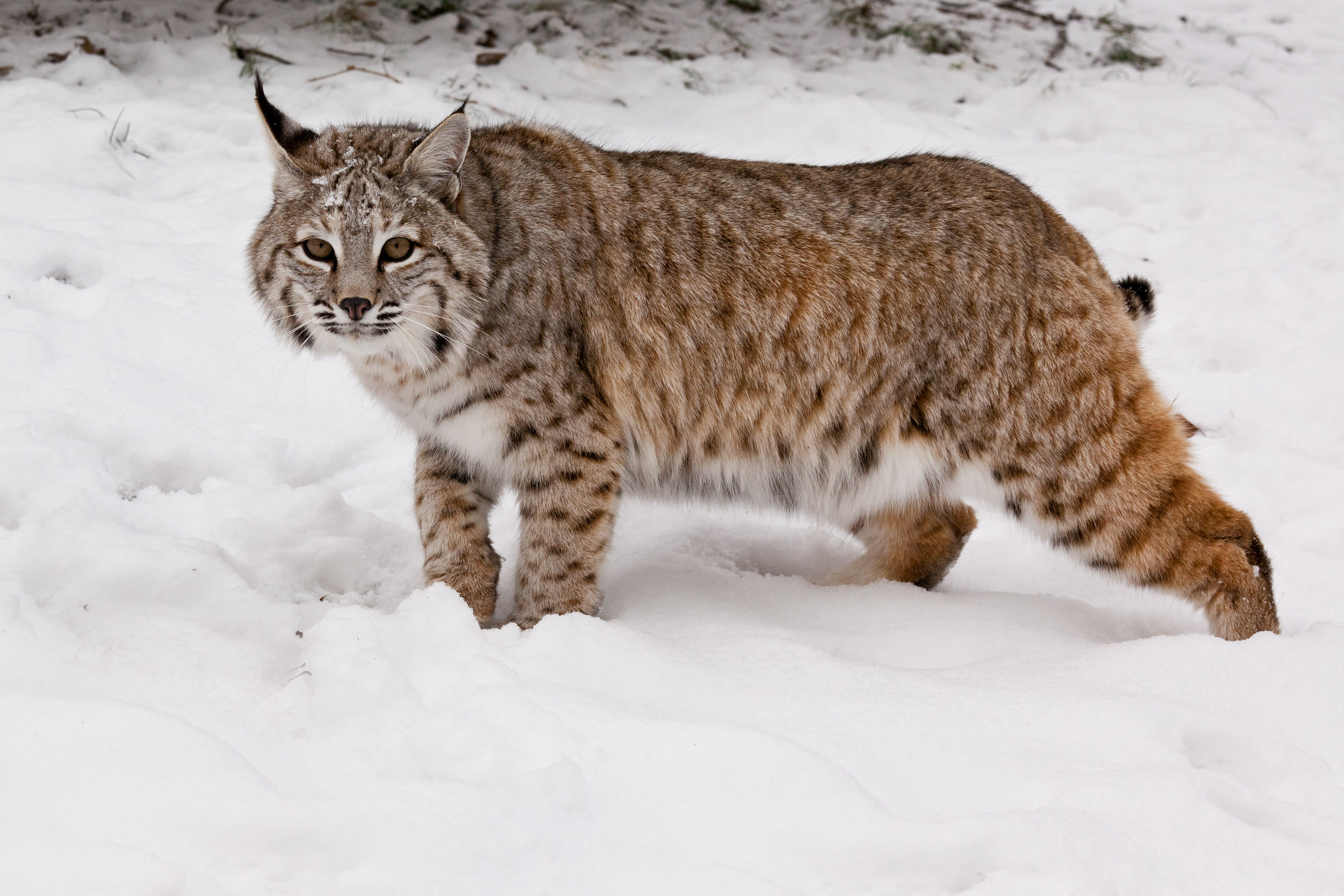
Iowa
Bobcat, Lynx rufus
As a medium-sized cat, the bobcat is an adaptable predator that lives in various habitats, including forests, aquatic corridors, and urban edges. The bobcat is a fierce predator that can run up to 30 miles per hour, leap as far as twelve feet, and is a skilled swimmer. It prefers rabbits as a primary food source but eats a variety of other prey species, such as various bird species, small rodents, and deer. The bobcat is identified by distinctive black bars on its forelegs and a black-tipped, stubby, or “bobbed” tail. Superb night vision and strong scent capabilities help them become excellent hunters in low-light environments.
Range:
The bobcat is native to North America and found throughout the continent.
Where to see:
There is now a multitude of places to have the opportunity to see bobcats, especially in the southern part of Iowa, like the Land of the Swamp White Oak, a high-quality floodplain project area in Muscatine County, or Grand River Grasslands, an important prairie ecosystem in south-central Iowa. Bobcats are common in the western part of the state and can be found at Broken Kettle Grasslands Preserve and throughout the Loess Hills.
Conservation approach:
Bobcats were once common throughout Iowa but quickly diminished and were extirpated from most of the state in the early 1900s due to habitat degradation and unregulated hunting. By the late 1970s, bobcats became a protected species and were listed as endangered on Iowa’s threatened and endangered species list. State protection allowed bobcat populations to expand and grow slowly naturally, and by the early 2000s more sightings in Iowa began to occur, mainly in the southern portion of the state.
Significance for habitat/biodiversity:
Bobcats are effective predators of any habitat and play an essential ecological role in helping control small herbivores such as rodents and rabbits. A highly versatile territorial cat species, bobcats prefer habitats with thick vegetation and ample space for independent home ranges. They require natural shelters, such as outcrops, fallen logs, or dense undergrowth. TNC in Iowa is working to restore contiguous wildlife corridors that protect large tracts of habitat, which will help expand bobcat ranges and grow bobcat populations throughout the state.
Reviewed by Scott Moats, Director of Lands & Fire Manager Iowa/Missouri.
Photo Credit: Kent Mason
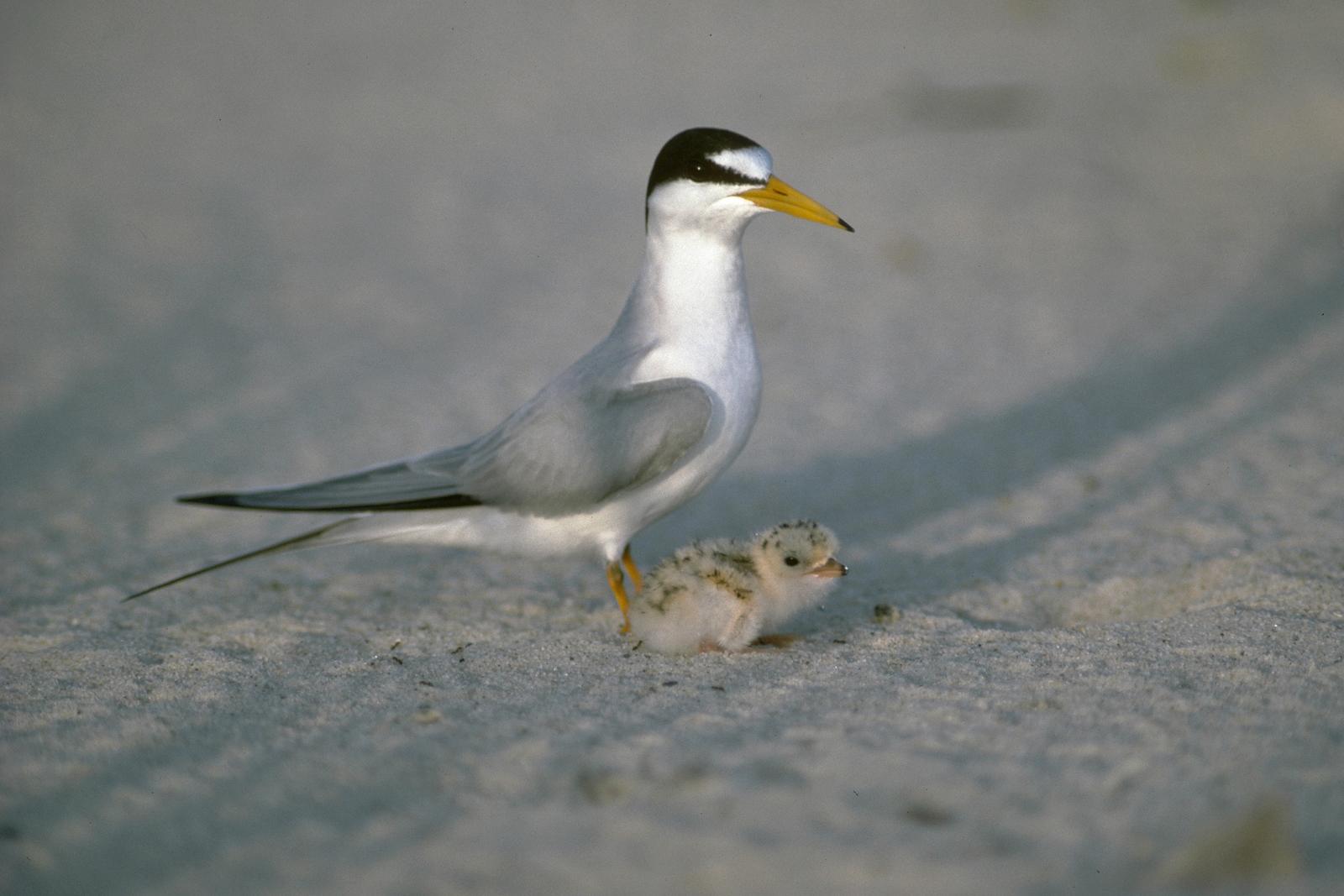
Kansas
Least tern, Sternula antillarum
The least tern is a small seabird, similar to a gull, but with a straight beak. On the eastern and western coasts, least terns stick to sandy beaches, but in the interior United States, least terns use sandbars in rivers, salt flats and gravel islands to nest. The interior population was listed as an endangered species in 1985, but thanks to recovery efforts was delisted in 2021.
Range:
Least terns hug the west and east coasts of the United States during breeding and migration and winter in Central America.
Where to see:
Each summer, least terns can be observed along Kansas River, where sandbars provide critical nesting habitat and abundant fish feed adults and chicks alike.
Conservation approach:
Key to recovery for the least tern was determining what the species required for habitat and then preserving and enhancing that habitat. Managing water levels, such as from dam releases, helps prevent the loss of chicks and nests on river sandbars. Restricting human and vehicular access and modifying construction activities within the river system were managed through U.S. Army Corps of Engineers programs. In 2021, the U.S. Fish & Wildlife Service removed the inland population of the least tern from the federal list of endangered and threatened wildlife because of its recovery.
Significance for habitat/biodiversity:
Much like a canary in the coal mine, the decline of birds is often an early warning that something in our natural world needs attention. With least terns, it was clear that the way humans were managing rivers was impacting the bird’s populations—but least terns weren’t the only victim. Bringing back more natural conditions for these rivers saw the recovery of the species but it also benefits other wildlife and improves water quality.
Learn more:
U.S. Fish & Wildlife species profile
Reviewed by Heidi Mehl, director of water and agriculture programs in Kansas.
Photo Credit: Don Sias
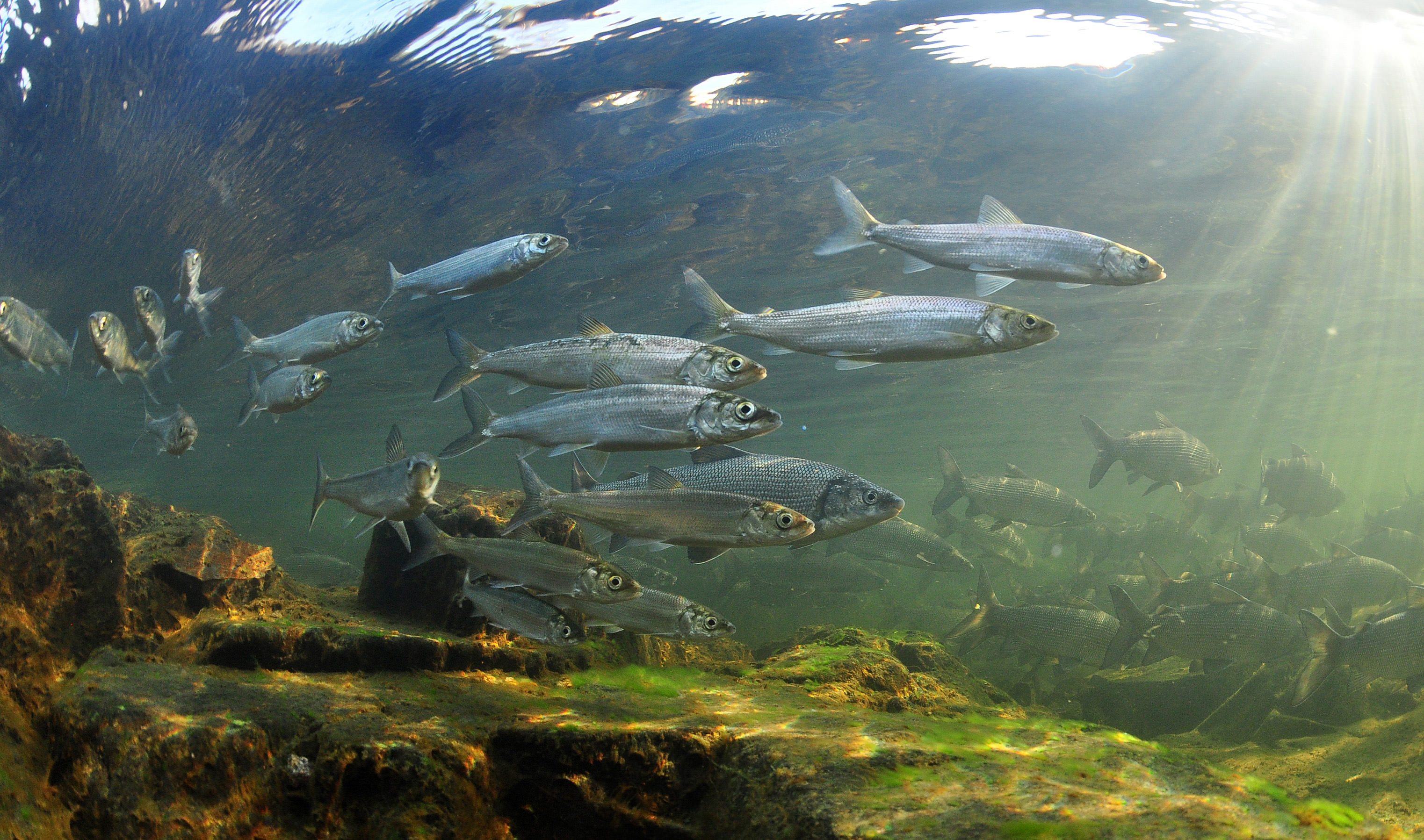
Michigan
Cisco, Coregonus artedi
Cisco are “forage” fish that provides an important food source for larger fish like lake trout. Historically, they were the most harvested fish in the Great Lakes during the commercial fisheries boom of the late-1800s and early-1900s. Cisco require cold-deep water where they feed on zooplankton and sometimes small fish.
Range:
Cisco can be found in the Great Lakes, in cold inland lakes in the Great Lakes Region and throughout much of Canada.
Where to see:
Anglers catch cisco where they are abundant, including Lake Michigan near Elk Rapids and Charlevoix, Michigan, Lake Huron around the Les Cheneaux Islands and Drummond Island, and in the St. Mary’s River. You can catch cisco in some inland lakes, but those populations are highly threatened by pollution and climate change.
Conservation approach:
TNC partnered with the Michigan Department of Natural Resources, the Little Traverse Bay Band of Odawa Indians, Central Michigan University and the Sioux Tribe of Chippewa Indians to study the number of cisco in Lake Michigan beginning in the early 2000s, confirming their numbers and range have increased significantly. Today, partners are continuing to monitor cisco populations and looking for opportunities to restore spawning reef habitat to further help increase cisco populations in Michigan.
Significance for habitat/biodiversity:
From invasive species to overharvesting to environmental degradation, cisco went through it all and the impact it had on their population was devastating. As a forage fish, cisco are an important part of the Great Lakes food web. They are also historically an important food source in the Great Lakes, desired both recreationally and commercially.
Learn more:
Elk Rapids Reef Restoration
Wildlife Action Plan: Great Lakes Ciscoes
Wildlife Action Plan: Inland Cisco Lakes
Resurgence of Cisco in Lake Michigan
Reviewed by Matt Herbert, senior conservation scientist in Michigan.
Photo Credit: Paul Vecsei
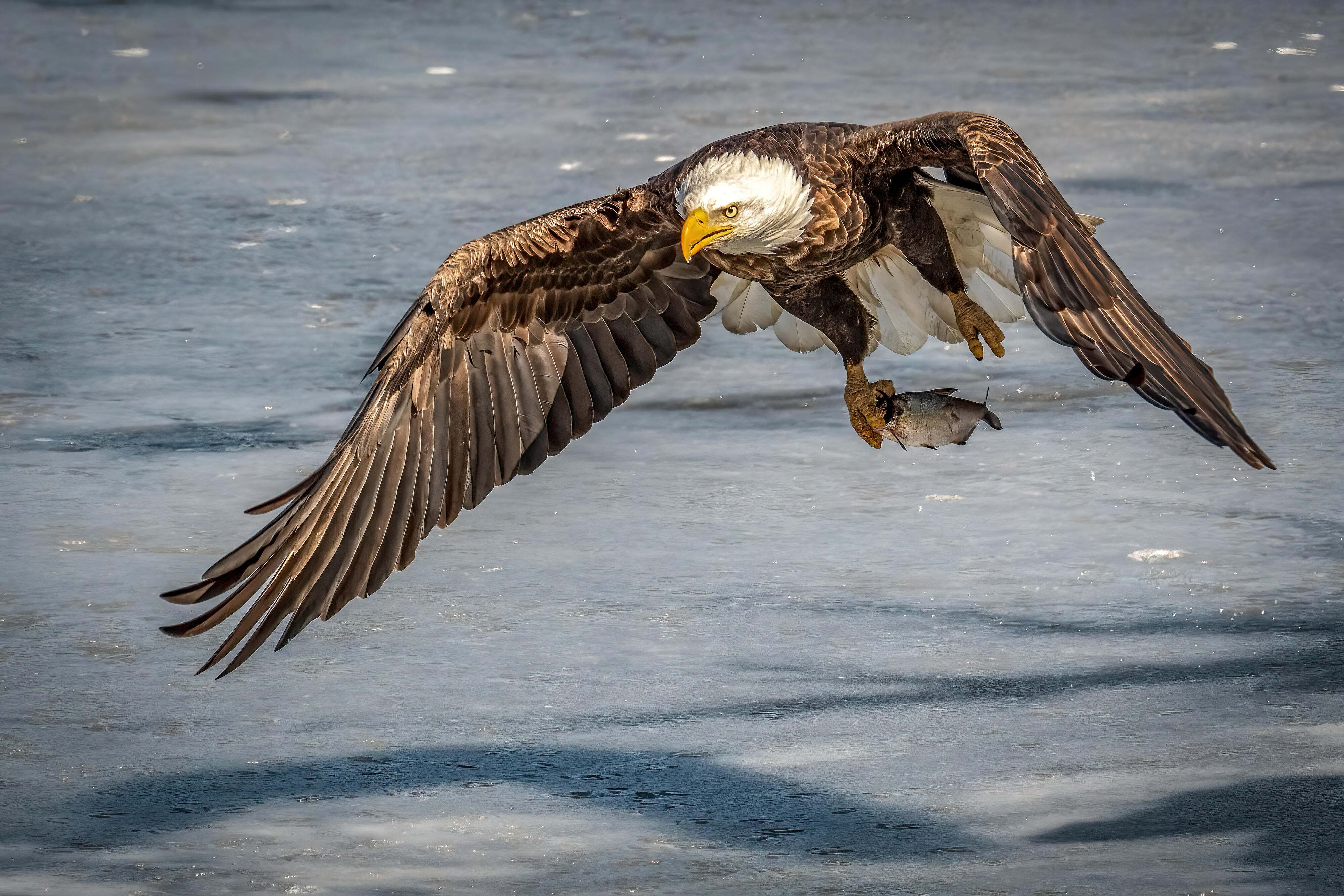
Minnesota
Bald eagle, Haliaeetus leucocephalus
The bald eagle could easily be a poster child for nature's comebacks in the U.S.
Mature bald eagles have the classic white head and tail, yellow and crooked beak, and black body. An adult can weigh more than 13 pounds and have a wingspan of 6 to 8 feet.
Often found around large waterbodies, the bald eagle's diet is mostly fish, but also has an opportunistic diet of mammals, birds and even reptiles.
Range:
The bald eagle's range includes most of North America, including a large part of Canada and northern Mexico. The species can be found in every state in the continental U.S. and all Canadian provinces.
Where to see:
Among many great places to see bald eagles in Minnesota are the Mary Macdonald Preserve at Horseshoe Harbor and St. Louis River.
Conservation approach:
In Minnesota and Wisconsin, which boast the largest populations of nesting bald eagles in the Lower 48, they are especially a point of pride. Decades ago, this national symbol was at risk of extinction due to habitat loss, illegal hunting and widespread use of DDT, a once-popular chemical insecticide. When DDT was banned in the U.S. in 1972, the number of known active nests in Minnesota was just over 100. In the time surveys concluded in 2006, the number of active nests was estimated at more than 1,300 and by 2007 there were an estimated 2,300-plus pairs in Minnesota. In 2007, the bald eagle was officially removed from the U.S. Endangered Species List. Today, TNC proudly works with partners to protect important habitat that benefits bald eagles, including in the Northwoods, the Driftless Area and the Mississippi River’s headwaters area.
Significance for habitat/biodiversity:
As a species that relies on healthy waters, intact and mature forests, and open country, the bald eagle’s success is tied to conservation of many habitats and the diversity of species found within them. Healthy rivers with strong fish migrations are just one example of many ways that sound habitats and biodiversity contribute to this iconic species’ success.
Learn more:
Minnesota DNR: Bald Eagles in Winter
Minnesota DNR: Bald Eagles in Summer
Photo Credit: Marci Lanois/TNC Photo Contest 2022

Missouri
Topeka shiner, Notropis topeka
A native of the Great Plains, the Topeka shiner is a small silvery-green minnow (less than 3 inches long) with a dark stripe, or lateral band, that runs the length of its body. It was placed on the federal endangered list nearly 25 years ago as its natural habitat deteriorated or was destroyed outright.
The Topeka shiner relies on small prairie streams with good water quality and cool temperatures to survive.
Range:
Topeka shiners inhabit parts of six states (Iowa, Kansas, Minnesota, Missouri, Nebraska, and South Dakota) across the Great Plains. They migrate through oxbows and shallow pools of the freshwater streams winding through tallgrass prairies.
Where to see:
The Topeka shiner can be found in the headwaters of Little Creek on TNC’s Dunn Ranch Prairie preserve in Hatfield, Missouri. A recently completed fish passage project on Little Creek, has reconnected the upstream and downstream sides of the creek, allowing the little minnow increased habitat to migrate freely.
Conservation approach:
In announcing the shiner’s designation as an endangered species in 1998, the U.S. Fish and Wildlife Service noted the minnow’s occupied range had declined by an estimated 80%, with half of that decline occurring during the past 25 years.
At the time, the Topeka shiner had dwindled to only two known streams in Missouri.
In 2013, in partnership with the Missouri Department of Conservation (MDC) and the U.S. Fish and Wildlife Service, TNC launched an effort to restore the Topeka shiner to the headwaters of Little Creek on Dunn Ranch Prairie in northern Missouri. Over 5,000 Topeka shiners from a nearby MDC hatchery were released into the Little Creek watershed.
In 2022, TNC completed a fish passage project on Little Creek through the National Fish Habitat Program with U.S. Fish & Wildlife Service. The project restored two creek passages and reconnected more than 5 miles of habitat for the shiner and other fish, continuing the commitment to help protect and restore the Topeka shiner to Missouri’s landscapes. Since completion, TNC has been working with the University of Missouri and the Missouri Department of Conservation to use both color banding and electronic tags to monitor and track Topeka shiners and other fish species. Monitoring data has shown Topeka shiners in both of the restored creek passages, confirming the success of the project.
Significance for habitat/biodiversity:
The Topeka shiner is an indicator species of environmental quality, meaning its decline is a clear signal of a similar decline in the water quality of our prairie ecosystems. Threats to the minnow include stream channelization, dams, sedimentation, oxbow removal, agricultural runoff, and urbanization and development.
Learn more:
U.S. Fish and Wildlife Service species profile
Reviewed by Rob Hunt, TNC’s director of resilient waters in Missouri.
Photo Credit: Kimberly Emerson, USFWS
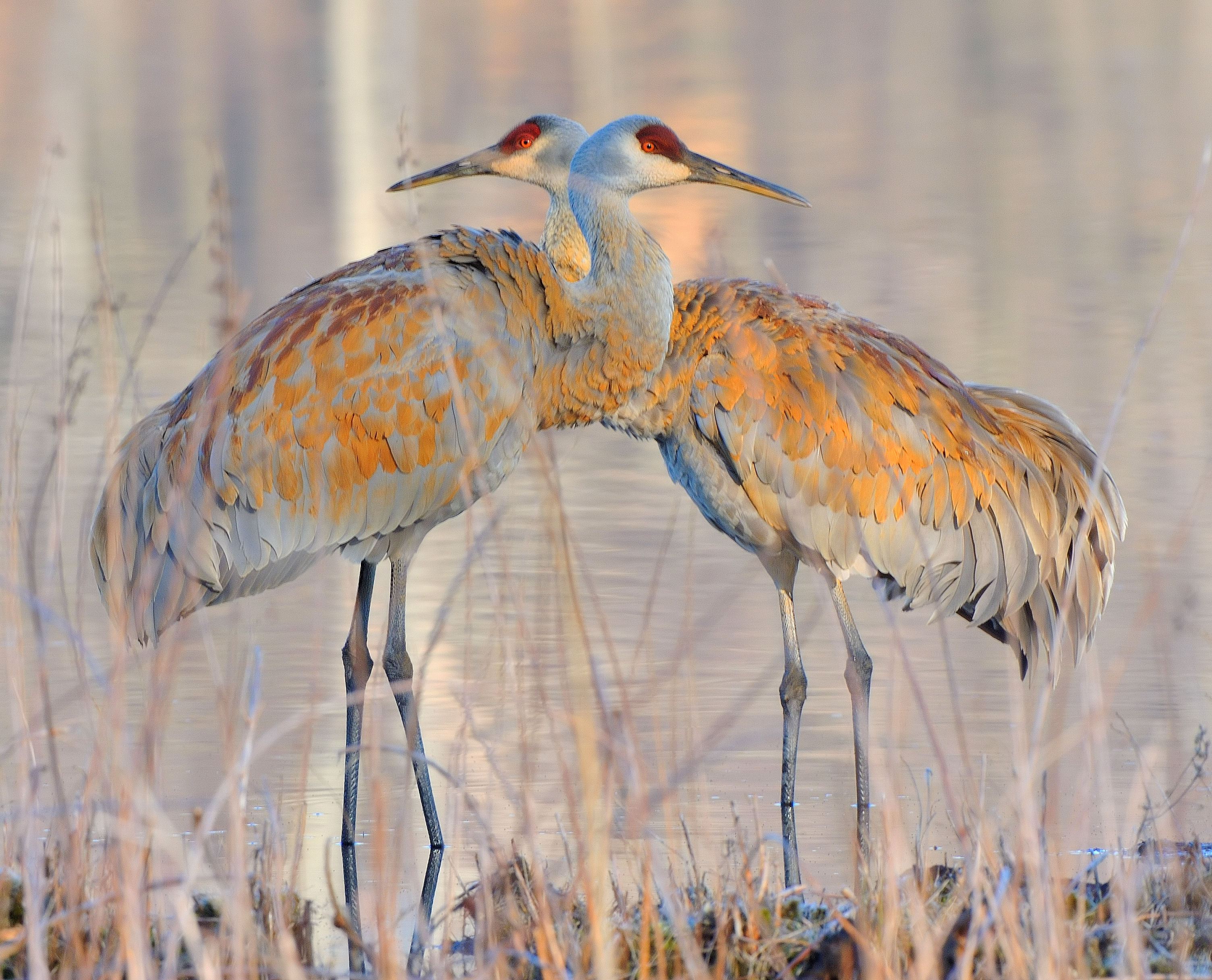
Nebraska
Sandhill cranes, Grus canadensis
The sandhill crane is a large migratory species of crane that can be found throughout North America. The common name of this bird refers to the habitat it prefers, much like that found along the Platte River in Central Nebraska.
Range:
Wintering sandhill cranes can be found throughout the southwestern U.S. and migrate to their breeding grounds to nest in the northern U.S., Canada, and even Siberia. With several migratory populations of sandhill cranes, the mid-continent population that comes through Nebraska is the largest, with 80% of all sandhill cranes in the world in that population.
Where to see:
A fascinating hourglass migration flight pattern brings cranes to Nebraska between February and April, with mid-March being the peak of the migration. Onlookers can marvel at the spectacular view of more than 1 million birds found along 70 miles of the Central Platte River, like at TNC’s Platte River Prairies, as the cranes rest and refuel for up to three weeks before they continue their northward migration.
Conservation approach:
Among the threats to the survival of migratory sandhill cranes are the loss of wetland habitats and unregulated hunting, especially in the early 1900s. According to the North American Breeding Bird Survey, their populations have been increasing at an annual rate of 5% per year since the mid-1960s, due to wetland restoration and abundant food on agricultural lands.
Significance for habitat/biodiversity:
Sandhill cranes rely on bare river sandbars for overnight roosting and both crop fields and prairies for daytime feeding. TNC in Nebraska works diligently with partners to maintain river water levels in the Platte River and prevent invasive plants from taking over sandbars. Through stewardship and land management, TNC is successfully protecting over 3,000 acres of land to support a healthy Platte River ecosystem essential for sandhill cranes for years to come.
Reviewed by Chris Helzer, Director of Science.
Photo Credit: Jim Ridley/TNC Photo Contest 2009
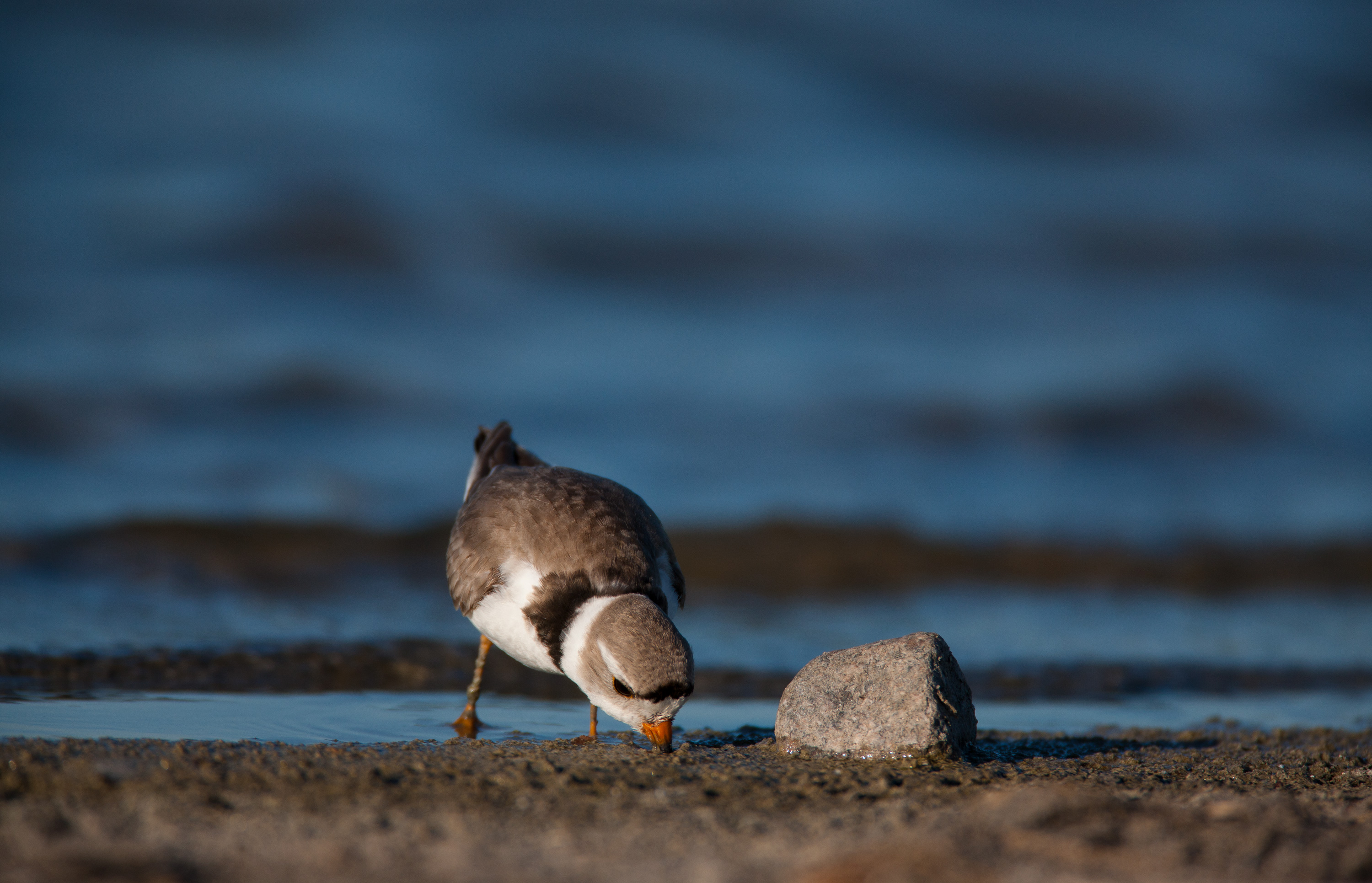
North Dakota
Piping plover, Charadrius melodus
Barely the size of a sparrow, the piping plover is well-disguised among the sands of its habitats along North America's coastal shores and gravel beaches. As a ground-nester on the beach, piping plover eggs and chicks are vulnerable to predation by mammals and other birds. Competition with many human uses in nesting areas can also lead to nesting failure or chick mortality. Since 1985, Northern Great Plains and Atlantic Coast populations have been listed as threatened, and populations in the Great Lakes watershed listed as endangered.
Range:
Piping plovers are found in the Great Plains, where they are federally designated as threatened, and in the Great Lakes and Atlantic coast, where they are endangered (map).
Where to see:
In North Dakota, a good place to see piping plovers is the John E. Williams Preserve near Turtle Lake.
Conservation approach:
Piping plovers have very specific requirements for their breeding grounds. TNC established John E. Williams Preserve near Turtle Lake, ND, to protect one of best sites for breeding piping plovers, as the preserve’s gravelly beaches along its alkali lakes provide ideal conditions. Here, TNC is working with experts to develop cost-effective methods to restore habitat and increase the number of nesting plovers at Williams Preserve, including the use of prescribed fire.
Significance for habitat/biodiversity:
At John E. Williams, the combination of salty deposits and fluctuating water levels creates large barren areas attractive to piping plovers. The preserve is also attractive to other species, including American avocet, marbled godwit and white-faced ibis.
Reviewed by Chris Gordon, Land Steward/ND Fire Manager.
Photo Credit: Richard Hamilton Smith
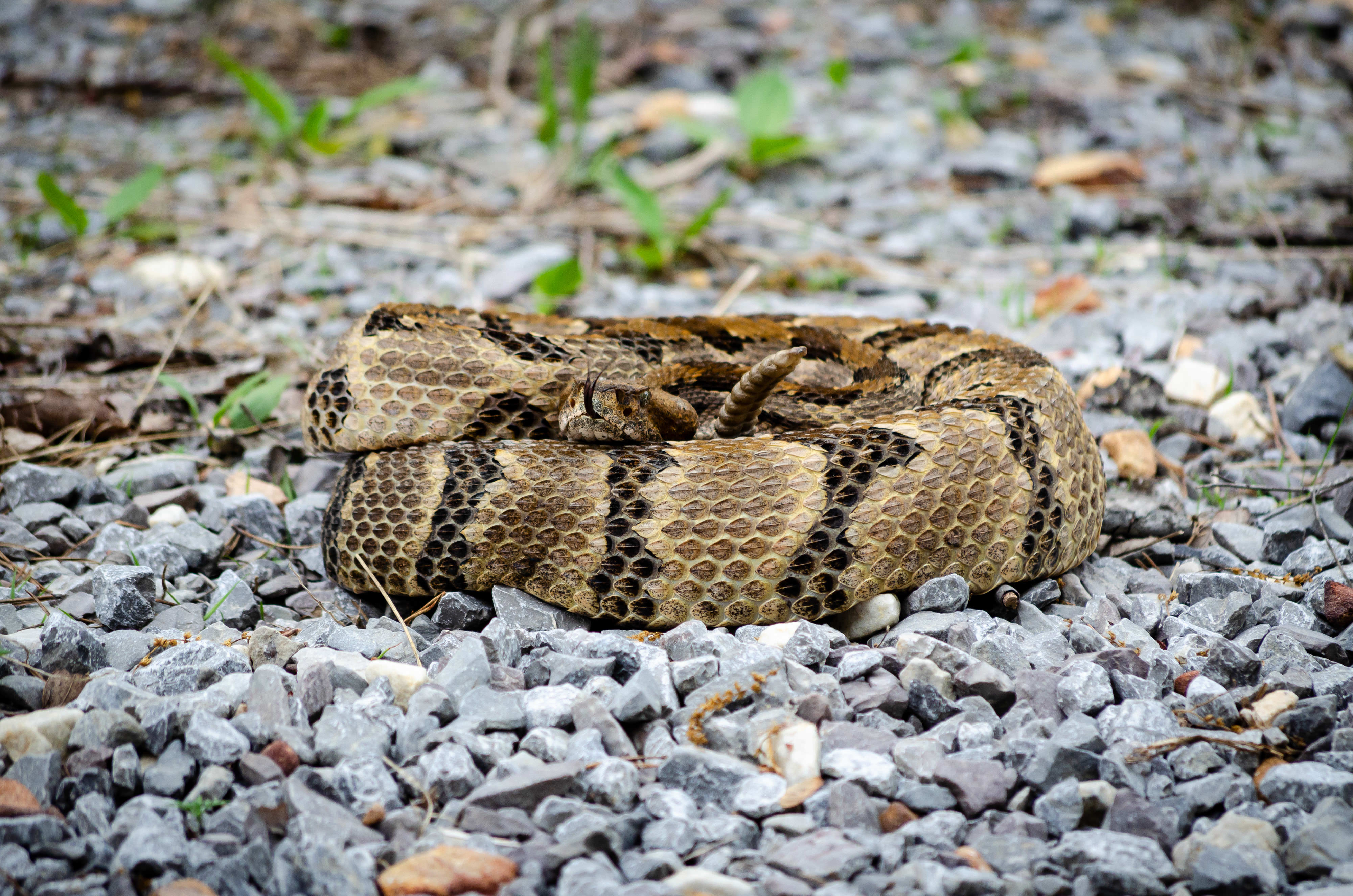
Ohio
Timber rattlesnake, Crotalus horridus
Timber rattlesnakes are stocky, venomous snakes that grow up to 3 to 5 feet long. Their patterned coloration can range from yellow to dark brown, and they have triangular heads with vertical pupils. They prefer deciduous forests with rocky terrain and canopy openings where they can bask in sunlight.
Range:
South central New Hampshire west to southeastern Minnesota and south to eastern Texas and northern Florida.
Where to see:
Staff from TNC and the Cincinnati Museum Center are working together with state and private research team members to research and protect populations of timber rattlesnakes at the Edge of Appalachia Preserve in Adams County, Ohio.
Conservation approach:
Through field surveys and using telemetry, the team located and tracked a timber rattlesnake on protected land within the Edge of Appalachia Preserve System in 2019. The tracking confirmed timber rattlesnakes using overwintering dens alongside other reptile and amphibian species within the preserve. Long term camera monitoring of these den sites has revealed greater numbers of the species than was previously known. Protecting these dens and overwintering sites is critical to supporting the species.
Significance for habitat/biodiversity:
Timber rattlesnakes were once revered and respected by Indigenous Peoples and early Europeans alike. The species was viewed as an important part of the natural system in which they occurred. Today, TNC is working to protect their habitat while helping to educate Ohioans about their importance to the forests of Ohio.
Reviewed by Rich McCarty, Edge of Appalachia Naturalist.
Photo Credit: Jacob Ian Wall, CC BY-NC 2.0
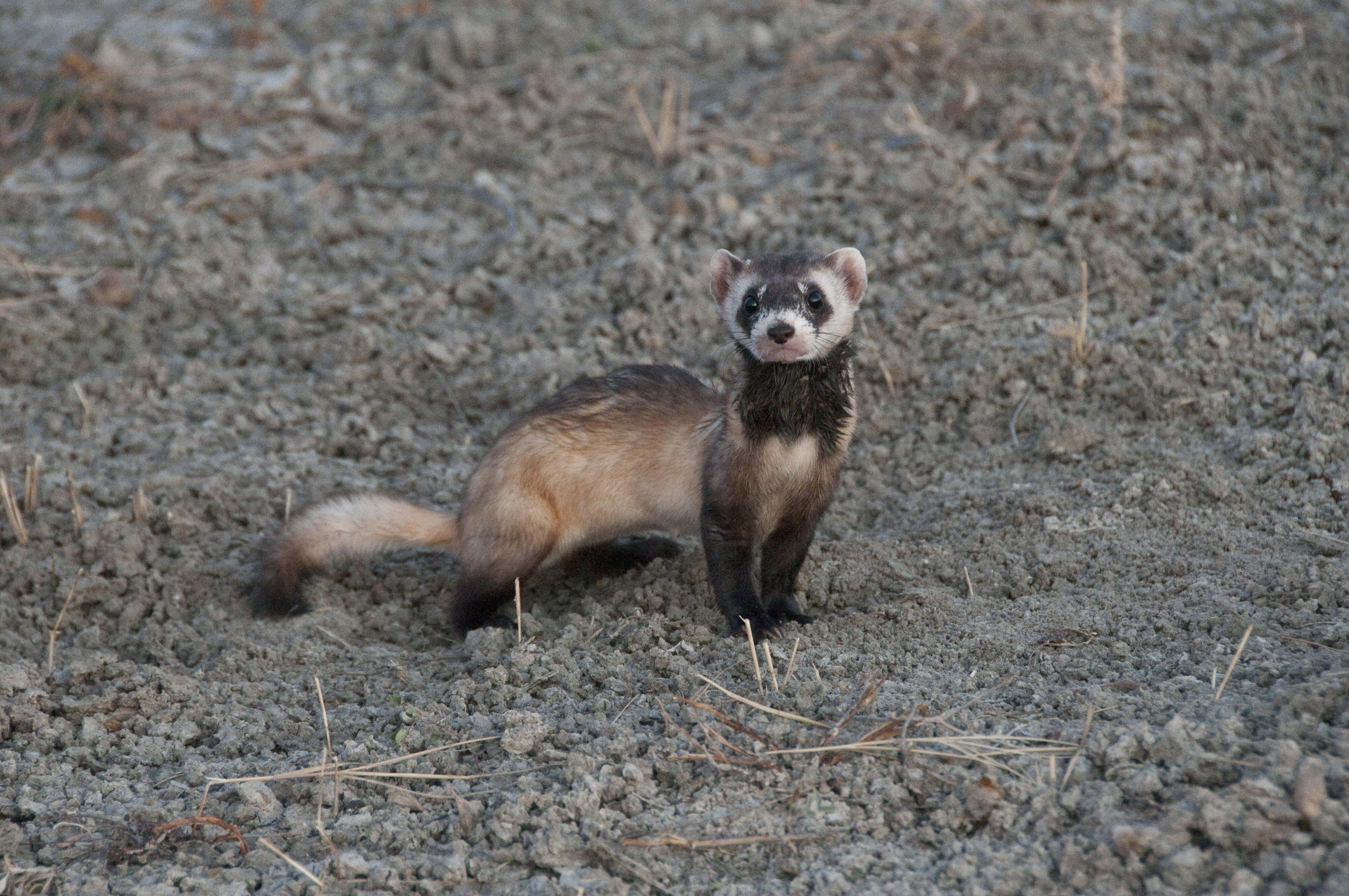
South Dakota
Black-footed ferret, mustela nigripes
This member of the weasel family is about the same size as a mink, about 18 to 24 inches long and weighing less than 3 pounds. It is the only ferret native to the Americas, and once inhabitated a vast part of North America. They live only among prairie dog colonies and can't survive without the prairie dog.
While only an estimated 300 individual black-footed ferrets exist, this was a species that was thought to be extinct. Thanks to ambitious and persistent conservation efforts, there are signs of success and hope for the black-footed ferret.
Range:
Historically the black-footed ferret’s range extended across the Great Plains as far north as Saskatchewan and as far south as Chihuahua. Today, small populations can be found in and near Badlands National Park in South Dakota, and other reintroduction sites in Wyoming and Montana.
Where to see:
Conata Basin in the Badlands of South Dakota supports one of the largest self-sustaining populations of black-footed ferrets.
Conservation approach:
A small population of black-footed ferrets was discovered in 1981 on a Wyoming rancher’s land. Collaborative efforts by governments, NGOs, local groups and landowners have resulted in successful efforts to reintroduce the animal in select regions, through captive breeding, habitat protection, including land protected by TNC within Conata Basin, and disease management.
Significance for habitat/biodiversity:
Because black-footed ferrets depend on prairie dogs for both their food and habitat, grassland restoration has been a critical component in bringing them back. Conservation partners have also focused on disease management, as sylvatic plague and other diseases have taken a toll on black-footed ferret populations.
Reviewed by Julie Brazell, Conservation Coordinator.
Photo Credit: Bill Allen
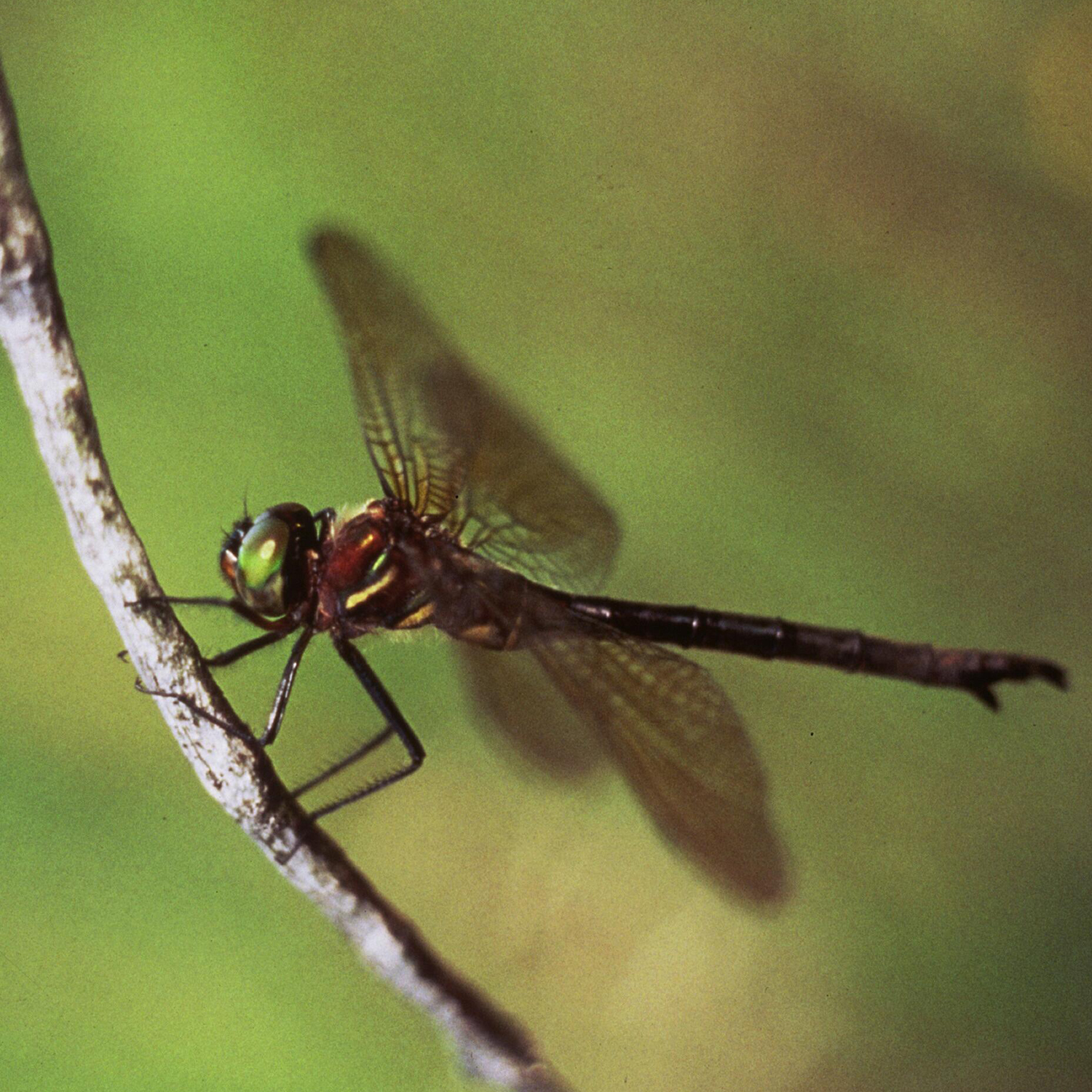
Wisconsin
Hine’s emerald dragonfly
Somatochlora hineana
Thought to be extinct since the 1930s, an adult Hine’s emerald dragonfly was discovered at a TNC preserve in Door County, Wisconsin, in 1987. This rare dragonfly only lives for three to five years and spends most of its life as a larva, which lives in small streams fed by groundwater.
Range:
Parts of Illinois, Michigan, Missouri, Wisconsin and Ontario, Canada.
Where to see:
TNC’s Door County preserves—Mink River, Kangaroo Lake, Shivering Sands and North Bay-Mud Lake—are all home to Hine's emerald dragonflies. Door County hosts the greatest abundance of this endangered dragonfly in the world.
Conservation approach:
This dragonfly is both state and federally endangered, so state and federal agencies are key to conservation efforts. TNC has played an important role by supporting years of research on the animal’s life cycle and habitat needs. We are using this information to protect groundwater recharge areas and larval habitat. This strategy is key to the species’ survival.
Significance for habitat/biodiversity:
Among the major threats to the dragonfly are groundwater contamination and depletion, especially from nearby development. These same groundwater resources also provide well water for residents. Bringing attention to this species is a way to get people thinking about the larger systems that both dragonflies and people need to survive and inspiring action to protect them.
Learn more:
U.S. Fish and Wildlife Service species profile
Reviewed by Mike Grimm, TNC’s conservation ecologist in northeast Wisconsin.
Photo Credit: Kathy Kirk
Endangered & Recovering Species in Southern States
Select the photos to discover more about plants and animals in your state and across the country!

Alabama
Red Hills salamander
Phaeognathus hubrichti
The Red Hills salamander is listed as threatened by the U.S. Fish and Wildlife Service. It is approximately 10 inches long, dark brown to dark gray, and is typically found on north-facing steep slopes of ravines and bluffs dominated by hardwood trees.
Range:
The salamander’s entire global distribution is confined to six Alabama counties. It is the official state amphibian of Alabama.
Where to see:
TNC has worked for many years to protect the Red Hills in Alabama, a part of the state’s Forever Wild Land Trust.
Conservation approach:
TNC and our public and private partners are working to protect and restore enough Red Hills habitat to result in the removal of the Red Hills salamander from the federal Endangered Species List. Not coincidentally, such a plan would allow TNC to protect the best of the Red Hill’s unique habitats and many of its other rare or unique species.
TNC has a goal of preserving some 30,000 acres in the Tallahatta Bluffs region over the next decade, and is working with landowners on agreements to protect some 25,000 acres along Big Flat Creek, one of the largest and healthiest Red Hills streams.
Significance for habitat/biodiversity:
There are many Red Hills forest types, but one of the most unusual forests of the region combines Appalachian and tropical diversity in surprising ways. The forest along the slopes is often described as a “beech-magnolia” forest. These forests are unusually rich in oaks, hickories, and many other species, but it’s the unusual spectacle of giant beech trees (a symbol of Northern forests) growing happily side by side with towering evergreen Southern magnolias that gives this forest type its name.
The understory has a wide variety of flowering trees and shrubs that many people may associate with forests much farther north, such as mountain laurel, rhododendron, sourwood, mountain hydrangea and leatherwood (Dirca). But these plants grow beside some very unusual, virtually subtropical plants, such as the highly fragrant Florida anise (a member of one of the oldest families of flowering plants), titi (Cyrilla), and lily-like members of the amaryllis family (Hymenocallis and Zephyranthes).
Learn more:
Alabama Forever Wild: The Red Hills Tracts.
Photo Credit: USFWS

Arkansas
Diana fritillary
Argynnis diana
The state butterfly of Arkansas, Diana fritillary is a large, showy butterfly, once considered at high-risk for extinction in Arkansas. It is dimorphic, with males displaying black near the base of the wings and orange at the outer portions of the wings (on the upper side), and females black at the base with blue on outer parts of the hindwing.
Range:
In Arkansas, Diana fritillary are found in the Ozark Mountains, Ouachita Mountains, Arkansas River Valley and Upper West Gulf Coastal Plain. It is also known from the Ozark Mountains in Missouri and eastern Oklahoma and the southern Appalachian Mountains of Virginia, West Virginia, Georgia and Alabama.
Where to see:
Many TNC preserves now support populations of this species, including Presson-Oglesby Prairie Preserve in the Arkansas River Valley and Columbus Prairie Preserve in the Blackland Prairie Ecosystem in Southwest Arkansas. Look for males and females flying for about a month in late May and June. Females become active again in September and October when they lay eggs.
Conservation approach:
Over the past 30 years, TNC and partners have focused heavily on reintroducing fire as a natural disturbance in the state’s ecosystems. This has restored hundreds of thousands of acres of open habitat, including prairie, glades, savanna and open woodlands. Thanks to this effort, populations of Diana fritillary have rebounded and there is no longer a need to list it as threatened or endangered.
Significance for habitat/biodiversity:
Availability of good nectar sources throughout summer and into the fall is important for this species, especially for females which live longer than males. These nectar sources can be found in greater abundance in open, native habitats like tallgrass prairies and glades. Meanwhile, the Diana’s host plants are several species in the genus Viola (violets), many of which are found in wooded and forested areas. Therefore, effective conservation of this species stresses the importance of natural ecotones, landscape mosaics and reoccurring fire, which increase biodiversity and benefit natural communities and other species of conservation concern.
Learn more:
For photos, general species information, and recent sightings, see the taxa page on iNaturalist or the U.S. Fish and Wildlife Service species profile.
Reviewed by Melanie Rudolf, Terrestrial Ecologist Manager who oversees the Monitoring, Measures and Adaptive Management Program for the Arkansas Chapter.
Photo Credit: “Diana Fritillary” by Aaron Beam, iNaturalist, CC BY-NC 4.0
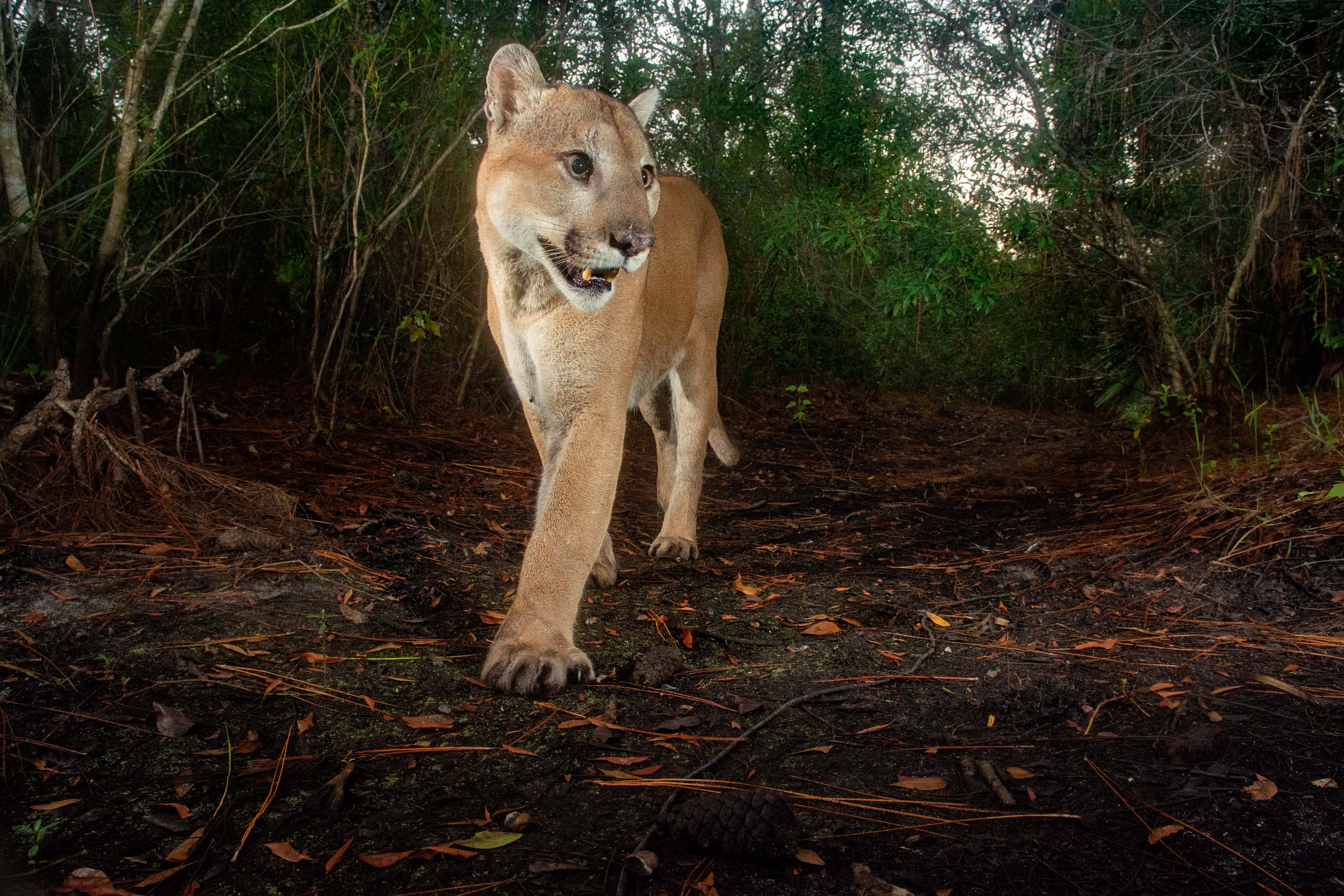
Florida
Florida panther, Puma concolor coryi
The Florida panther is a puma subspecies that is only found in southwest to south-central Florida and nowhere else on earth. With a population estimate of about 200 adults and subadults, it’s one of the most endangered mammals in the country.
Range:
The panther’s range once spanned the entire southeastern U.S. but today they are confined to a small area in southwest to south-central Florida that is less than 5% of their historical range.
Where to see:
This elusive and critically endangered species is mostly nocturnal and is rarely seen. They live in the forested habitats found in portions of a handful of counties in southwest and south-central Florida.
Conservation approach:
Land conservation is a high priority for Florida panther protection and TNC has been working for over 30 years to protect lands critical for the Florida panther to thrive into the future. This includes securing protection through conservation easements along both sides of the Caloosahatchee River, which is a vital link for panthers to naturally migrate from lands south of the river into the ranching and natural lands north of the river. TNC and partners have been working to build protected corridors through the purchase of property and conservation easements to provide a connected landscape for panthers to safely roam and move northward to expand their range.
Significance for habitat/biodiversity:
Florida panthers are Florida’s widest ranging land animal, and their large territories are shared with many other species, making them an umbrella species. When we protect land and wildlife corridors for Florida panthers, we are also providing protection benefits to a wide array of plant and animal species that call panther habitat home. Humans also gain from the protection of panther habitat through enhanced and properly functioning ecosystems.
Learn more:
Florida Panthers: Crossing the Caloosahatchee
Planning for the Prowl: Why it’s Rush Hour for the Florida Panther
Reviewed by Wendy Mathews, TNC Florida senior conservation projects manager.
Photo Credit: Carlton Ward Jr.
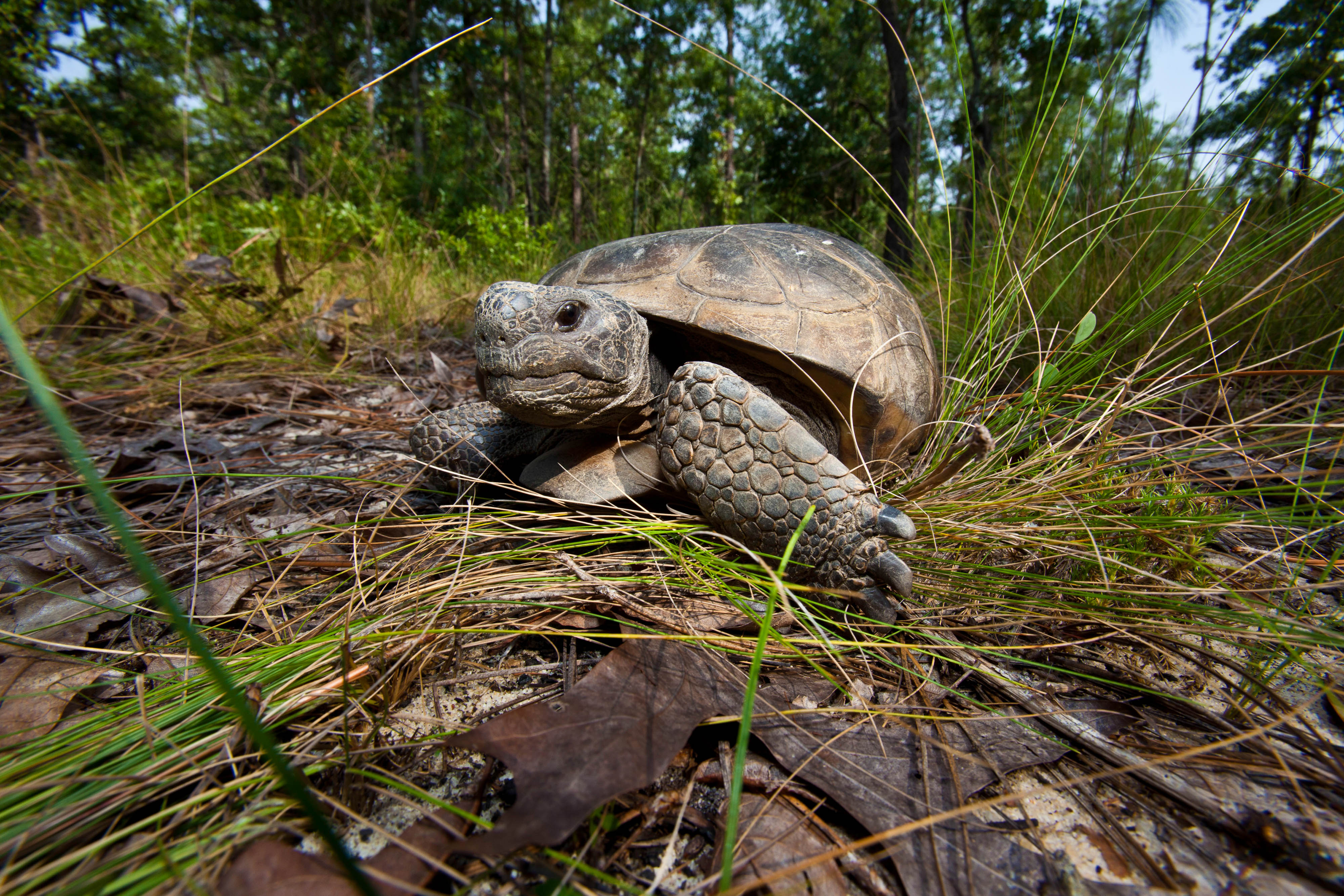
Georgia
Gopher tortoise, Gopherus polyphemus
The gopher tortoise is one of the planet’s oldest living species and the only native North American tortoise species east of the Mississippi River. Georgia’s gopher tortoise population is now near 40,000 individuals, or 61 viable populations, across the state on protected and actively managed lands.
Range:
The gopher tortoise range is from southern South Carolina through the southern half of Georgia, into Florida, and west into southern Alabama, Mississippi and Louisiana.
Where to see:
The gopher tortoise can be found at several TNC preserves and project sites, including:
• Broxton Rocks Preserve
• Charles Harrold Preserve
• Chattahoochee Fall Line
• Moody Forest Natural Area
Conservation approach:
The revitalization of gopher tortoise habitats and populations has been a demonstration in what is possible when environmental partners across the non-profit, governmental, and private sectors work in close partnership. TNC in Georgia is a leader of the Gopher Tortoise Conservation Initiative which includes collaborators such as the Georgia Department of Natural Resources, the Georgia Forestry Commission, Georgia Chamber of Commerce, and dozens of others. Our work has kept the gopher tortoise off of the endangered species list.
Significance for habitat/biodiversity:
Gopher tortoises have large, elephantine hind limbs and flattened, shovel-like forelimbs that are uniquely designed to dig burrows up to 40 feet long and 10 feet wide. At least 300 other species also use their burrows, including rare species such as the Eastern indigo snake, gopher frog, Florida mouse, and hundreds of rodents and invertebrates.
Learn more:
Gopher Tortoise Conservation Initiative
Reviewed by Dan Ryan, Director of Conservation for The Nature Conservancy in Georgia.
Photo Credit: Karine Aigner
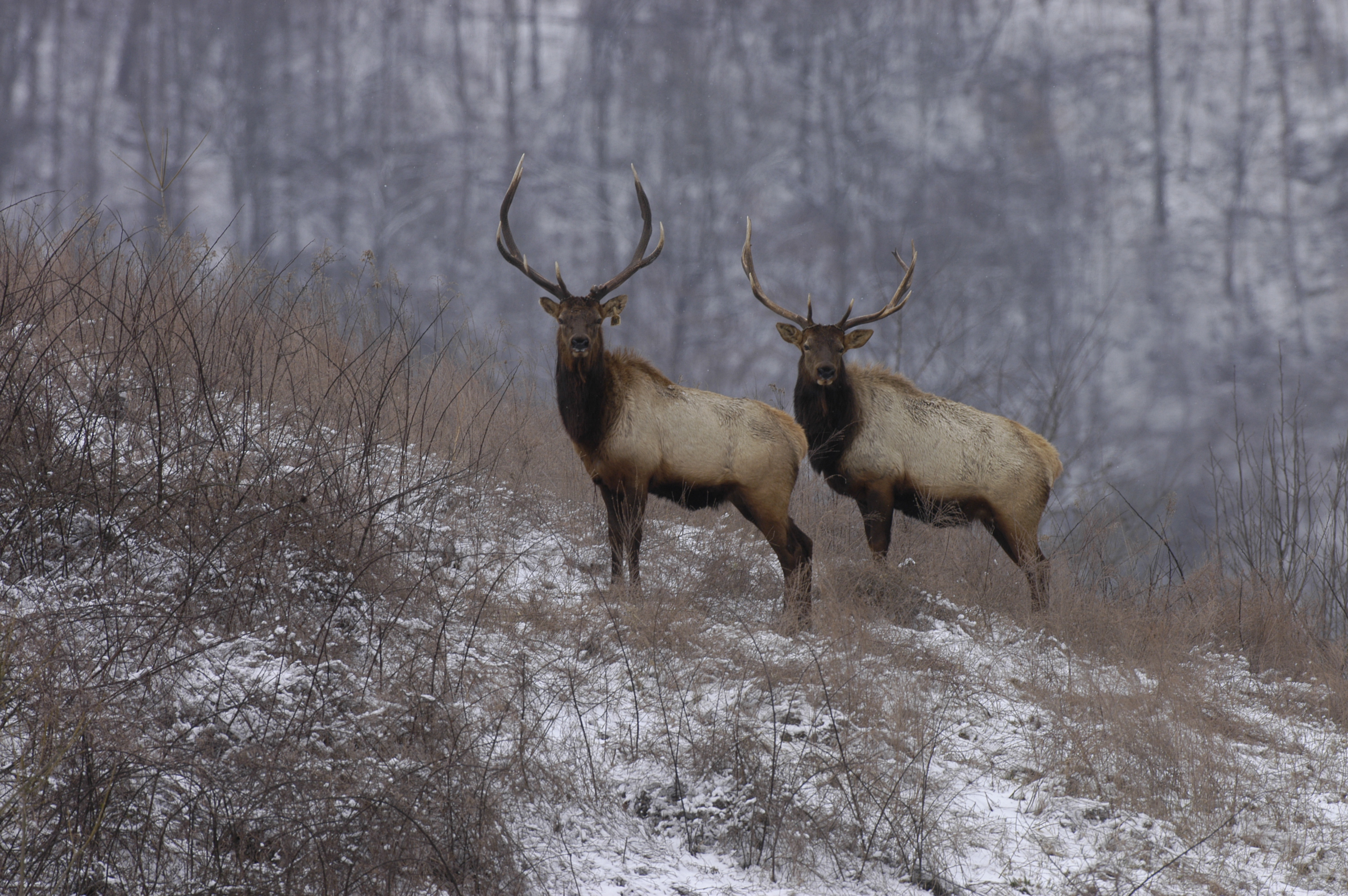
Kentucky
Rocky Mountain elk
Cervus canadensis nelsoni
The Rocky Mountain elk is a subspecies of North American elk. The Eastern elk (Cervus elaphus canadensis) once ranged all over the state of Kentucky, but this subspecies was extirpated by the mid-1800s. When elk were reintroduced to Kentucky by the Kentucky Department of Fish and Wildlife Resources and Rocky Mountain Elk Foundation, beginning in 1997, the subspecies brought over from the western U.S. was the Rocky Mountain elk. These subspecies of elk are genetically similar. Kentucky now has the largest herd of elk east of the Mississippi River.
The Nature Conservancy acquired the Cumberland Forest Project in 2019, including 55,000 acres of prime Kentucky elk habitat where people can once again enjoy elk through wildlife watching, hunting, and the scientific study of this species.
Range:
Rocky Mountains and adjacent ranges of the western U.S., with some relocation areas in the eastern U.S.
Where to see:
Cumberland Forest Project, Jenny Wiley State Resort Park
Conservation approach:
Elk were absent from the Kentucky landscape for more than a century due to unregulated hunting and habitat loss. TNC’s partners reintroduced elk on reclaimed surface mines, which provide the open habitat surrounded by forestland on which elk thrive. The presence of elk on these mine lands has spurred ongoing habitat work by our partners, while TNC’s reforestation efforts on mine lands also benefit the herds. Elk reintroduction has also brought economic benefits to communities in eastern Kentucky.
Significance for habitat/biodiversity:
Many species have benefited from the reintroduction of elk and accompanying habitat improvements. White-tailed deer, wild turkey, ruffed grouse and even songbirds benefit from good elk habitat. The Nature Conservancy’s habitat improvement work on the Cumberland Forest Project includes planting hundreds of thousands of trees and hundreds of acres of forbs, grasses, and wildflowers on former mine lands, creating food and cover not only for elk but many other wildlife species.
Learn more:
Elk Tours
Reviewed by Danna Baxley, director of conservation for TNC’s Kentucky program.
Photo Credit: Dave Baker/Kentucky Department of Fish and Wildlife Resources
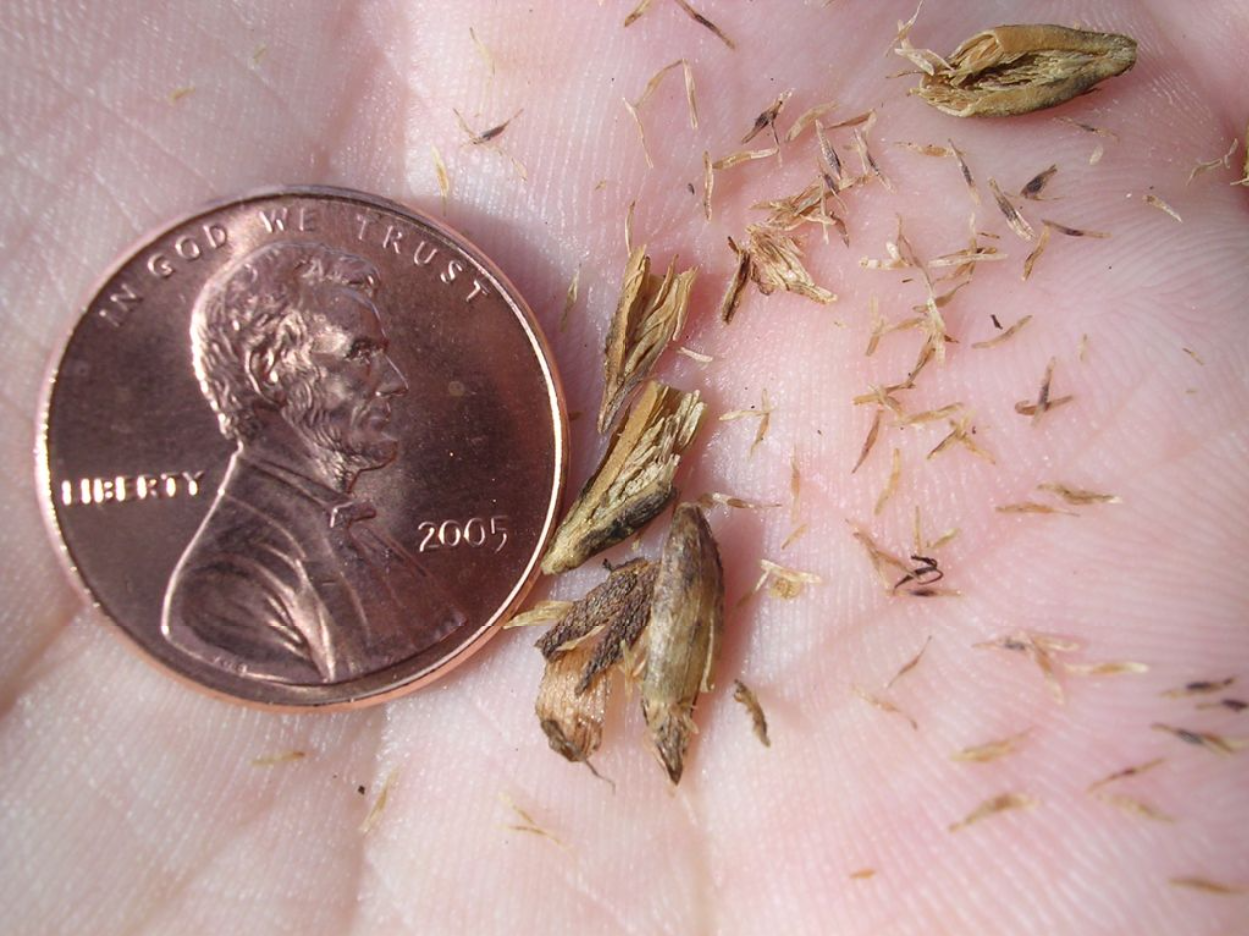
Louisiana
American chaffseed, Schwalbea americana
American chaffseed is a modest-sized herbaceous plant that occurs in moist longleaf pine habitat on naturally occurring low mounds (“pimple mounds”) and is highly dependent on frequent fire. It was listed as a federally endangered species in 1992, and while it continues to decline, there is hope for its comeback through land protection, careful management of its fire-dependent habitat and other measures.
Range:
American chaffseed occurs in seven states along the Atlantic coast: New Jersey, North Carolina, South Carolina, Georgia, Alabama, Florida and Louisiana.
Where to see:
CC Road Savanna Preserve, Louisiana
Conservation approach:
Several state and federal agencies, organizations, and private landowners are working to protect and manage habitat for American chaffseed.
TNC is working to restore native longleaf pine savanna habitat at CC Road Savanna Preserve through removal of off-site pines and hardwoods, replanting longleaf pine, prescribed burning and control of invasive species. On a broader scale, TNC has been partnering with conservation-minded landowners in the near vicinity, who collectively own several thousand acres being restored to native habitats. Our key conservation strategy calls for protection of at least 10,000 acres in this landscape to ensure long-term viability of the savanna habitat and the many species it supports.
Significance for habitat/biodiversity:
American chaffseed is one of many plant species that rely on fire dependent ecosystems—in this case longleaf pine flatwoods. Wildlife species, too, need well-managed longleaf pine forests, such as gopher tortoise and red-cockaded woodpecker. Ensuring the viability of this type of longleaf pine also helps safeguard habitat for those species.
Photo Credit: Peter Pattavina/US Fish & Wildlife Service
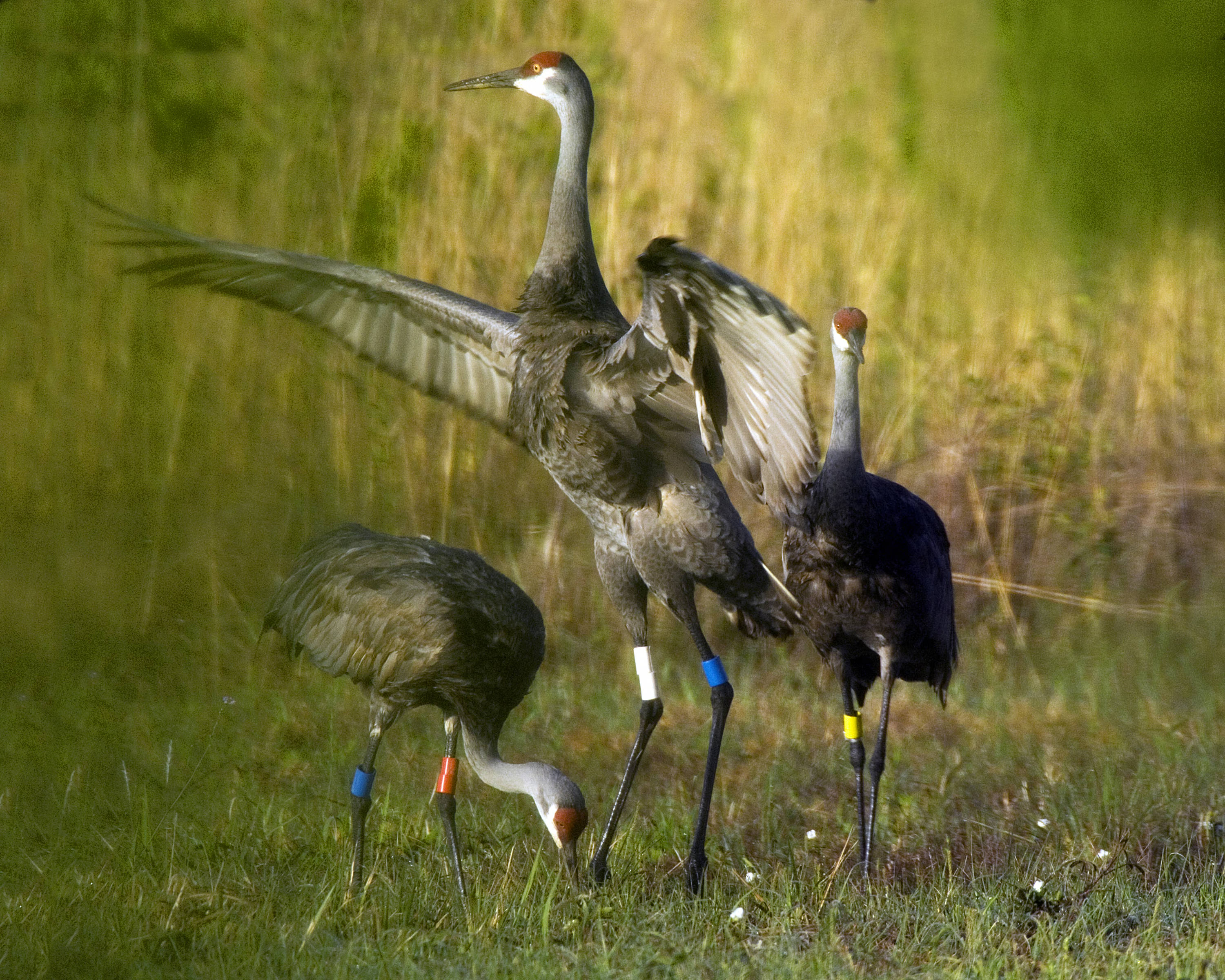
Mississippi
Mississippi sandhill crane
Grus canadensis pulla
About 4 feet tall with a red cap on their heads, Mississippi sandhill cranes are graceful, long-legged birds found exclusively among the wet pine savannas along Mississippi’s Gulf Coast. Unlike their close relatives in the north, this subspecies of sandhill crane does not migrate, but instead stays year-round in the state.
Range:
The cranes are found in wet pine savannas of southeastern Mississippi, east of the Pascagoula River to slightly west of the Jackson County line.
Where to see:
Staff from TNC and the US Fish and Wildlife Service are working together to research and protect populations of Mississippi sandhill cranes at the Mississippi Sandhill Crane National Wildlife Refuge in Jackson County.
Conservation approach:
By the 1970s, the population of Mississippi sandhill cranes had plummeted to only 30-35 birds in the wild, largely due to the loss of their preferred wet pine savanna habitats in southeast Mississippi. To save this species and its home, the Mississippi Sandhill Crane National Wildlife Refuge was created under the authority of the Endangered Species Act in 1975. Since that time, conservationists have been using captive rearing, reintroduction, tracking and monitoring of cranes to help protect and increase their populations numbers. Additionally, because these cranes are homebodies and do not stray far from their wet pine savanna habitat, TNC and other conservation partners are working together to restore and protect the wet pine savannas, primarily through prescribed fire. The paired approach of direct wildlife conservation and habitat protection and restoration has helped the Pascagoula sandhill crane’s population to come back. Today, around 160 Mississippi sandhill cranes live in the wild and their numbers continue to grow.
Significance for habitat/biodiversity:
Much like the Mississippi sandhill cranes, the wet pine savannas that they call home are endangered. As one of the most diverse habitats in the United States, the wet pine savanna is also home to many wildlife and plant species that are native to the Gulf Coast region.
Learn more:
TNC: Stories in Mississippi
Reviewed by Becky Stowe, Director of Forest Programs for TNC in Mississippi.
Photo Credit: Steve Hillebrand/US Fish & Wildlife Service
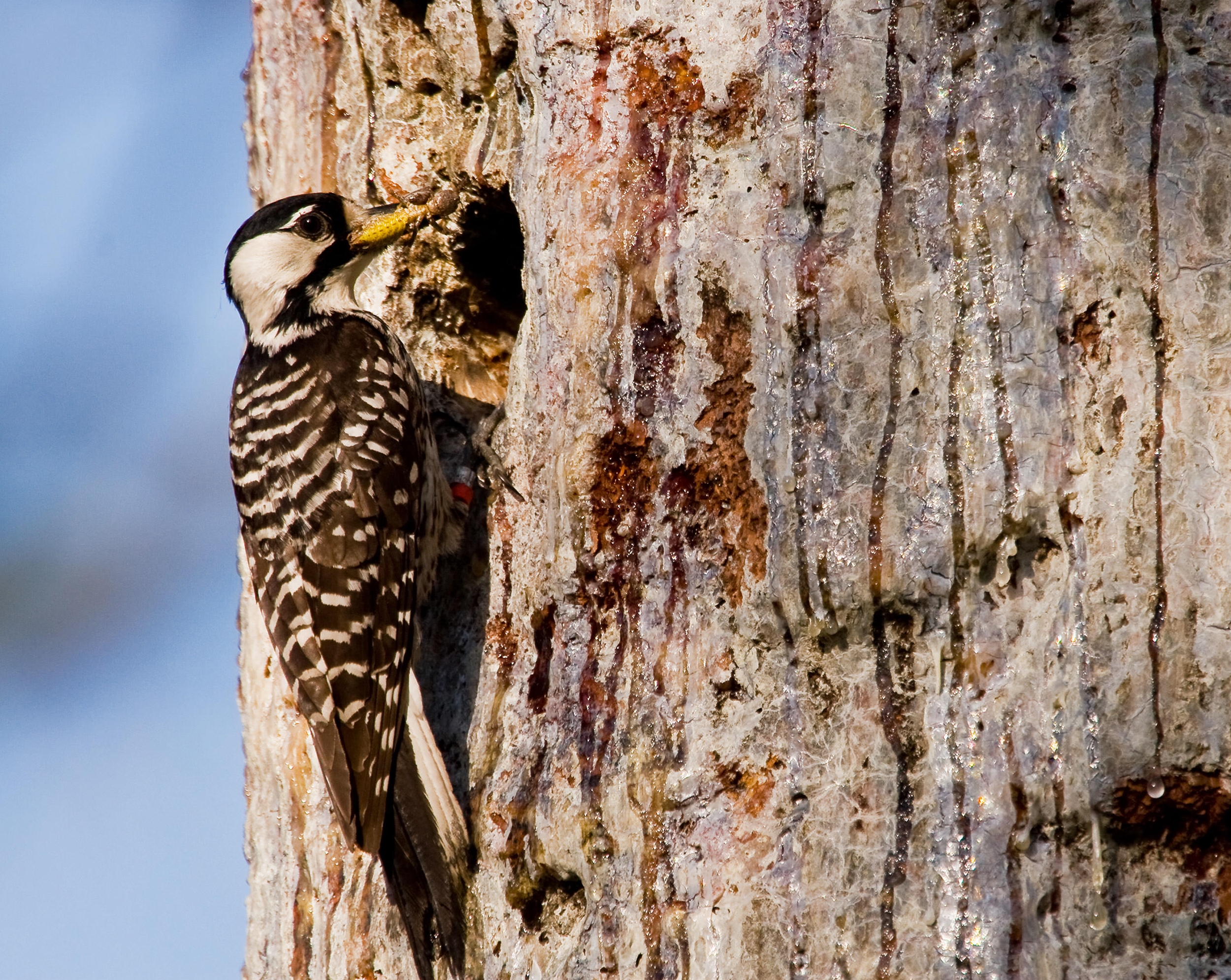
North Carolina
Red-cockaded woodpecker
Leuconotopicus borealis
Red-cockaded woodpeckers live in mature longleaf pine, which was once the dominant coastal-plain tree from southeast Virginia to eastern Texas. As longleaf forest declined, Red-cockaded woodpeckers became the first bird to be placed on the endangered species list. Today its numbers have grown to the point where it may soon be removed from the list.
Range:
Coastal Plain of nine states from Southeast Virginia to East Texas.
Where to see:
Disney Wilderness Preserve
Calloway Forest Preserve
Moody Forest Preserve
Peachtree Rock Heritage Preserve
Piney Grove Preserve
Conservation approach:
Restoring longleaf pine forests, which once covered 90 million acres but shrunk to a historic low of 3.2 million acres, was key to bringing back the red-cockaded woodpecker. TNC is the only organization working across the range to restore longleaf pines, which now span 5.2 million acres, with plantings and controlled burning. Some of the best red-cockaded woodpecker stands remain on military bases. TNC in North Carolina pioneered working with the military to protect, restore, and manage longleaf pine adjacent to Fort Bragg in North Carolina. This approach was also used successfully by TNC in other states to restore red-cockaded woodpecker habitat.
Significance for habitat/biodiversity:
Except for tropical rainforests, longleaf pine is unparalleled for its biodiversity. Protecting and managing longleaf forest has benefited not only the red-cockaded woodpecker, but also a host of other species including gopher tortoises and Venus flytraps.
Learn more:
Nature Magazine: Pine Country
Reviewed by Chuck Peoples, Conservation Director, North Carolina chapter.
Photo Credit: Brady Beck
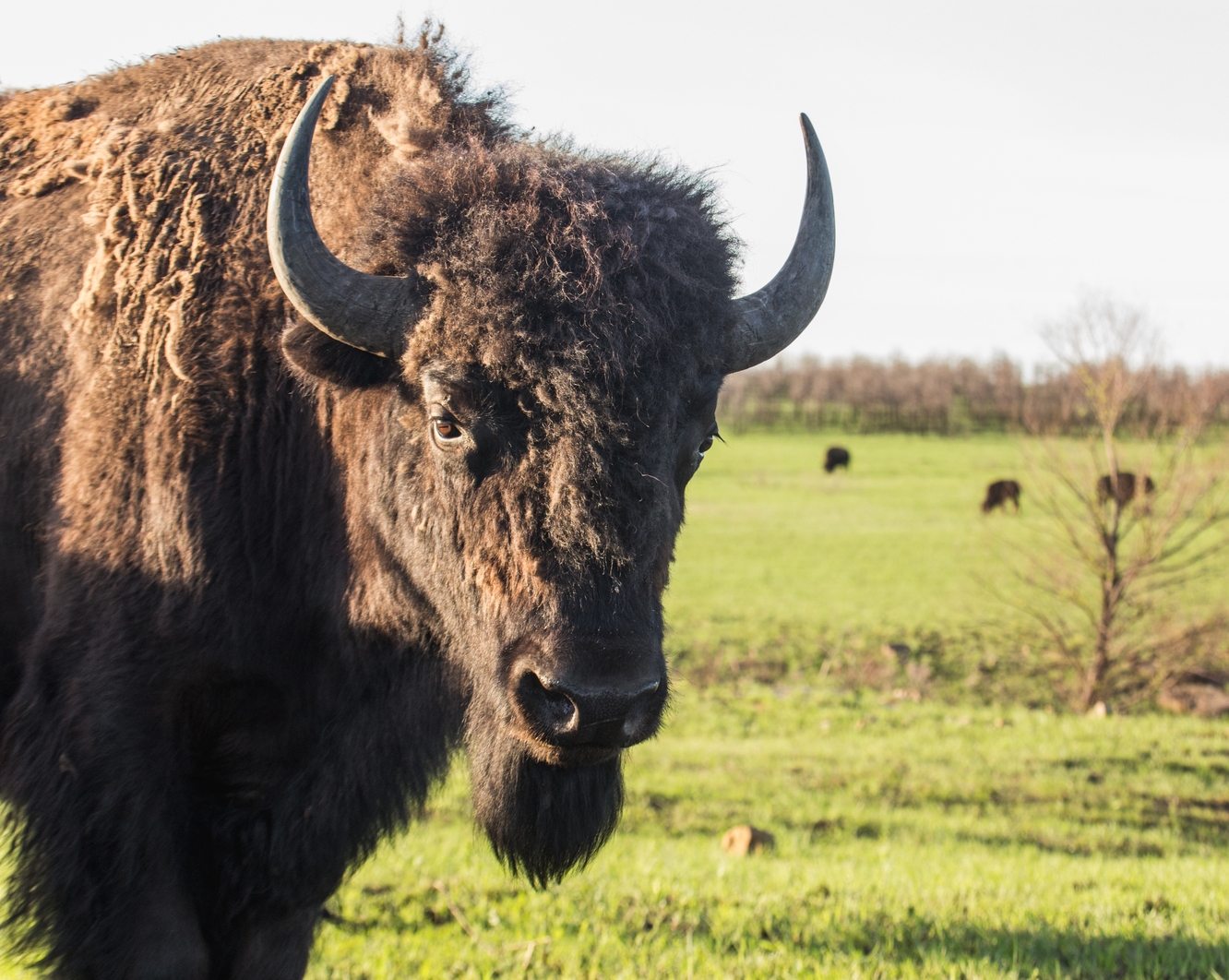
Oklahoma
American bison, Bison bison
Also known as American buffalo, the bison were historically found on the rich grasslands from Alaska to the Gulf of America, east to nearly the Atlantic tidewater and from Georgia to New York. The American bison is an herbivore, grazing on sedges and grasses on the prairies, and can weigh 700 to 2,500 pounds.
Range:
Historically, bison were found throughout North America, and are now an icon of the Great Plains. Today, most bison live semi-wildly on TNC preserves, in national or state parks or forests, tribal lands and in commercial livestock herds.
Where to see:
The Joseph H. Williams Tallgrass Prairie Preserve in Osage County, Oklahoma, is home to TNC’s largest bison herd. Starting with just 300 animals in 1993, the herd has grown to approximately 2,000 head.
Conservation approach:
Although never listed as an endangered species under the U.S. Endangered Species Act, the resurgence of American bison across the Great Plains and beyond is a wildlife restoration success story.
Once roaming from modern day Mexico to Canada, bison thrived. Over-hunting by European colonizers, massive plowing of the prairies and non-native diseases forced bison to the brink of extinction. After the deliberate actions of passionate ranchers, American Bison Society and conservationists, the species has rebounded to over 350,000 animals. TNC manages about 5,500 of these animals.
Significance for habitat/biodiversity:
Grazing and fire are two of the primary ecological forces in the Great Plains, and their interaction is what creates landscape or habitat diversity. The lush green regrowth following a fire is very attractive to grazing bison, resulting in a fire-induced rotational effect. This “pyric-herbivory,” the interaction of fire and grazing, maintained a dynamic mosaic of landscape patches, thus supporting the rich diversity of prairie plants and animals. Bison also add habitat diversity to the prairie by their wallowing behavior which creates shallow basins that serve as temporary wetlands for other wildlife and water-loving plants. Even their thick patches of hair shed during spring is highly sought after by nesting grassland birds and small mammals.
Reviewed by Bob Hamilton, Tallgrass Initiative Director for TNC in Oklahoma.
Photo Credit: Morgan Heim
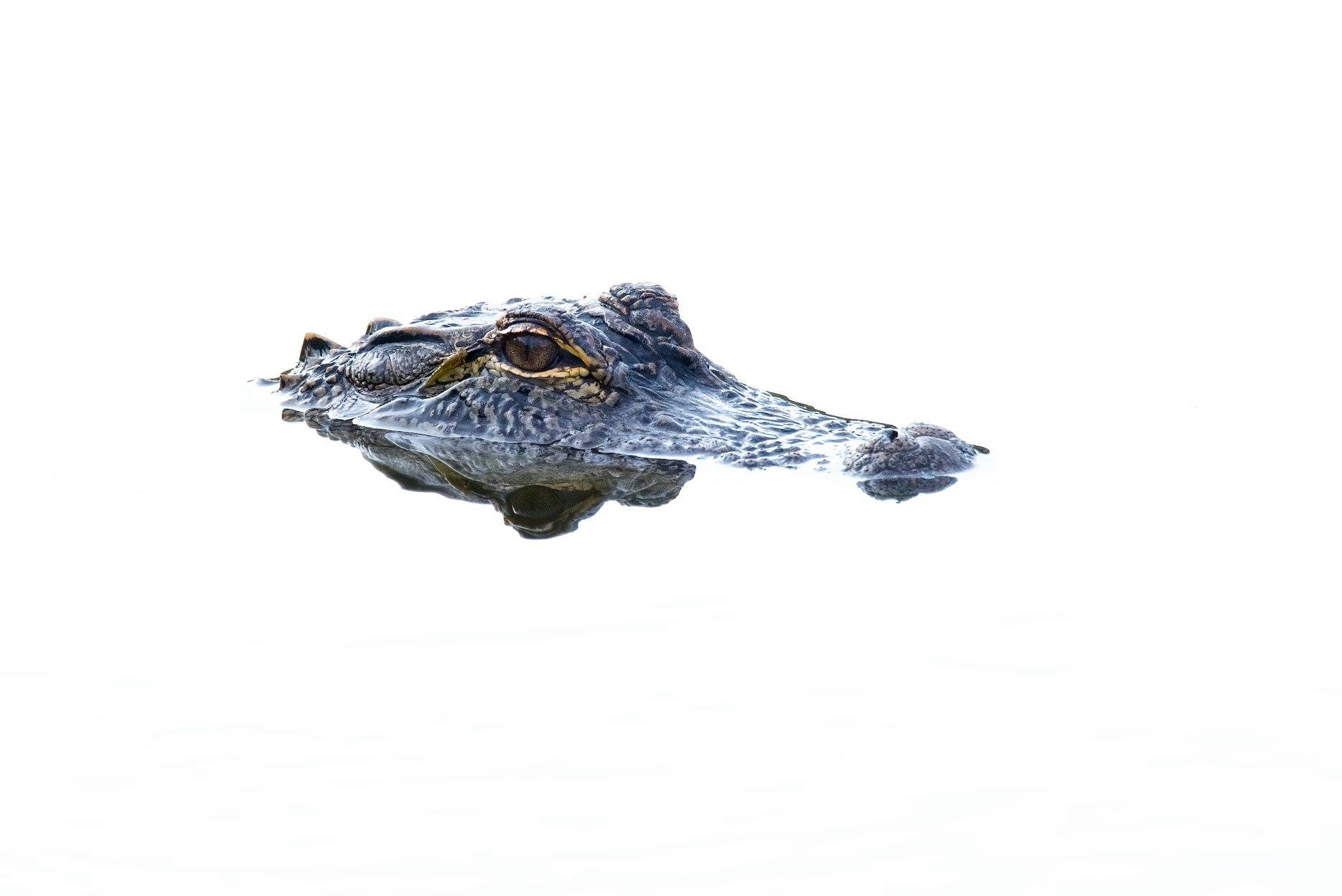
South Carolina
American alligator
Alligator mississippiensis
The American alligator is the official state reptile of Florida, Louisiana and Mississippi, but it’s found across the entire coastal Southeast United States. Decades ago, the American alligator population was threatened both by extensive hunting for their hides (to be made into belts, shoes and purses) and the drainage and clearing of wetlands for competing land uses, such as building homes or growing agricultural products. They were one of the first animals protected under the Endangered Species Act of 1973.
Range:
From coastal North Carolina south to Florida, wrapping around the Florida peninsula and up through the Gulf Coast of Texas.
Where to see:
Alligators thrive in coastal wetlands and can be found wherever there is fresh water along the South Carolina coast. One of the best places to spot them—especially sunning themselves on a warm day—is a conservation region known as the ACE Basin. This combined basin of the Ashepoo, Combahee and Edisto rivers is located between Hilton Head Island and Charleston.
Conservation approach:
American alligator populations have fully rebounded since the 1970s, and—after being removed from the endangered species list in 1987—they are now listed as a species of “least concern” for extinction. This comeback has come thanks to limits placed on alligator products and hunting, as well as robust protection and restoration of the alligator’s natural wetland habitat. In South Carolina’s ACE Basin, The Nature Conservancy has directly protected more than 83,000 acres, contributing to a combined 310,000 acres privately and publicly protected in the region.
Significance for habitat/biodiversity:
Like beavers, American alligators help reshape the wetland habitat in which they live. Instead of building dams, though, alligators dig large holes for dens. These holes then become habitat for other plants and wildlife when the alligator leaves.
Reviewed by Eric Krueger, Director of Science and Stewardship for TNC in South Carolina.
Photo Credit: Michael Fuhr/TNC
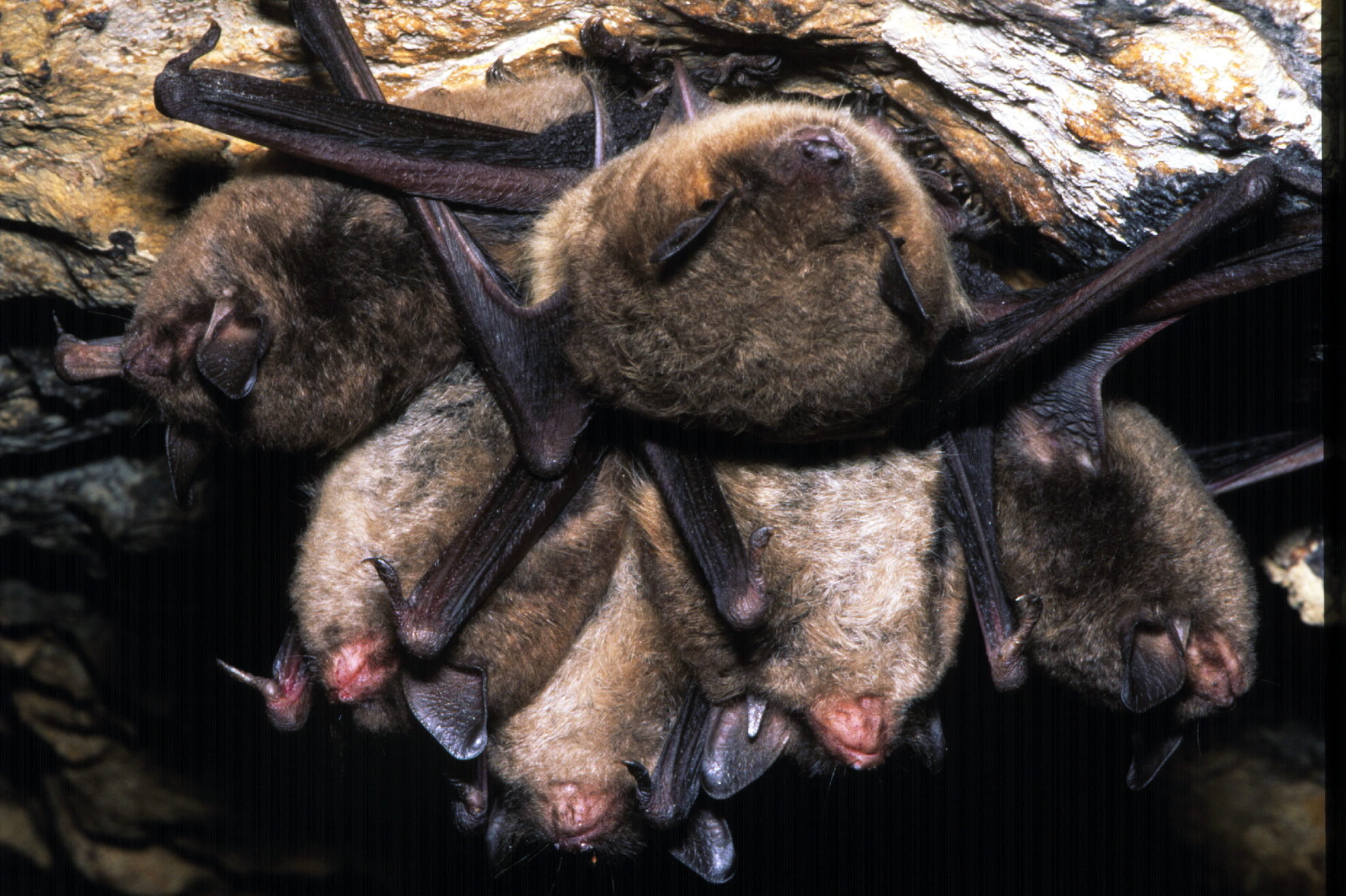
Tennessee
Gray bat, Myotis grisescens
The gray bat is a medium-sized insectivorous bat with an overall length of about 3.5 inches and a wingspan of 10 to 11 inches. The gray bat occurs in limestone karst areas, meaning a landscape marked by caves, sinkholes, springs and other features, of the southeastern and midwestern United States. The gray bat was added to the U.S. list of endangered and threatened wildlife and plants in 1976.
Gray bats are known to live in caves, but recent data shows us that they will roost in culverts, dams, bridges, etc. There is at least one colony in a mine in MO.
Range:
Alabama, Arkansas, Georgia, Illinois, Indiana, Kansas, Kentucky, Mississippi, Missouri, North Carolina, Oklahoma, Ohio, Tennessee, Virginia, West Virginia
Where to see:
Nickajack Cave Wildlife Refuge—Maple View Public Use Area
Conservation approach:
TNC’s conservation efforts have involved:
• Purchasing restoring, and protecting caves that harbor federally endangered gray bats;
• Limiting human access to caves by installing bat-friendly gates to prevent trespassing; and
• Conducting research to help scientists understand the entire gray bat life history and behavior to inform conservation strategies.
Significance for habitat/biodiversity:
During their pregnancy and nursing periods, gray bats consume nearly their own weight nightly in insects. Gray bats deposit some of that energy in the form of guano inside their cave homes, creating a rich environment for life to grow in a habitat with no sunlight or plants.
Learn more:
Popular Science: Inside the World’s First Manmade Batcave Built For Wild Bats
U.S. Fish & Wildlife Service Gray Bat Species Profile
Tennessee Wildlife Resources Agency: Gray Bat Page
Reviewed by Cory Holliday, TNC’s Cave and Karst Program Director in Tennessee.
Photo Credit: TNC
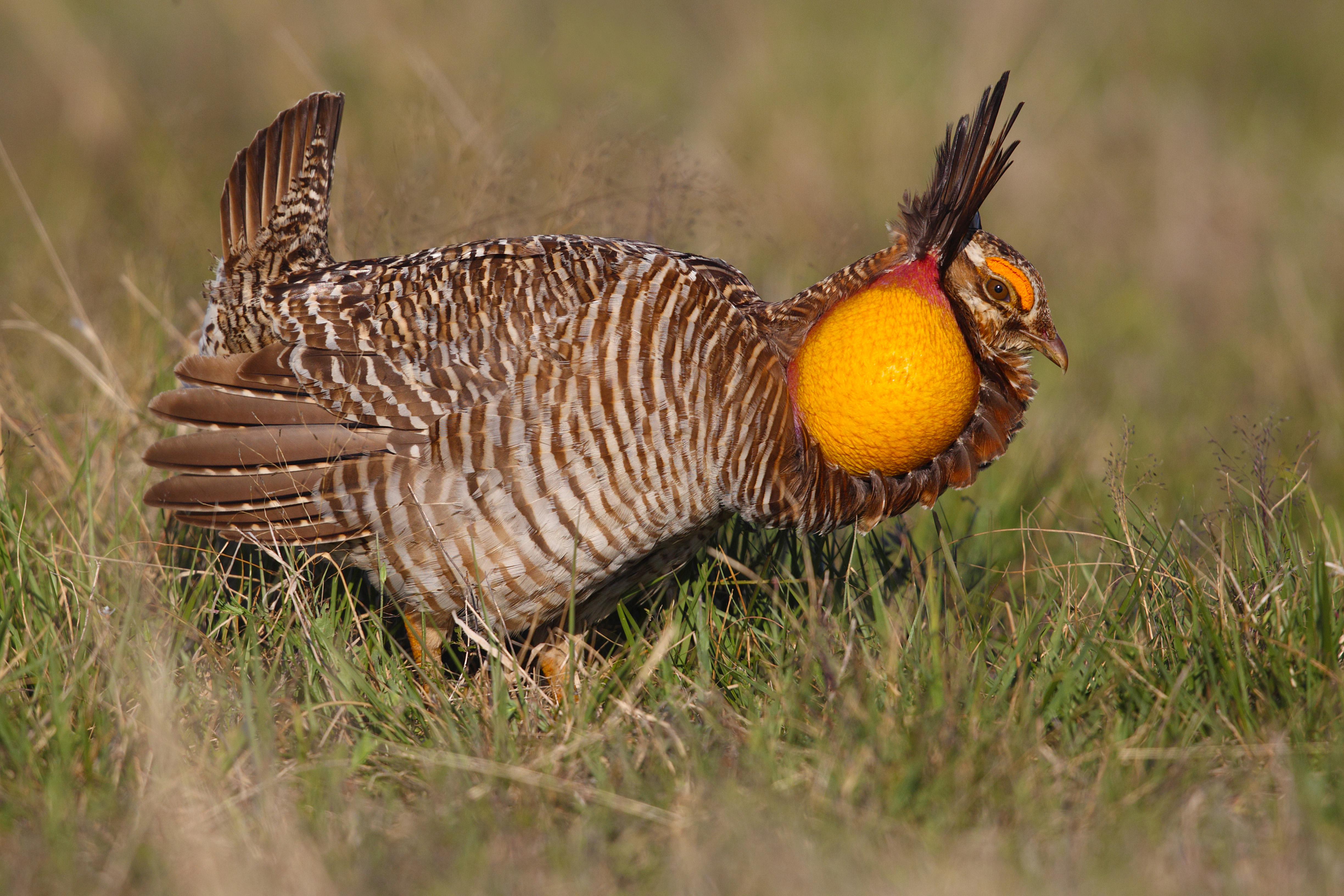
Texas
Attwater’s prairie chicken
Tympanuchus cupido attwateri
This small grouse is a highly endangered subspecies of the greater prairie chicken, native to Texas’ coastal prairies. Males have large orange air sacs on the sides of their necks, which they inflate during mating season to make a loud "booming” sound.
Range:
Historically, the coastal prairies of Texas and Louisiana. Today, only two wild populations exist, both in Texas along the mid and upper Gulf Coast.
Where to see:
Wild populations can be found at TNC’s Refugio-Goliad Prairie Project in Goliad County, Texas and the U.S. Fish and Wildlife Service’s Attwater Prairie Chicken National Wildlife Refuge in Colorado County, Texas.
Conservation approach:
By 1996, habitat loss and development put wild populations of the Attwater’s prairie chicken at fewer than 50 birds. Through collaboration with local landowners, conservation organizations and federal and state agencies, TNC and partners are using sustainable land management and stewardship practices to revitalize and protect prairie chicken habitat. Tools such as rotational grazing, prescribed burns and the removal of invasive species have helped restore the native landscape, creating healthy and resilient grasslands to support these birds. TNC has also facilitated the release of over 1,000 captive-reared Attwater’s prairie chickens on private lands in Goliad County. In 2023, wild populations reached their highest numbers in the past twenty years, demonstrating that captive-reared birds can successfully reproduce in the wild—a key strategy in reestablishing this critically endangered species.
Significance for habitat/biodiversity:
The iconic Attwater’s prairie chicken is an indicator species for Texas’ coastal prairies and marshes; when these prairie chickens can’t make a living on the land, we know that the broader prairie habitat isn’t functioning properly. Ultimately, the diminished health of our grasslands impacts all of the other systems that depend on these lands to thrive—our bays and waterways, our heritage farming and livestock industries and all of the people, plants and wildlife they sustain.
Learn more:
Song of the Prairie: Restoring a Home on the Range for the Attwater’s Prairie Chicken
U.S. Fish and Wildlife Service species profile
Reviewed by Kirk Feuerbacher, TNC’s Working Lands Program Director for the Texas Chapter.
Photo Credit: GaryKramer.net
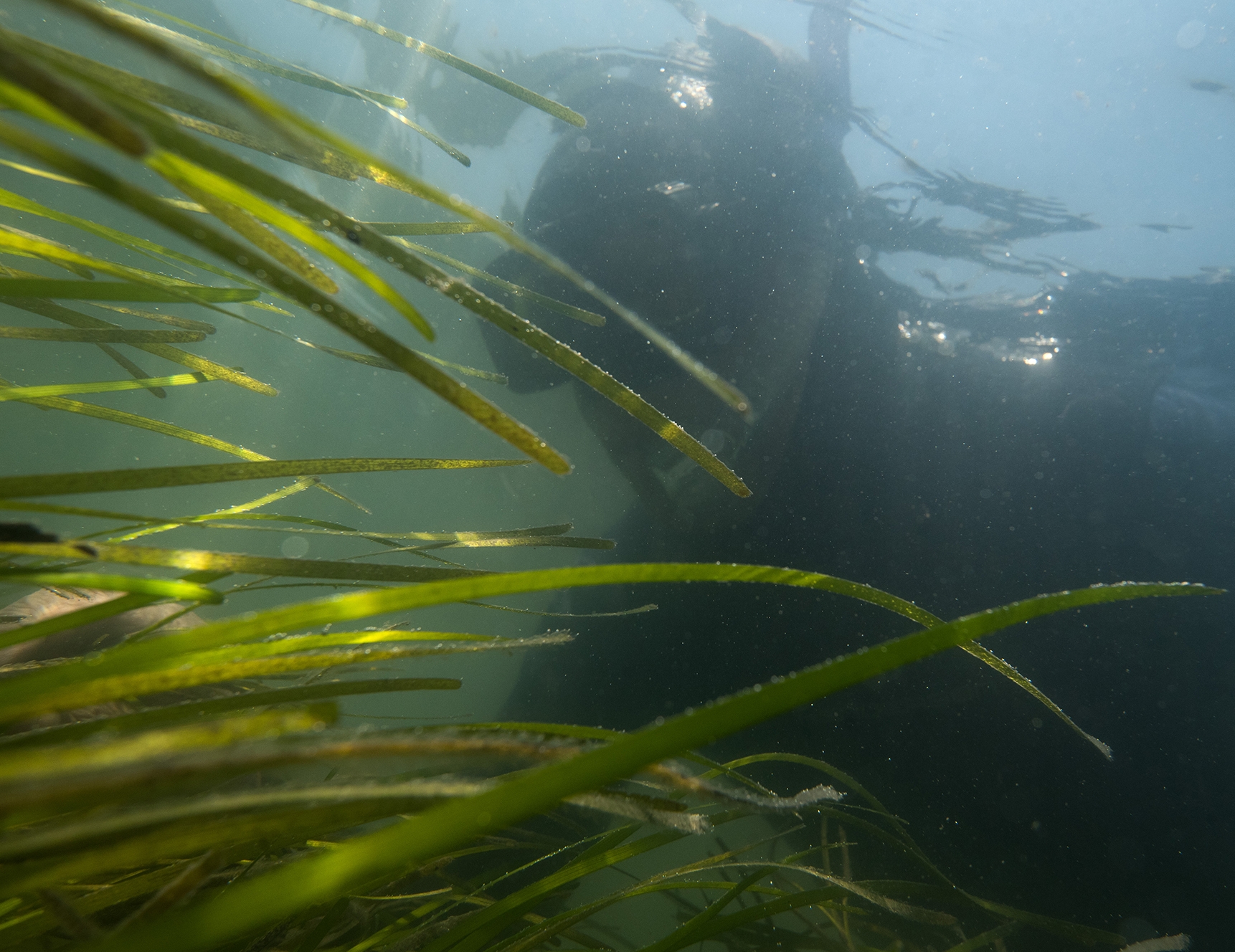
Virginia
Eelgrass, Zostera marina
Rising from shallow bay bottoms, ribbon-like eelgrass leaves may grow to 4 feet, often long enough to float on the surface. Forming vast underwater meadows, eelgrass provides food for waterfowl and green sea turtles; shelter for marine animals such as bay scallops, molting blue crabs, and juvenile fishes; and hunting grounds for gamefish such as striped bass.
Range:
Atlantic coast from North Carolina to Labrador, Canada; Pacific coast from Baja California, Mexico, to Alaska; Mediterranean and Black seas.
Where to see:
Eelgrass grows in shallow waters of the Chesapeake Bay and coastal bays along the seaside of Virginia’s Eastern Shore, where TNC’s Volgenau Virginia Coast Reserve hosts opportunities for volunteers to help restore this foundational marine habitat.
Conservation approach:
Eelgrass virtually disappeared from Virginia’s coastal bays in the 1930s because of disease and a hurricane. But following the discovery of a small patch in a seaside bay off the Eastern Shore, TNC and the Virginia Institute of Marine Science used that seed source to launch restoration efforts. Since 2008, volunteers have helped collect millions of seeds, and eelgrass has regenerated across some 10,000 acres in four bays—the largest seagrass restoration project in the world.
Significance for habitat/biodiversity:
Every 30 minutes, the world loses a football-field-sized area of seagrass meadows. From bay scallops to blue crabs and from seahorses to striped bass, myriad marine animals and waterfowl rely on these habitats for food and shelter. Moreover, research shows that seagrass habitats can play a vital role in bolstering coastal resilience and mitigating climate change.
Learn more:
How You Can Help: Volunteer to Help Restore Eelgrass
Photo Essay: Restoring Eelgrass on Virginia’s Eastern Shore
Seagrass Stories: Barrier Islands Gose Brewed with Eelgrass
Reviewed by Bo Lusk, Coastal Scientist, TNC’s Volgenau Virginia Coast Reserve.
Photo Credit: Jay Fleming
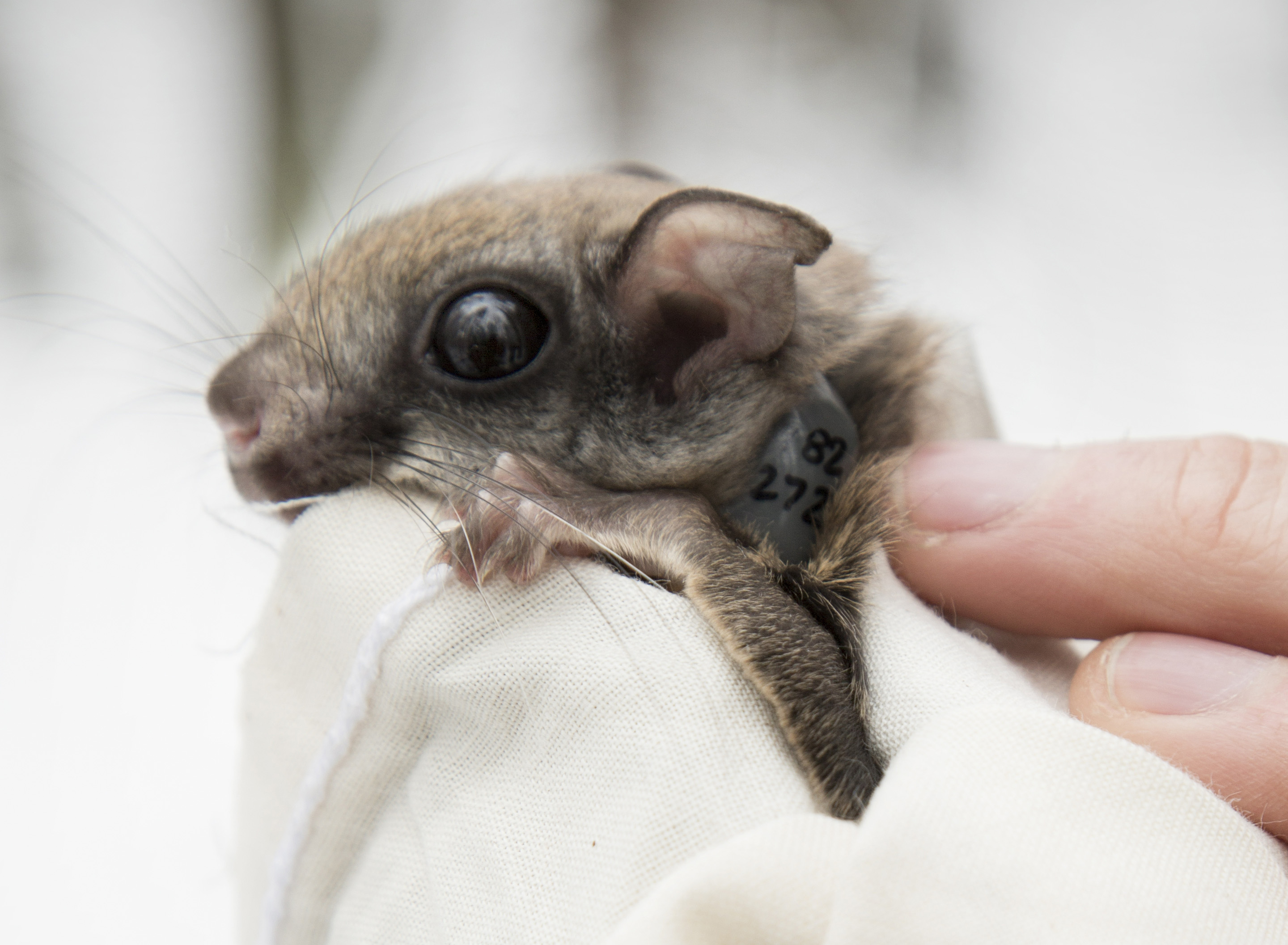
West Virginia
West Virginia northern flying squirrel
Glaucomys sabrinus fuscus
This small flying squirrel weighs a mere 4-6.5 ounces (about as much as a baseball) and is usually less than 1 foot long. Its large eyes aid its nocturnal nature. Mainly nesting in tree cavities, this flying squirrel usually has one litter of two to four young between March and May. Its preferred habitat includes forests with red spruce and old-growth characteristics.
Range:
The range is from the Allegheny Mountains from Grant County, WV, southwest to Greenbrier County, WV, and Highland County, VA. Occurs at elevations above 3,300 feet. The Monongahela National Forest contains more than 90% of the known habitat within its range. A small amount of habitat is in Virginia’s Allegheny Mountain on the George Washington/Jefferson National Forest. The rest of the squirrel’s habitat is located on non-Federal lands.
Where to see:
Mount Porte Crayon Preserve, Slaty Mountain Preserve, Monongahela National Forest, Blackwater Falls State Park, Canaan Valley National Wildlife Refuge, Canaan Valley State Park, Kumbrabow State Forest.
Conservation approach:
Through collaboration of partners in the Central Appalachian Spruce Restoration Initiative (CASRI), the habitat for West Virginia northern flying squirrels have improved, which eventually led to the animal being removed from the U.S. endangered species list. Aiding the flying squirrel’s habitat the initiative has planted nearly 2 million spruce and other species, along with forestry activities to encourage spruce in appropriate areas, and the designation of spruce restoration in the 2004 Monongahela National Forest Land and Resource Management Plan. Additionally, TNC has acquired strategic tracts of land and conservation easements that connect, expand, and enhance the habitat required by flying squirrels.
TNC has identified and focused conservation efforts on several major landscapes and red spruce forests, including the Cheat Mountain Conservation Area, the Canaan Valley/Dolly Sods, Spruce Knob, and the Cranberry Conservation Areas. In addition, TNC has placed restoration and conservation measures by purchasing 57,000 acres of mineral rights on Cheat Mountain and more than 4,000 acres of surface rights in high elevation red spruce/northern hardwood forests transferred to the Monongahela National Forest.
Significance for habitat/biodiversity:
West Virginia northern flying squirrel are an indicator species of high-quality red spruce and red spruce northern habitats along the high Alleghenies in West Virginia and a small portion of Virginia. The squirrel has a symbiotic relationship with truffles that grow underground in that they are the only known animal that disperses their spores. The red spruce forests of West Virginia contain approximately 240 species that the WV Division of Natural Resources tracks as rare, threatened, or endangered. These forests contain headwater streams that flow across the continental divide into both the Chesapeake Bay and Gulf of America while providing flood attenuation and clean drinking water for millions downstream.
Reviewed by Mike Powell, West Virginia Director of Lands.
Photo Credit: Patrick Cavan Brown
Questions About U.S. Conservation
-
Wildlife face many threats in the U.S. Many of these threats are the same facing wildlife in other parts of the world.
Here are some of the biggest threats facing biodiversity right now:
Climate change: Humans are feeling the impacts of climate change, and so is wildlife. Many species try to adapt by shifting their ranges: moving north and to higher elevation. But habitat fragmentation from human development makes movement more difficult. Some species can’t move because they’ve evolved within specific ecosystems, and they’re replaced with generalist species or driven to extinction. And some species, like ticks, are expanding their ranges and spreading diseases to new areas.
Climate change affects marine species as well as terrestrial species. Rising ocean temperatures threaten marine ecosystems like coral reefs, causing a loss of marine biodiversity and fisheries losses.
Habitat loss: There are many different types of habitat loss, each of which threaten wildlife. Some examples of habitat loss are deforestation, agriculture, mining and urbanization.
Habitat loss also includes degradation, such as from pollution, and fragmentation, such as roads through habitat or dams in streams.
Invasive species: Invasive species outcompete local and indigenous species for resources, causing declines in native biodiversity. Invasive species can also spread diseases that native species haven’t evolved to withstand and fuel devastating wildfires that destroy important wildlife habitat.
Pollution: Human activities cause a wide range of pollution in our environment, all of which threaten wildlife on land and in freshwater and marine ecosystems.
Here are just a few examples of pollution sources in the U.S.:
- Air pollution: We know that air pollution causes health problems in people, and it’s also damaging for wildlife. Burning fossil fuels is a main cause of air pollution in the U.S.
- Land pollution: Nitrogen pollution (often in the form of nutrient runoff from agriculture) has downstream effects on freshwater and marine wildlife, including dead zones and toxic algae. Pollution also comes in the form of plastic, industrial and household waste.
- Water pollution: Pollution often starts on land and ends up in water systems, harming freshwater and marine wildlife. Plastic and discarded fishing gear are two examples. Other pollution goes right into our waterways, such as waste from our modern sewage systems and stormwater pollution.
-
There are a variety of ways you can help wildlife near you and around the country! Here are just a few:
- Support conservation laws in your state and contact your elected officials
- Plant native plants: Turn your yard into a wildlife haven (and reduce your use of pesticides)
- Reduce your single-use plastic consumption: Plastic is a major pollutant of our oceans and risk to marine species
- Visit local preserves: Be sure to obey leash laws, stay on designated trails, and practice leave no trace
- Reduce the spread of invasive species: Clean your shoes and tires (and boats!) before and after traveling, buy local firewood, and ensure the plants you buy are not invasive
- Volunteer and attend events with The Nature Conservancy or other local conservation groups
-
The Endangered Species Act (ESA) is a U.S. law that creates protections for fish, wildlife and plants that are endangered or threatened with extinction. The ESA created guidelines for adding species to the list, removing species from the list, creating recovery plans, and funding conservation efforts. Its goal is to prevent extinction for species and their habitats.
The Endangered Species Act was passed in 1973 after many iconic species suffered declines. Since then, it has played a role in the comebacks of many iconic species.
The Endangered Species Act isn’t perfect, and threats to biodiversity remain enormously challenging. Many actions are needed to deliver the right policies, funding, and science, along with solutions for the tandem crisis of climate change.
-
The Recovering America’s Wildlife Act (RAWA) is a bipartisan bill that would help recover wildlife listed as threatened or endangered under the Endangered Species Act or state law, as well as preventing species from becoming endangered. RAWA will invest $1.397 billion per year in financial and technical assistance to state and Tribal efforts to help wildlife and local communities.
More than a third of America’s fish and wildlife species are at risk of extinction. States and Tribes have a long track record of success in helping recover species before they require the far more costly “emergency room” intervention of the Endangered Species Act. This conservation work also has multiple benefits for local communities, including job growth, cleaner water, and more outdoor recreation opportunities.
RAWA will fund on-the-ground conservation efforts of these species such as conserving and restoring habitats, fighting invasive species, reintroducing native species and tackling emerging diseases. Some of the funding will come from revenues from fees and fines for environmental requirement violations.

Nature Needs Your Support
Receive monthly conservation updates and opportunities in your state or country.
Environmental Policy News

The U.S. Foundation for International Conservation Act would Protect Wildlife, Lands and Waters Around the World
The proposed legislation would establish a fund that would use U.S. government, private sector and philanthropic funding to support conservation, wildlife and Indigenous Peoples around the world.

Biodiversity Action Guide
There’s no shortage of strategies available to create a nature-positive planet now—our downloadable guide shows how to translate ambition into action.

We Must Restore Nature This Decade—Here's How
It will take the restoration of hearts and minds across sectors to save ecosystems, and the communities that depend on them.